Protect Your Trip »
14 top vacation destinations in the french alps.
Explore an array of options for your next family ski vacation or a romantic wine retreat.

14 Top Destinations in the French Alps

Getty Images
Experience the French Alps by hiking in national parks, skiing at top resorts, exploring mountain villages and more.
The Alps are the largest mountain chain in Europe – and one of the longest and highest mountain ranges in the world. Their majesty stretches for more than 700 miles across eight countries, with the highest peak, Mont Blanc, sitting near France's border with both Italy and Switzerland . Combined with its proximity to Lake Geneva , the French portion of the Alps offers some of the most picturesque ski resorts, alpine villages and vacation opportunities in the world.
Skiing, while not required to enjoy your visit, is a huge part of the French Alps culture – as is the après-ski (literally "after-ski"), which is what happens when the skis come off. In the summer, it's all about the Tour de France, an annual men's cycling competition that passes through the Alps. Travelers can soak in natural hot springs to unwind after a day spent hitting the slopes, exploring by cable car or doing nothing at all. Strap on your skis and pack your hiking boots for these top destinations in the postcard-worthy French Alps, one of the best places to visit in France .
(Note: Some of the following activities, attractions and locations may be affected by the COVID-19 pandemic. New policies may be in place, including capacity restrictions, reservation requirements or mask mandates. Check with the Centers for Disease Control and Prevention, the U.S. Department of State and local tourism boards before traveling.)

Chamonix-Mont-Blanc

The first Winter Olympics were held in 1924 in Chamonix-Mont-Blanc. The town, more commonly referred to as Chamonix, sits in the heart of France's Haute-Savoie department, a subdivision of the Auvergne-Rhône-Alpes region (like how the U.S. has counties within states). A century after those incipient Olympic Games, this scenic area in southeastern France – bordering Italy and Switzerland – continues to welcome visitors from around the world to take part in its premiere skiing and snow-gazing opportunities. You'll find the country's highest cable car in Chamonix at the Aigulle du Midi mountain. Advanced skiers and those simply brave enough to take the journey will venture more than 12,600 feet into the sky to the starting point for the Vallée Blanche. This "off-piste" area of the French Alps – where the snow is not specially prepared for skiing – offers up glacial skiing and celestial vantage points from the foot of the Mont Blanc massif mountain range.
For those more comfortable on rails rather than skis, book a ride on the Montenvers-Mer de Glace train. This cherry-red cogwheel train carries passengers from Chamonix to Montenvers for access to the Mer de Glace (Sea of Ice), the biggest glacier in France. Visitors will have the opportunity to visit an ice cave in the glacier and learn more about both its history and future amid climate change. When you're done exploring, warm up with a traditional meal at the Refuge du Montenvers restaurant before heading back to Chamonix.
Aix-les-Bains

Set on the eastern shore of Lac du Bourget – France's largest natural lake – Aix-les-Bains is an inviting Savoy resort town in the Auvergne-Rhône-Alpes region. It once hosted the summer escapades of royalty, along with American author Mark Twain. The glacial waters of the Lac du Bourget set a relaxed ambiance, easily discovered by strolling the Esplanade du Lac, a lakeside park and walkway shaded by trees. The rugged mountain landscape can be glimpsed across the lake as well as the Hautecombe Abbey, a former monastery where many members of the House of Savoy are buried. Mont Revard is a prime example of the limestone cliffs found in Aix-les-Bains. The ski station at the top boasts an impressive network of cross-country ski trails for winter visitors, while in summer skilled cyclists attempt the ascent – including the competitors of the Tour de France, which has been held here numerous times. Visitors claim the views are stupendous, even if you arrive by car.
If you seek a more low-key vacation in Aix-les-Bains, while away the days at the Musée Faure, an art museum, featuring the works of Rodin and impressionist paintings, or take a daylong soak in the restorative waters of the spa town's thermal baths. Those who appreciate architectural aesthetics will be in awe of the Roman ruins here, like the Temple of Diana, found alongside belle epoque structures including the Casino Grand Cercle and the hotel Le Mirabeau.
Alpe d'Huez

At more than 6,000 feet above sea level, Alpe d'Huez is a year-round resort town in the French Alps. Its Pic Blanc glacier reaches nearly 11,000 feet and is accessible in winter or summer. Alpe d'Huez has earned the nickname "Island of the Sun" for its abundant days of sunshine on the slopes, which warm skiers and snowboarders of all ages and abilities.
You may start your stay by marveling at the Grotte du Glace, an ice cave at the top of one of the ski lifts that features sculptures. The lifts continue to operate even in July and August for hikers and mountain bikers looking to take advantage of 21 thrilling hairpin bends regularly employed in the Tour de France. The lifts also grant access to the smaller Alpine villages of Vaujany and Oz en Oisans from Alpe d'Huez. While most local restaurants in town are known for cream- and cheese-based cuisine, the newly renovated Le Génépi serves a menu of plates made with fresh, local ingredients. Recent patrons call the restaurant a much-needed infusion of culinary excellence in this French Alps town with its unique dishes and scenic views from the terrace.
Chablais UNESCO Global Geopark
The mountainous area known as the Chablais UNESCO Global Geopark is set on the France-Switzerland border and spans more than 60 French towns. The Chablais' name means "head of the lake," referring to Lake Geneva. The UNESCO recognition acknowledges the area's millions of years of geological history alongside cultural heritage such as local cheese- and wine-making practices. The Chablais was designated a "geopark" to highlight the bond between people and nature here, something evident throughout the French Alps given the emphasis on water and natural springs. UNESCO offers a tourist map online that showcases some of the many places to visit throughout the Chablais – abbeys, castles, museums and more. Visitors to the Musée de la Musique Mécanique (Mechanical Music Museum) in Les Gets were surprised by the abundant instruments it displays, with plenty of quirky and antique contraptions to spend an hour ogling.
Évian-les-Bains

Within the Chablais UNESCO Global Geopark, Évian-les-Bains is widely known for its mineral springs – you may also recognize it as the namesake for a popular water bottle company – but this quintessential French spa town quenches a thirst for beauty as well as water. Located on the southern shore of Lake Geneva, Évian-les-Bains was a favorite of the Lumière family: the very same Lumières credited with helping invent modern cinema. Villa Lumière was the family's summer residence, and self-guided tours of the now-hotel are allowed on weekdays. The Palais Lumière, which constituted the formal thermal baths during the early 20th century, houses cultural and art exhibitions today. The neoclassical-style theater, dating to 1883, was created by a student of Charles Garnier, the architect who built the Opéra Garnier in Paris .
The Pré Curieux water gardens in Évian-les-Bains, meanwhile, are a unique lakeside habitat used for research but open to guests who come by solar-powered boat with a guide from May through October. If you seek something to do around the winter holidays instead, check out Le Fabuleux Village des Flottins, a festival of magical creatures created out of driftwood from the shores of Lake Geneva and elevated with light displays. Past participants rave that the flottin sculptures are unusual and breathtaking – and advise not to miss the stalls of "vin chaud" (hot mulled wine) and pancakes along the parade route. Whenever you visit this quaint French Alps destination, don't miss a Michelin-starred meal at the restaurant Les Fresques.

Courchevel is a skiing enthusiast's dream, with one resort spread across six villages near Vanoise National Park, a nature preserve that was France's first national park . This French Alps ski resort is part of Les Trois Vallées (the Three Valleys), which is the largest linked ski area in the world. There are more than 100 ski runs – and plenty of moguls for snowboarders and snowmobilers – across a variety of experience levels. Skiers who prefer abundant off-piste territory should give nearby resort Val Thorens a try. Méribel, meanwhile, another ski resort in Les Trois Vallées that neighbors Courchevel, caters to families. Part of the appeal of ski culture is the offerings when you're done with the slopes; après-ski at Courchevel includes the bustling Le Tremplin restaurant and the Copiña Courchevel bar, where tapas, beer, wine and cocktails are served in a sleek setting. Guests say the friendly staff, delicious drinks and upbeat atmosphere – sometimes with live music – made them return to Copiña Courchevel again and again.
Serre Chevalier

Within France's Haute-Alpes department are four communes (the French equivalent of towns) that make up the Serre Chevalier valley and ski resort, where sunshine is plentiful throughout the year. In the valley of the Guisane river, between the Cerces mountain range and Écrins National Park, you'll find the commune of Le Monêtier-les-Bains, a former Roman city complete with thermal baths that today are open from May to December. Spagoers at Les Grands Bains du Monêtier note that the facilities can get crowded but a soak is a must, especially after a day spent skiing or hiking.
Another commune, Briançon, serves as a UNESCO World Heritage Site with plenty of history to explore; it's also one of the highest towns in Europe at an altitude of more than 4,300 feet. At the summit of Serre Chevalier, take in a panorama of Écrins from 3,600 feet up on your way down the summertime zip line. If you have younger family members in tow, kids aged 4 to 12 can make use of the valley's high-altitude wooden playground called Marmot Camp, named for the squirrel-like alpine marmot.
Val d'Isère

Festivals keep things lively year-round at Val d'Isère, a French ski resort town near the Italian border. In the summer, sporting and cultural events like races and festivals entertain locals and travelers alike. Val d'Isère is one of the top hosts of FIS Alpine Ski World Cup competitions, and it's famed for high-difficulty and off-piste skiing. But you don't have to know what you're doing to enjoy the skiing here, which visitors call seamless and user-friendly, with plenty of instructors for all levels of ability and reasonably priced lift tickets. The Alpine resort town also prides itself on its après-ski scene: The stunning Bar de l'Ouillette, for example, serves crepes lakeside. Les 3 Caves – comprising three locations at La Folie Douce – boasts a high-altitude wine cellar, a cave for cheese and one for cigars.
Saint-Gervais-les-Bains

About 40 miles from Geneva, Switzerland , sits Saint-Gervais-les-Bains, a small French town that makes a pleasant jumping-off point for daytrips to Chamonix or longer sojourns to the Swiss city of Lausanne or Turin, Italy. Saint-Gervais, surrounded by Mont Blanc among other towering peaks, is also a top French Alps destination in its own right, with bountiful eateries and plenty of mountain air to inhale. Take a 70-minute ride on the Mont Blanc tramway for scenic views; a 30-minute walk from the top gets you to the Bionnassay Glacier. You can also head to the cable car on the western part of Saint-Gervais to ascend to Le Bettex, a small village in the mountains. Stop here to dine at La Flèche d'Or, a hotel and restaurant serving traditional Savoie dishes with local produce, then continue in the cable car to Mont d'Arbois for the best views. Back in Saint-Gervais, Les Bains du Mont Blanc is a world-class thermal spa making use of the region's naturally warm water.
Mercantour National Park

Provence-Alpes-Côte d'Azur, the most southeastern region of France, houses the iconic French Riviera (Côte d'Azur) alongside a stretch of the Alps. Spread across the region's Alpes-Maritimes and Alpes-de-Haute-Provence departments is Mercantour National Park, about 30 miles from Nice . Multiple valleys, including the Ubaye Valley, are part of this more than 250-square-mile national park, which is home to more than 2,000 species of flowering plants as well as thousands of petroglyphs from the Bronze Age. Park trails covering nearly 400 miles will expose you to the biodiversity of this unspoiled natural haven in the southern French Alps. Tourists may enjoy kayaking the turquoise waters of the Verdon River through the Verdon Gorge or hiking around the rim of the canyon. The wild and unspoiled Ubaye Valley draws outdoor enthusiasts, who find their way to its town of Barcelonnette to hike, canoe and ski.

Grenoble, France, is the European Green Capital for 2022, meaning this destination is an eco-friendly option for a French Alps vacation. The mountains and the metropolitan city work in harmony, offering visitors the restaurants and accommodations of a big city along with the natural sights of protected environments like the nearby Chartreuse Regional Nature Park. Speaking of green, the Grande Chartreuse monastery – situated in the Chartreuse mountain range north of Grenoble – is the home of the Carthusian monks who safekeep the secret recipe of green chartreuse liqueur to this day. The monastery isn't open to the public, but you can visit the nearby Grand Chartreuse museum to learn more about the Carthusian Order.
The Belledonne mountain range, meanwhile, is known for breathtaking vistas, including swirling sunsets. Beyond biking, hiking and skiing, thrill-seekers can paraglide here or take it slow in the winter with snowshoeing. In the city itself, La Bastille is a fort at the center of Grenoble, perfect for an afternoon spent above the city – a cable car will take you there, or you can hike to the top. About 10 miles south of Grenoble, the French-style gardens and chateau of Domaine de Vizille are so elegant you might not expect the Museum of the French Revolution is housed here, but art and artifacts combine in the castle's galleries to walk you through that historical period. Kids will love spotting the swans, ducks, deer and other animals that roam freely on the protected grounds.

Wine and cheese – some of the best you've ever tasted – are abundant throughout France. And according to La Clusaz, a commune roughly 40 miles west of Chamonix in the Auvergne-Rhône-Alpes region, these French staples are something to be celebrated. The annual Fête du Reblochon (Reblochon Festival) exalts cheese and the local farmers who produce it with demonstrations, tastings, a parade, and plenty of folk dancing and merriment. Aside from cheese, chocolate truffles, white vermouth and certain wine varietals are all local specialties.
Recent visitors to La Clusaz call it a lovely little ski town with ample restaurants and cozy bars to keep refreshed. If you want to burn off some calories du fromage, head to Col des Aravis for hiking trails with iconic French Alps views: the white-capped Mont Blanc, pine trees, mountain flowers, a glacial lake and even a tiny chapel. Adventure lovers visiting La Clusaz may want to try out equestrian skijoring, which is the sport of being pulled by a horse through the snow on skis – not for the faint of heart.

Megève has been the stage city for the Tour de France only twice, but its elegant atmosphere makes it a sensible choice for hosting events that draw crowds from across the country – and the globe – including the annual equestrian Jumping International de Megève. When there is not a prestigious sporting event in town, tourists in Megève can still find world-class dining and shopping. For example, chef Anne-Sophie Pic, the most Michelin-starred woman in the world, helms La Dame de Pic – Le 1920, the restaurant at the Four Seasons Hotel Megève. The village shops span antique furniture to local produce to popular fashion brands. When you need a rest from shopping, stop in for tea by day and Champagne in the evening at Le Georges in the luxe Hotel Mont Blanc. A variety of child and teen programming in Megève invites the whole family to vacation, with a variety of sports courses and cultural workshops.

Often considered one of France's most beautiful villages, Yvoire is part of the Chablais UNESCO Global Geopark area for good reason, considering its 700 years of history and present-day charm. Like so many classic French Alps towns, Yvoire is nestled on the shores of Lake Geneva; its nickname is "gem of the lake." Built in 1306, Château d'Yvoire (Yvoire Castle) is a landmark in the medieval town that remains standing today; while not open to the public, it makes for an impressive photograph. On the other hand, the Jardin des Cinq Sens (Garden of the Five Senses) entices sightseers with gardens to explore through touch and smell. Visitors to the gardens mention that it is tucked away, but once you find it your senses will thank you. This romantic destination in the French Alps reserves its streets for pedestrians, so you can stroll hand in hand to your heart's content. What's more, flowers are so plentiful in Yvoire that it is often called the "French flower village."
You might also be interested in:
- The Best Hotels in Europe
- The Best Castle Hotels in Europe
- Romantic Hotels Worth a Stay
- The Most Scenic Mountain Resorts
- The Best Travel Insurance for Europe
Tags: Travel , Europe Vacations , Mountain Vacations , Skiing
World's Best Places To Visit
- # 1 South Island, New Zealand
- # 4 Bora Bora
If you make a purchase from our site, we may earn a commission. This does not affect the quality or independence of our editorial content.
You May Also Like
The best stonehenge tours.
Kim Foley MacKinnon and Ann Henson Sept. 18, 2024

Best Grand Canyon Helicopter Tours
Holly Johnson and Ann Henson Sept. 17, 2024

The Best Eiffel Tower Tours
Kristy Alpert Sept. 17, 2024

Fun Things to Do in Ohio
Gwen Pratesi and Heather Rader Sept. 17, 2024

The Top River Cruise Lines
Nicola Wood and Brittany Chrusciel Sept. 17, 2024

The 27 Most Haunted Hotels in America
Alissa Grisler Sept. 16, 2024

Top Indoor Water Park Resorts
Holly Johnson and Amanda Norcross Sept. 16, 2024

Adults-Only All-Inclusive Mexico Resorts
Sept. 13, 2024

Romantic Getaways in Texas
Marisa Méndez Sept. 13, 2024

The Best NYC Food Tours
Ann Henson Sept. 12, 2024

- Sites and Monuments in Paris
- Sites and Monuments in France
- Things to do in Paris
- Things to do in France
- ACCOMMODATION
- RENTING A CAR
- CHEF SERVICE
- CONCIERGERIE SERVICES
- TRAVEL TIPS
- TRAVEL LUGGAGE
- Arrondissements
- Monuments & Landmarks
- Secret & Offbeat Paris
- More about Paris...
- Île de France
- More Regions of France...
- Aix-en-Provence
- More Cities...
- Castles and Palaces
- Cathedrals and Churches
- Gardens and Parks
- World Heritage Sites
- Villages of France
- Autumn / Fall
- Mardi-Gras / Carnival
- April Fools' Day
- Bastille Day
- All Saints' Day
- More Holidays and Celebrations...
- National Anthem
- Gallic Rooster
- National Day
- Motto of France
- Motto of Paris
- Coat of Arms
- French President
- Le Croissant
- French Cheese
- French Wines
- Christmas Food and Recipes
- French Nursery Rhymes
- France geography
- FUN QUIZZES
- MOVIES AND MUSIC
- FRENCH LANGUAGE
- BOOKS BY FRENCH MOMENTS
- BOOK RECOMMENDATIONS
- The Secrets of the Eiffel Tower
- The Gems of Paris
- Office desks and chairs
- Travel suitcases
- LEARN FRENCH WITH PIERRE
- THE STORY SO FAR
- WORK WITH US
- THE NEWSLETTER
- HOW TO SUPPORT US
- PHOTO USAGE POLICY
The French Alps: A Mini Discovery Guide
Last Updated: 24 July 2024
Walking underneath dramatic glaciers and snow-capped peaks, strolling in picture-perfect old towns and villages, tasting delicious mountain cheese while relaxing on the shores of alpine lakes—the French Alps have much to offer visitors.
Although crowded in winter , this part of France is often bypassed by English-speaking tourists in summer who traditionally prefer popular destinations such as Paris, Provence, the South-West and the Loire. Nevertheless, the true beauty of the mountains, with their inspiring and spectacular settings, make them an excellent reason to visit the area. Extending from Lake Geneva to the Mediterranean Sea in Nice , the French Alps show a diversity of landscapes, traditions and gastronomy, as well as various cultural and sports activities.
On 24 July 2024, just days before the Summer Olympics opening ceremony in Paris, the 142nd IOC session elected the French Alps 2030 as the host region for the XXVI Olympic Winter Games . This marks the fourth time the Winter Olympics will be held in France, the first in 38 years since Albertville 1992.
The sports events will be organised across four different hubs, ranging from Lake Geneva to the northern Alps and down to the Mediterranean Sea in the south, to utilise as many existing venues as possible. However, this selection was made “under conditions” given the current political situation in France.
Indeed, the dissolution of the National Assembly and the absence of a fully functioning government prevented France from providing the required guarantees for the bid. Consequently, the IOC awarded the Games “under conditions” that the financial guarantee must be approved by Parliament by March 2025.
Description of the French Alps
Limits of the french alps.
The French Alps extend 180km from Lake Geneva on the Swiss border in the north to Nice and the Italian border in the south. Switzerland and Italy border its eastern side.
Two administrative regions share the vast mountain territory:
- Auvergne Rhône-Alpes to the north and,
- Provence-Alpes-Côte d’Azur (PACA) to the South.
The French Alps are included partly or wholly in eight départements:
- Haute-Savoie (74, Annecy ),
- Savoie (73, Chambéry),
- Isère (38, Grenoble),
- Hautes-Alpes (05, Gap),
- Alpes-de-Haute-Provence (04, Digne-les-Bains),
- Alpes Maritimes (06, Nice),
- Drôme (26, Valence), and
- Var (83, Toulon).
This vast mountainous area comprises many historic provinces: Savoie , Dauphiné , Provence , and the County of Nice .
The Alps in general
The French Alps are part of the greater mountain range of the Alps, which stretch in a crescent shape 1,200 kilometres (700 miles) from Nice to Vienna across seven countries: Austria, Slovenia, Italy, Switzerland, Liechtenstein, Germany, and France.
The highest mountain of the Alps is Mont Blanc (4,810m), situated on the French-Italian border. From the Danube to the Mediterranean Sea, 82 summits reach an altitude of at least 4,000 metres (48 in Switzerland, 38 in Italy, and 24 in France).
Alpine mountain passes
The prestigious Tour de France bicycle race regularly climbs many mountain passes linking valleys or countries with altitudes greater than 1,000 metres.
Alpine passes played a great part in the mountain’s history, from the Roman era to the Middle Ages and from the Napoleonic Wars to World War Two.
Find out more about the great mountain road passes of the French Alps.
The Alps: Europe’s Reservoir
The Alps are known as Europe’s Reservoir thanks to the great rivers that rise from their glaciers: the Rhine , the Rhône , the Po , the Inn , the Ticino , and the Adige .
In France, the great rivers of the Alps are the Rhône , the Arve , the Isère , the Arc , the Romanche , the Drac , the Drôme , the Durance , the Verdon , the Var and the Vésubie .
The French Alps include some of France’s most beautiful lakes , for instance:
Lake Annecy , Lake Bourget, Lake Geneva, Lake Aiguebelette, Lac du Sautet, Lac de Serre-Ponçon, Lac du Chevril, Lac du Mont-Cenis, Lac de Castillon, Lac de Sainte-Croix, Lac d’Esparron…
And a multitude of small lakes found in protected areas:
Lac Lauvitel, Lac de l’Eychauda, Lac du Combeynot (Écrins), Lac des Vaches, Lac Long, Lac Blanc, Lac des Assiettes ( Vanoise ), Lac des 9 couleurs (Queyras), Lac Vert, Lac Noir, Lac du Basto, Lac d’Enfer (Mercantour)…
Main glaciers
The glaciers of the French Alps are found in four main massifs: Mont Blanc , Vanoise , Grandes Rousses, and Écrins. They cover a total area of 350 km2 , and the snow line on the glaciers lies between 2,750m and 2,950m.
Mont Blanc has the only continuous glacier area in France and accounts for a third of the total glacier area in the French Alps. It includes the well-known Mer de Glace, which is the largest glacier in the country (30 km2).
Main cities
Although the highest mountain range in France, the Alps are home to large cities due to the deep and large valleys that separate its different massifs. The French capital of the Alps is Grenoble , a dynamic economic and university centre of 450,000 inhabitants that hosted the 1968 Winter Olympic Games.
In addition, there are other important cities such as Annecy, Chambéry, Gap, Briançon, Aix-les-Bains, Cluses, Thonon-les-Bains, and Albertville.
Overall, the Alps cover a large area and are densely populated in large valleys. 14 million people live in the mountainous region, which is home to cities such as Innsbruck (Austria), Bolzano (Italy), Chur (Switzerland), Grenoble (France), and Aosta (Italy).
In France, the densely populated “ Alpine Furrow ” (Sillon alpin) is an axis stretching over 330 km from Geneva to Valence, passing through Annecy , Aix-les-Bains , Chambéry and Grenoble.
👉 Explore the incredible French Alps for less with Ski France voucher codes . Book online for the best savings whether you want to stay in the beautiful Chambery or a top-class L’Alpe d’Huez resort.
Protected areas in the French Alps
The French Alps attract many visitors who come to discover one of its many protected areas. The mountain range includes National Parks, Regional Natural Parks, and Natural Reserves .
National Parks
As of 2014, three of the 10 National Parks in France are located in the French Alps.
Vanoise National Park (Parc national de la Vanoise)
Situated in the département of Savoie , the park protects an area of 1,250 km2 (483 sq mi). It was the first National park created in France (6th July 1963).
Écrins National Park (Parc National des Écrins)
The park, which was created on March 27, 1973, covers parts of the départements of Isère and Hautes-Alpes and protects an area of 918 km2 (354 sq mi).
Mercantour National Park (Parc national du Mercantour)
In between the départements of Alpes-Maritimes and Alpes-de-Haute-Provence, the park protects an area of 685 km2 (264 sq mi). It was created on the 18th of August, 1979.
Regional Natural Parks
A Parc Naturel Régional (or PNR) covers a rural area of outstanding beauty to protect its scenery and heritage and enforce sustainable economic development. As of 2014, seven of the 49 PNRs in France are located in the French Alps.
Vercors Regional Natural Park (Parc naturel régional du Vercors)
The park, which was created on October 16, 1970, is situated in the départements of Drôme and Isère and protects an area of 2,063 km2.
Luberon Regional Natural Park (Parc naturel régional du Luberon)
Covering the fringe of the Alps in the départements of Alpes-de-Haute-Provence and Vaucluse, the park protects an area of 1,747 km2. It was created on the 31st of January, 1977.
Queyras Regional Natural Park (Parc naturel régional du Queyras)
Included in the département of Hautes-Alpes, the park protects an area of 603 km2. It was created on the 31st January 1977.
Chartreuse Regional Natural Park (Parc naturel régional de la Chartreuse)
Situated in the départements of Savoie and Isère, the park protects an area of 767 km2. It was created on the 6th May 1995.
Bauges Regional Natural Park (Parc naturel régional du Massif des Bauges)
In-between the départements of Savoie and Haute-Savoie , the park protects an area of 900 km2. It was created on the 7th December 1995.
Verdon Regional Natural Park (Parc naturel régional du Verdon)
Situated in the départements of Alpes-de-Haute-Provence and Var, the park protects an area of 1,770km2. It was created on the 3rd March 1997.
Prealps of Azur Regional Natural Park (Parc naturel régional des Préalpes d’Azur)
Covering parts of the département of Alpes-Maritimes, the park protects an area of 889 km2. It was created on the 30th of March, 2012.
Natural Reserves
Nature Reserves are outstanding protected areas created by the State for endangered plants and vertebrates (fish, reptiles, birds, mammals…).
The French Alps amount to many spread throughout the range, with some protecting well-known sites, for instance:
- Aiguilles Rouges,
- Bout du lac d’Annecy ,
- Cirque du grand lac des Estaris,
- Contamines-Montjoie,
- Roc de Chère (Lake Annecy),
- Sixt-Passy,
- Tignes-Champagny,
- Sainte-Victoire (Provence)
Human activities in the French Alps
Traditionally, the French Alps have relied on forestry and cattle farming . More recently, hydroelectric power, technological industries, and particularly tourism activities have threatened this fragile mountain environment.
The coniferous forests of the Alps are exploited for pulp, lumber and wood furniture. They are often found on the north-facing slopes, whereas the sunnier south-facing slopes are covered with fields and pastures.
More recently, an intensive reforestation programme has been undertaken, and it is estimated that forests now cover more than a third of all usable land.
Cows and sheep
Two main breeds of alpine cows produce gruyère-type cheese: the Tarine and the Abondance. The ringing of the bells attached to their necks is one of the typical sounds heard on a walk in the Alps.
In addition, there are countless mountain sheep in the southern Alps in Provence.
Each spring, the cows and sheep leave the farms to reach the high pastures, where they stay for the whole duration of summer. This is called the transhumance and can be a popular public celebration (such as in Annecy for cows and Saint-Remy-de-Provence for sheep).
Hydroelectric power
Since the 1950s, enormous reservoirs and dams have been built to use the formidable hydroelectric power from the alpine rivers. Several man-made lakes were created in flooded valleys and villages: Chevril, Roselend, Mont-Cenis, Chambon, Serre-Ponçon, and Sainte-Croix.
Technological industries
Grenoble has become a significant European scientific centre in physics, computer science, and applied mathematics. The self-proclaimed ‘ Capital of the Alps ’ is one of the leading European cities in high-tech industries, especially biotechnology and nanotechnology.
A combination of research and industry known as the ‘ Grenoble model ‘ was implemented as early as 1955 with the creation of the Grenoble Center for Nuclear Studies (CENG).
Other technological centres in the French Alps are found in Haute-Savoie and Savoie.
Thermal Baths
The French Alps are reputed for their numerous spa towns, some of which have gained international fame, like Evian.
- Haute-Savoie : Evian-les-Bains, Saint-Gervais-les-Bains, Thonon-les-Bains.
- Savoie : Aix-les-Bains , Brides-les-Bains, Challes-les-Eaux, La Léchère, Salins-les-Thermes.
- Isère : Allevard, Uriage-les-Bains.
- Alpes-de-Haute-Provence : Digne-les-Bains, Gréoux-les-Bains.
- Alpes-Maritimes : Berthemont-les-Bains.
Traditions and cultural identity
The French Alps share a strong cultural identity with the rest of the Alps. This is observed in the traditional culture of farming, cheese-making, and woodworking, which has not disappeared in Alpine villages despite the development of mass tourism.
In fact, since the 1950s, tourism has become the dominant industry, radically transforming the once-impoverished area into one of the world’s thriving regions.
Activities and Sports in the French Alps
Winter sports.
The French Alps rank amongst the largest winter sports areas in the world, with top-class and famous resorts such as Chamonix, Courchevel, Val d’Isère, La Plagne, and L’Alpe d’Huez.
In addition, the region has a strong Olympic history and has organised three Winter Olympic Games, including the very first edition of the competition:
- Chamonix (1924),
- Grenoble (1968), and
- Albertville (1992).
In 2011, Annecy lost the bid for the 23rd Winter Games in 2018 to Pyeongchang, South Korea.
The equipment and facilities provided there since the 1950s offer a wide range of winter sports options, such as downhill skiing (ski alpin), cross-country skiing (ski de fond), monoskiing and snowboarding, snowshoeing, and dog sledging.
Gigantic ski resorts in the French Alps
Many individual ski resorts have linked into giant ski domains connecting different villages. Primarily found in the northern Alps, these extensive ski areas are organised into two different forms:
- domaines reliés (linked resorts) are resorts that have linked their ski areas by a network of shared pistes connected by cable cars or chairlifts. Examples of domaines reliés are Portes du Soleil (between France and Switzerland), Les Deux-Alpes, Espace Killy (Tignes and Val d’Isère), Les Grandes Rousses (L’Alpe d’Huez, Allemont), Paradiski ( La Plagne , Champagny-en-Vanoise, Nancroix, Les Arcs), Les Trois Vallées (Les Ménuires, Courchevel, Val Thorens , Méribel).
- domaines skiables (skiing resorts) are resorts where you can ski with one ticket but whose ski areas may be accessible by car or coach.
A few ski resorts are also open for summer activities. These mountain resorts are close to sites of outstanding natural beauty and include villages such as Chamonix and Saint-Gervais-les-Bains for the Mont-Blanc Massif and Bourg-Saint-Maurice, Pralognan-la-Vanoise , Champagny-en-Vanoise, and Val d’Isère for the Vanoise National Park.
Summer sports and activities
From late spring to early autumn, the French Alps offer a different side of its potential.
In fact, many National Parks and Regional Natural Parks provide many outdoor activities, one of the most popular being walking and hiking.
Walking and Hiking in the French Alps
Unsurprisingly, walking is by far the best way to discover the Alps and their majestic scenery. Thousands of kilometres of marked paths, including the GR trails, cross some of the most renowned sites: Mont-Blanc, the Vanoise, the Écrins, the Vercors, the Queyras, the Mercantour, and many other massifs.
Families will enjoy day walks, while experienced hikers may plan a long itinerary through the Alps’ passes, passing from one valley to the next and occasionally staying overnight in a mountain refuge.
Therefore, the Grandes Randonnées (GR) trails include the famous GR5 , which crisscrossed the Alps from north to south, from Lake Geneva to Nice. The Tour du Mont Blanc (TMB) winds around the massif of Mont-Blanc in France, Italy, and Switzerland. The GR55 reveals the best of what is to see in the Vanoise National Park, while the GR54 explores the Écrins National Park.
Apart from walking, numerous popular activities and sports are practised each summer in the French Alps: mountain biking, canyoning, rock-climbing, caving, rafting, canoeing, kayaking, angling, horse or donkey riding… Aerial activities include paragliding ( parapente ) and hand gliding ( deltaplane ).
Tourism and main sites
It is estimated that 120 million people visit the Alps each year, 1.5 times the number of visitors to France.
Natural Environment
The three National Parks in the French Alps (Écrins, Mercantour, and Vanoise ) attract around 2,000,000 visitors yearly. Along with the Regional Natural Parks, they provide a wide range of sports activities, particularly for ramblers, cyclists, and nature lovers.
In addition, other popular mountain sites include the massifs of Mont Blanc , Beaufortain, Aravis, Champsaur, Belledonne, Grandes-Rousses, Chartreuse, Vercors and Mercantour.
Cities, small towns and villages
The French Alps include beautiful towns and villages, some of which have gained international reputation. Here are a few popular sites listed by département:
- Haute-Savoie : Abondance, Alby-sur-Chéran, Annecy , Chamonix-Mont-Blanc , Combloux, Évian-les-Bains, La Roche-sur-Foron , Megève, Saint-Gervais-les-Bains, Sixt-Fer-à-Cheval, Talloires , and Yvoire .
- Savoie : Aussois, Bessans, Bonneval-sur-Arc, Chambéry, Conflans, Saint-Jean-de-Maurienne, and Valloires.
- Isère : Grenoble, Mens, Saint-Pierre-de-Chartreuse, and Vizille.
- Drôme : Buis-les-Baronnies, Die, Montbrun-les-Bains, and Nyons.
- Hautes-Alpes : Briançon , Embrun, Gap, Guillestre, La Grave, Montmaur, Saint-Véran, Serres, and Vallouise.
- Alpes-de-Haute-Provence : Annot, Barcelonnette, Castellane, Colmars, Digne-les-Bains, Entrevaux, Forcalquier, Les Mées, Manosque, Moustiers-Sainte-Marie, Riez, Saint-Paul-sur-Ubaye, Seyne, and Sisteron.
- Alpes-Maritimes : Grasse, Le Boréon, Saint-Martin-Vésubie, Sospel, Tende, Vence, and the hilltop villages of Coaraze, Gourdon, Lucéram, Peille , Peillon , Péone, Sainte-Agnès , and Saorge.
- Var : Bargème, Cotignac, Saint-Maximin-la-Sainte-Baume, Seillans, and Tourtour.
Feudal Castles and Fortifications
Set in a border area since the Middle Ages, the French Alps have been the stage for countless military operations. Indeed, from Lake Geneva to Nice, a significant number of feudal castles and fortifications can be observed and sometimes visited, for instance:
- Haute-Savoie and Savoie : Annecy , Aix-les-Bains , Chambéry, Chantemerle (La Bâthie), Duingt , Menthon-Saint-Bernard , Miolans, Montrottier, Thorens-Glières, Yvoire , and the forts in the Maurienne Valley.
- Isère and Hautes-Alpes : Briançon , Grenoble, Le Bourg d’Oisans, Mont-Dauphin, and Sassenage.
- Alpes-de-Haute-Provence , Alpes-Maritimes and Var : Allemagne-en-Provence, Authion, Château-Arnoux-Saint-Auban, Entrecasteaux, Entrevaux, Esparron-de-Verdon, Gréoux-les-Bains, Seyne-les-Alpes, and Sisteron.
Cathedrals, Churches and Abbeys
Many renowned churches and abbeys draw visitors through their doors:
- Hautecombe Abbey on the western shore of Lake Bourget,
- the churches of Annecy ‘ the Rome of the Alps ’,
- Sainte-Chapelle of the Ducal Palace in Chambéry,
- the Romanesque cathedral of Sisteron,
- the Gothic cathedrals of Embrun and Forcalquier,
- Collegiate Church Notre-Dame in Briançon .
Without forgetting, many chapels scattered across the high pastures of the Alps.
Moreover, the Tarentaise Valley in Savoie is famous for its beautiful Baroque churches with rich altarpieces. Many churches in the historical province of Savoy are dominated by an onion-shaped steeple (Bozel, Combloux, La Roche-sur-Foron , Talloires , Thônes…)
Local artefacts
Visitors to the French Alps will bring back the following artefacts:
- woodcarving from Queyras.
- teddies representing a marmot, a chamois or a St. Bernard dog.
- wooden walking canes from Savoie, engraved with edelweiss flowers and walking stick badges, can be sold in souvenir shops.
- bells that recall those attached around the neck of mountain cows.
- earthenware from the Provençal Alps, particularly the faïence de Moustiers.
- cheeses from Savoie: reblochon , beaufort , abondance and tomme de Savoie are the most popular.
- Wines from Savoie, Clairette from Die (Drôme) and the green coloured génépi liqueur.
- olive oil from the Provençal Alps.
- honey from the Provençal Alps, particularly miel de lavande (lavender) and miel toutes fleurs de Provence (Provençal flowers).
Did you like what you read? If so, please share it on Facebook or Twitter!
PIN IT for later!
Read more about the French Alps in French on our blog Mon Grand-Est .
Check out our curated magazine on Flipboard for exclusive stories & insights on France!
About the author
Pierre is a French/Australian who is passionate about France and its culture. He grew up in France and Germany and has also lived in Australia and England. He has a background teaching French, Economics and Current Affairs, and holds a Master of Translating and Interpreting English-French with the degree of Master of International Relations, and a degree of Economics and Management. Pierre is the author of Discovery Courses and books about France.
Like it? Leave a comment!
Transparency: Some blog posts and pages may contain affiliate or sponsored links. If you are planning a trip, the use of these links helps us to run the site. There is no additional cost to you. All you have to do is click on the link and any booking you make is automatically tracked. Thank you for your support!
Escape to France with every email! Get insider insights, travel guides, cultural gems delivered and exclusive offers to your inbox twice a week. Your journey to Paris and France begins when you sign up!
SUBSCRIBE TO THE NEWSLETTER AND GET THE FREE EBOOK
25 PLACES TO SEE IN FRANCE
Session expired
Please log in again. The login page will open in a new tab. After logging in you can close it and return to this page.

The Essential Guide to the French Alps
The glorious peaks enveloped in pristine snow are just one reason skiers and hikers flock to the french alps. another is the scene—here, it’s about as glitzy as it gets, with everything from luxury hotels and michelin-starred dining to world-class shopping and a lively après-ski nightlife that draws visitors from all over the world..
- Copy Link copied

Guide of the Alps
Tourism, holidays & weekends in the alps.

A destination favoured by lovers of mountain landscapes and outdoor activities, the Alps and their exceptional natural heritage are a paradise for hikers and fans of adventure sports. From walks in the Vanoise National Park to cross-country skiing in Bauges, through climbing in the Mont-Blanc massif and water sports on the lakes of Aiguebelette, Annecy , Le Bourget and Serre-Ponçon, you will be spoilt for choice on holiday here. Meanwhile, downhill skiing fans won't know where to go first, so numerous are the winter sports resorts in the French Alps! Less athletic visitors can also enjoy the wonders of nature by travelling along the famous Grandes Alps road, an exceptional itinerary that includes mountain passes at altitudes of over 2,000 metres! And to unwind, nothing beats a rest on the beaches of the Alpine lakes, or a pampering session at the thermal spas of Aix-les-Bains , Brides-les-Bains , Saint-Gervais-les-Bains or Uriage-les-Bains .
While the Alps boast countless natural treasures, its built heritage is not to be outdone, with Chambéry , the city of the Dukes of Savoy, Annecy, the Savoyard Venice, Chamonix-Mont-Blanc , the mountaineering capital, as well as Grenoble and its museums, Mont-Dauphin and its stronghold, Bonneval-sur-Arc and its old stone houses, Briançon and its fortifications, Saint-Véran and its picturesque chalets, or La Grave and its sloping streets.
As you explore the Alps, you can also enjoy the fine culinary products and specialities that have made this mountain region famous: cheese, charcuterie and wines from Savoy, diots , tartiflette , raclette , farcement , tourtons , Savoie cake and tarte des Alpes, all bursting with flavours to delight your taste buds!

The Brou royal convent, gothic masterpiece, the Dombes lakes, the Saracen chimneys in Bresse, and the charming medieval town of Pérouges are among the gems to be discovered in the Ain.

The département of the Alpes-de-Haute-Provence offers visitors plenty to see and do, ranging from its wonderful Provençal villages, such as Moustiers-Sainte-Marie, Lurs and Simiane-la-Rotonde, to the lavender landscapes of the Valensole plateau, through the Verdon gorges.

Famous for its Riviera, the département of the Alpes-Maritimes is also well known for its inland countryside recognised for its relaxed pace of life, its hilltop villages and its mountain relief.

Boasting many beautiful natural sites, the Hautes-Alpes offers plenty for those who love wild scenery, including enjoying the realm of mountains and all associated sports activities, while benefiting from many sunshine hours.

The Haute-Savoie boasts numerous remarkable sites, such as the famous Mont-Blanc, the highest peak of Western Europe, Lake Geneva lined with spa towns, prestigious winter and summer sports resorts, and the city of Annecy, nicknamed the Venice of Savoie with its wonderful lake.

Combining beautiful natural sites and historic sites, the Isère offers visitors its important heritage, with the Vercors massif, the City of Art and History of Vienne, the Chartreuse Regional Nature Park, and Grenoble, a city of Art rich in museums.

The famous winter sports and summer resorts, the vast ski resorts attracting skiers from all over the world, and the Vanoise massif, true paradise for the fans about mountain hiking, are just some of the features that make the Savoie a perfect destination for sporty types and nature lovers.
Weekends in the Alps

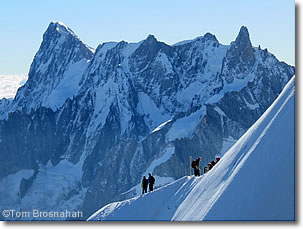
View from the Aiguille du Midi, Chamonix-Mont-Blanc , France.
- Start Here!
- Offbeat Places
- Loire Valley
- South of France
- France's Regions
- France's Departments
- France's Backstory
- Facts about Ze French
- Stereotypes and Myths
- France's Favorite Foods
- A Typical French Breakfast
- Did You Say Escargot?
- Weird French Foods
- Let Them Eat Baguette
- Apero Time!
- French Pastry Desserts
- French Christmas Meals
- Best Landmarks
- Best Books About France
- Essential Planning Tips
- Best Time to Visit France
- Driving in France
- Taking the Train
- Renting a Car in France
- Official Holidays
- 9 Sensational Road Trips
- How to Plan Your Route
- 10 Days: South of France
- 7 Days: Basque Country
- 5 Days: Lake Geneva & Alps
- How to Shop in France
- Le Petit Shop
- Christmas Gifts
Unsure about your French table manners? Click Here to download > > How to avoid these 10 food etiquette mistakes !
Follow me on
- Destinations
- Lake Geneva-French Alps
- French Alps Lake Geneva Itinerary
5-Day Lake Geneva and French alps Road Trip itinerary
Updated 15 January 2023 by Leyla Alyanak — Parisian by birth, Lyonnaise by adoption, historian by passion
When friends come to visit, this road trip is usually part of their stay, in whole or in part. I live nearby so this is my backyard, and I love sharing it!
This itinerary is close to my heart — because I live here, along the River Rhône, with Annecy my nearest town. If you come here, Annecy will have to be on your route; it has often been called "France's prettiest town" so you can't miss that...
But the region is much more than towns. This is a region of majestic Alps, fortified villages, cobblestones and cheese, a region of the outdoors. And if I sound enthusiastic, it's because I chose to live here, for all of these reasons. If I were visiting France and wanted to see some of its most powerful scenery, this is where I'd come.
So let's get started.
NOTE: Pages on this site may contain affiliate links, which bring in a small commission at no cost to you.
COMING TO FRANCE? THESE RESOURCES CAN HELP!
🏨 Accommodation - I rent hotels quickly and easily through booking.com 🚘 Car rentals - I use Discovercars , Europe's best car rental website 🚊 Train tickets - I book my train and bus tickets on Omio 🚌 Day tours - I take the best day tours with Viator and GetYourGuide
This Alps driving tour is for...
- Anyone landing at Geneva airport.
- Lovers of great scenery, road trippers, those who like meandering through medieval towns and villages, lovers of great foods (especially cheese), lovers of mountains.
This itinerary is best undertaken between Easter and October, although many tourist attractions will be closed at the beginning and end of the season, and at the height of summer, it gets crowded.
Ideally, I'd come in May-June or September-October. And if you love winter... well, nobody does it better but beware, there can be snow on the roads.
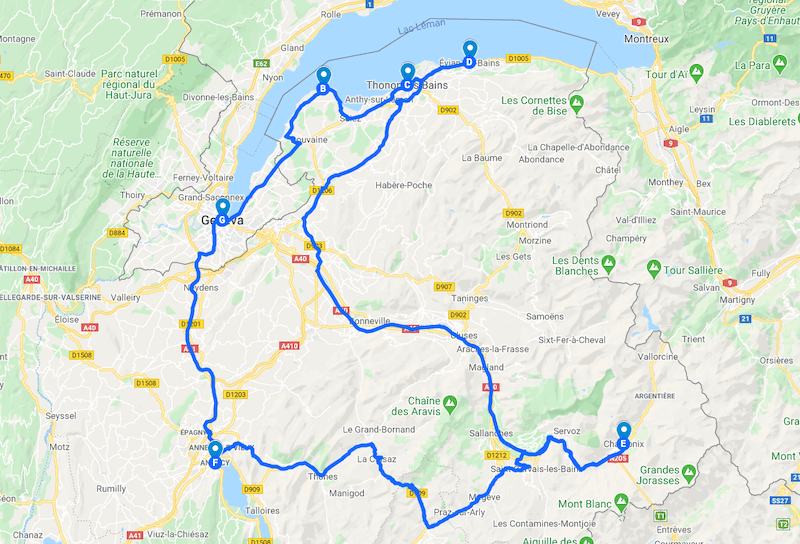
Suggested French Alps travel itinerary
- Day 1: Rent your car in Geneva (either in Switzerland or on the French side of the border) and head out to Yvoire for a leisurely dinner and overnight
- Day 2: Drive to Evian via Thonon and sleep in Evian
- Day 3: Drive to Chamonix and spend the day and night
- Day 4: Drive to Annecy and spend the day and night
- Day 5: Either spend an extra day in Annecy, or drive from Annecy to Aix-les-Bains and then onto Geneva.
YOU NEED TO KNOW THIS BEFORE YOU RENT A CAR
If you land at Geneva airport, you need to decide where to rent your car, in Switzerland or in France. The airport is on the border and both sides have rental car offices.
French rentals are far cheaper, but you'll have extra costs: the rental cost itself ( you can compare prices here ), and transportation from the Swiss to the French side of the airport to get your car. You may also need a Swiss autoroute sticker if your car doesn't have one (CHF 40, a bit more in USD). You could avoid this by cutting through town to get to France rather than taking the ring road but Geneva driving can be complicated, with many signs and lanes and is best left to residents.
If your flight originated outside France, you'll arrive on the Swiss side so you'll also have to take a cab/Uber/bus from the Swiss to the French side of the airport. They are connected via the terminal but sadly you cannot cross unless you have a boarding pass and are catching a flight. If you're flying from a destination in France , no problem, you'll arrive on the French side.
If you arrive between 1 November–31 March, check that your rental car has snow tires. They are compulsory, but not everyone follows the law.
And finally, make sure you tell the car rental you plan to cross the border – there might be additional insurance costs.
Read these driving tips for France before you head off!
The Alps in France: Main stops and sights
This Alps itinerary provides a mixture — urban, village, lakeshore and mountain, so something for everyone. Just bring your walking shoes and your appetite.
Geneva, humanitarian city
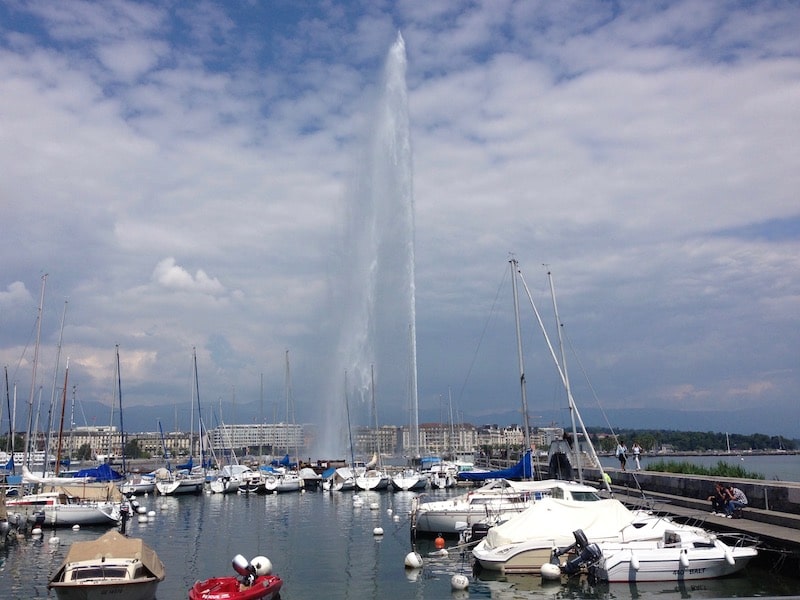
If you have time to do a bit of sightseeing in Geneva, you might want to take a selfie in front of the Flower Clock or the famous Jet d'Eau (Geneva's iconic water spout).
You could also visit the world's largest particle accelerator or take a brief tour of the International Museum of the Red Cross and Red Crescent (absolutely recommended, and it has a great cafeteria). If tours are open, the United Nations is right across the street from the museum.
For something more out of the way but still easily accessible, hop a tram to Carouge, an ancient city (now more of a neighbourhood) which has in turn belonged to Rome, Piedmont-Sardinia, France and eventually Geneva, a ray of Mediterranean sunshine in an otherwise Calvinist Geneva.
NON-DRIVING OPTION : Take a Geneva City Tour
Yvoire, charming medieval village
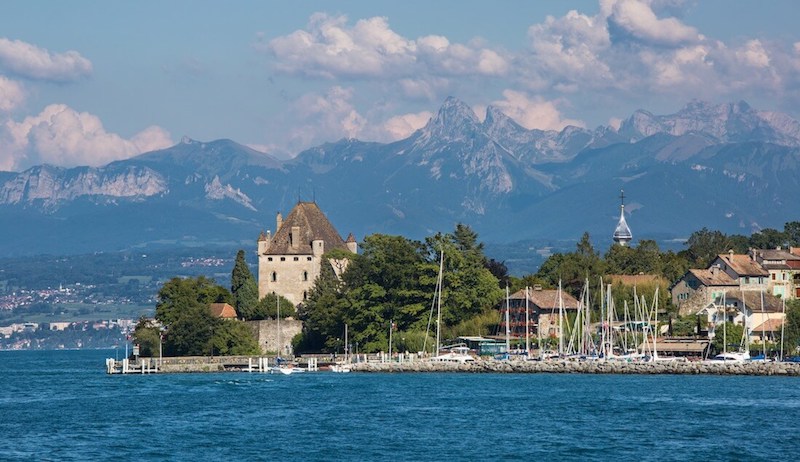
When I say charming, I mean it, because I once lived in this tiny pedestrian village for several years. Yvoire is small, and a walk through it shouldn't take more than an hour. But there's plenty to do beyond a stroll.
An amusing visit is the garden labyrinth of the Cinq-Sens, built around our five senses. Yvoire itself is lovely and can get quite crowded, especially when the ferries from Geneva arrive.
You'll find plenty to buy – some useless souvenirs, but this village also happens to be crammed with artists' shops, original works from actual artists who create throughout the winter to sell in summer.
To eat (but reserve ahead – it's popular and always full) head for the Hotel Restaurant du Port, a great place to spend the night and relax once everyone else has gone back to Geneva. Order perch fillets, their specialty, which comes in a lemon sauce so good you'll want to lick the plate. (Please don't or you may be thrown from the terrace into the lake!)
It's a pedestrian village, so no cars. There's a large parking lot at one end of the village (just follow the signs) and walk back in.
Book your Yvoire hotel here.
NON-DRIVING OPTION : Visit Yvoire from Geneva
Thonon-les-Bains
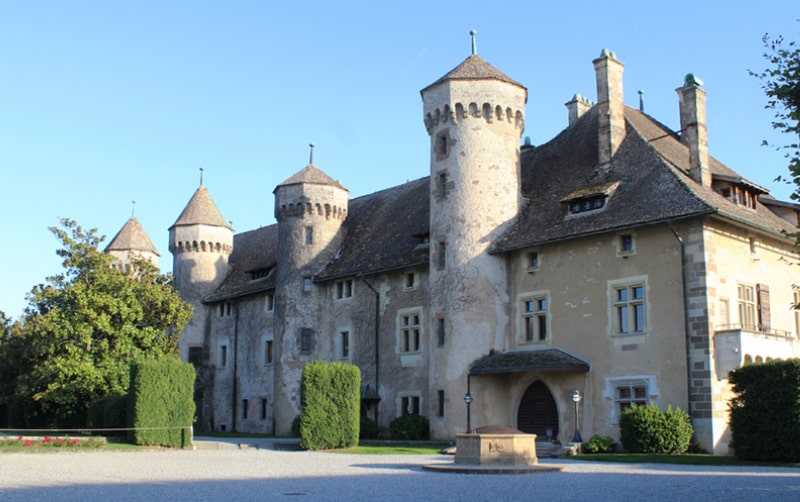
You can park in the upper town and take the Funicular down to the port, a great place to have a coffee after your drive.
For lunch, there's plenty to choose from in Thonon or you can drive to the Chateau de la Ripaille, once the home of the Dukes of Savoy (and which produces its own wine). It has a lovely restaurant but be sure to reserve.
So many people have come through here... armies of the French Revolution were quartered here, as was one of Napoleon's generals. It was eventually taken over by an industrialist who shaped it into the combination of gothic and Art Nouveau styles you have today.
Or you can push on to...
Evian-les-Bains

You've heard of Evian — if not the town, at least the water. But this is where it comes from and of course, it is a spa town.
Drop by the Art Nouveau Buvette Cachat to admire the building, but move on to the neo-classical Villa Lumière. If the name sounds familiar, it's because it belonged to the parents of the famous Lumière brothers, who invented the cinema. It's now the town hall but you can at least ogle the lobby.
Throughout the city, you'll get a strong sense of Evian's Belle Epoque past .
Like other spa towns, the best thing you can do here is sample the spa treatments, either in a private spa or in the municipal thermes. The ultimate luxury will be in going home to boast your spa treatments all involved Evian water, the same one as in the bottles.
Book your Evian hotel here.
NON-DRIVING OPTION : Take a tour boat to Evian
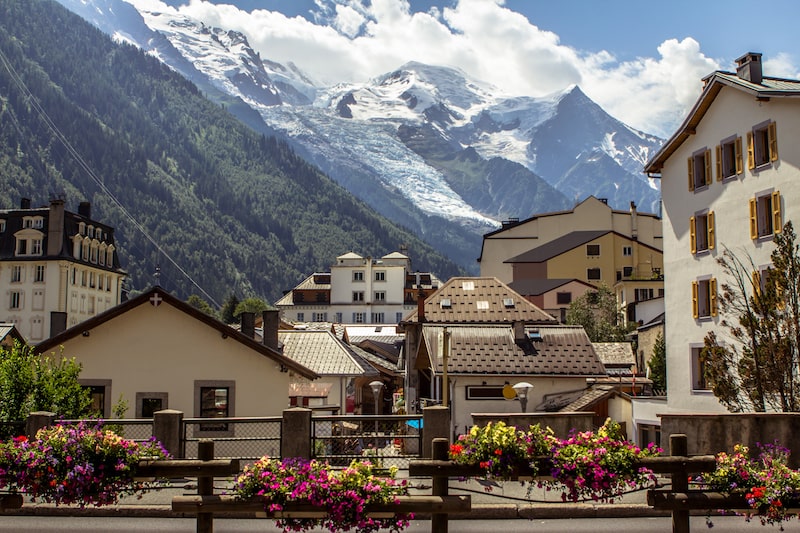
Chamonix is an irresistible stop in France's northern Alps, for many reasons. If you're a winter sports fan, you do it all here — a world-class winter resort.
But Chamonix has the unusual distinction of also being a world-class summer resort for hikers who try short day hikes or the gruelling Tour du Mont Blanc, often on a self-guided tour .
One of my favourite places in Chamonix (other than walking around town and hopping from café to café and gazing at the Mont-Blanc towering over me) is the Crystal Museum, with collections from around the world. Chamonix is a world center for crystals and hunting for them has been a long-time activity.
This is one of the most beautiful settings on the planet so ride the cable cars, walk around, and know that you are seeing something sublime.
Just one thing: if you plan on taking the famous Aiguille du Midi cable car, don't just show up, but reserve through the tourist office .
Book your Chamonix hotel here.
NON-DRIVING OPTION : Visit Chamonix and the Aiguille du Midi from Geneva
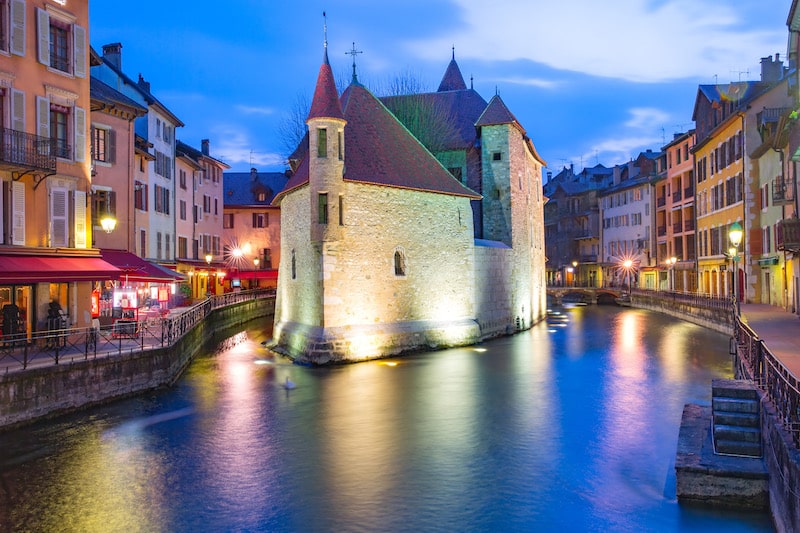
Annecy is not a town you visit for its culture (that's not to say it doesn't have any - it certainly does) but for its breathtaking natural beauty , both in the city and around its lake. It has been called France's prettiest town , and with reason.
In the city, stroll under the arcades in the old town and stop off for a great meal in one of its many renowned restaurants (or for a pastry at Rigollot , who a few years ago won the Best Pastry Chef of France competition).
Go on a market day if you can: Tuesdays are mostly food and local visitors, with Friday and Sunday enlarging to include a brocante or flea market (and a lot more tourists).
Lake Annecy is stunning. If you're on foot, just head towards the lake and begin walking in either direction. The views are spectacular wherever you go. You can actually walk all around the lake, or alternate between walking and taking the boat (the tourist office can help). You can also cycle around the lake — most of it, anyway. Check with the tourist office to see if the full circuit is now completed.
Or you could drive to the Col de la Forclaz for some adrenaline and go paragliding for a bit (or sit in a café and enjoy the sight of paragliders flying past over your head).
Book your Annecy hotel here.
NON-DRIVING OPTION : Visit Annecy from Geneva
Aix-les-Bains
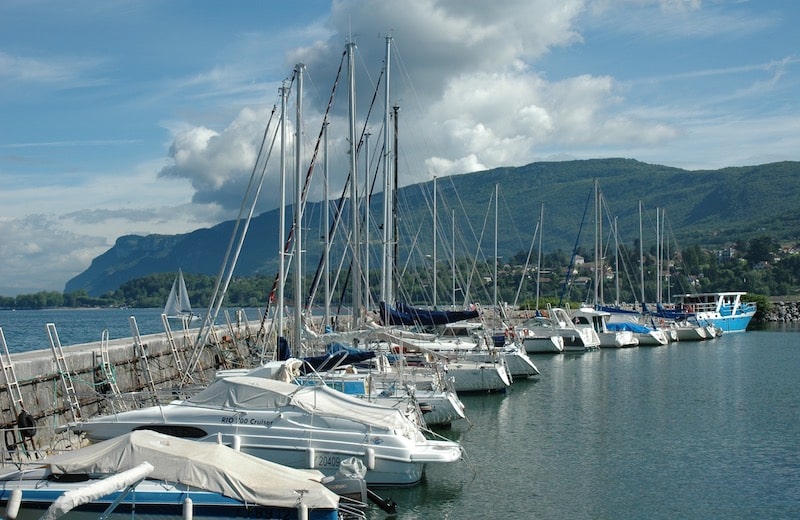
Aix-les-Bains is a lovely spa town set above the Lac du Bourget, France's deepest lake, of such beauty many French writers have extolled it in poetry and prose, from Lamartine to Alexandre Dumas.
But perhaps its most famous (albeit temporary) citizen was Britain's Queen Victoria, who loved the city so much she kept coming back, starting a trend of British visitors that continues to this day.
It's a sporty town, given its lakeside location, but most people come here for the thermal baths, which are excellent and relatively inexpensive, especially when compared to resorts in Brittany or on the Mediterranean.
It has a stellar collection of hotels for the spa-goer ( here are some of the best ) as well as a selection of thermal establishments.
You can also just enjoy these for half a day but book first! You'll find some info on the main site (in French only - but you can email them using Google Translate) about the half-day treatments and rates.
READ MORE: Sensational Road Trips to Discover France
History and other interesting things
This entire area was once known as the Duchy of Savoy — it wasn't part of France at all. For many Savoyards, as the people of this region are called, those were the good old days and Savoy would be much better off without France.
Every so often, when you cross from one department to the next, someone will have painted a wishful line across the asphalt that will say something like Savoie libre , free Savoy. But it's wishful thinking, and it's a minority.
So the Duchy came into being in the early 15th century and in those days stretched south all the way to Nice. Over the centuries, ownership would bounce around from France to Sardinia until in 1860, Savoy became French once and for all.
The Résistance
The Alpine region, blessed with difficult mountains and plentiful forests (not to mention the nearby borders with Italy and Switzerland) was a haven for resistance fighters during World War II, with some of the most spectacular coups staged right here.
This was also the first region freed from the Nazi stranglehold by the Resistance, and you'll find many monuments to fallen fighters along the roads as you travel.
Offbeat sights along the way
- In Geneva , if it's summer you'll be spoiled for choice. Play chess with experts on a giant outdoor board in the university yard (Parc des Bastions in the Old Town) or go swimming at the beach of the Bains des Paquis right downtown, surrounded by Geneva's luxury hotels and residences.
- In Yvoire , leave town. Yes, you read that right. To escape the crush of tourists, look for the Porte de Nernier (the gate closest to Geneva) and start walking towards Nernier, the village next door, what Yvoire must have looked like before it was 'discovered'.
- In Thonon-les-Bains , ride the funicular (built in 1888) for a minute or two from the port to the upper town and look across to Morges in Switzerland.
- In Evian-les-Bains , if the weather is clear, stay at the Hotel Les Cygnes or eat in their friendly and delicious restaurant in the evening to watch the amazing sunset over the Jura Mountains across the lake.
- In Chamonix , if you have the time and you're in shape, take the Montenvers railway up to the station and learn all about the region's crystals. And walk back down!
- In Annecy , for cheese lovers only: after your lakeside sports, try a truffle fondue at l'Etage . Once you're full, amble over to the Fromagerie Pierre Gay and head for the back, and look down: you'll be standing over a thick glass window and watching hundreds of cheeses mature below. Then off to the counter to buy some!
- In Aix-les-Bains , visit the Belle Epoque Casino Grand Cercle to admire the 1880s stained glass ceilings. It's a casino so yes, you can gamble, but the décor is what this place is all about.
- In summer , the region hosts antique car rallies in style, and you'll run into them as you climb up towards mountain passes. Here's one of the several groups that organize these rallies.
- In winter , you can follow along the Grande Odyssée , or Great Odyssey, a week-long dogsled race that chooses a different alpine itinerary each year.
Food and drink of the Alpine region
- As with most Alpine regions, the Savoie and Haute-Savoie (the two departments that make up the Savoy region) are known for their cheeses , especially such typical cheese dishes as fondue and raclette.
- Other local specialties include air-dried beef and charcuteries , or cold cuts. In the mountains, preserving meats has become a high art. This is a region of excellent local sparkling waters (and yes, they do taste different from one another ).
- Best time to visit the Alps: winter for snow sports and summer for hiking in the mountains. For Geneva, Annecy and Aix, late spring and early autumn are the loveliest seasons (and far less crowded than summer), with June and September topping the list.
Did you enjoy this article? I'd love if you shared it!
Pin these and save for later.
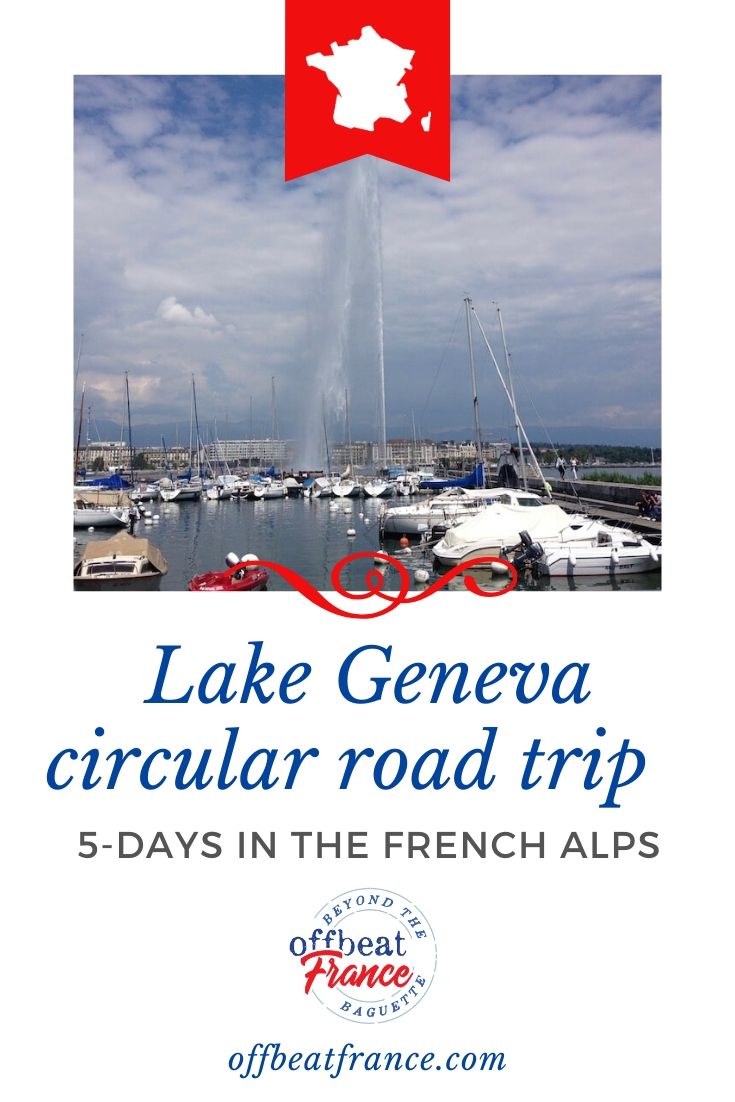
Bonjour! I’m Leyla! I was born in Paris and now live in the bucolic mountain foothills of Eastern France between Lyon and Annecy.
I'm rediscovering my own back yard after years of living abroad in Canada, Spain and Switzerland as a journalist and a diplomat - and I'm loving every minute.
Passionate about history and culture, I’ve created Offbeat France to seek out my country’s mysteries and legends, less-traveled destinations, along with plenty of food stops and many castles - I am French, after all!
What's New!
Fall In France: How To Enjoy France In Autumn To The Fullest
Aug 21, 24 05:38 AM

If You Love Antiques, Head For Isle Sur La Sorgue In Provence
Aug 15, 24 01:49 AM
Don't Miss These 7 Spectacular Sights in Saint Remy de Provence
Aug 14, 24 09:37 AM
The Paris Olympics Opening Ceremony: What Did It All Mean?
Jul 30, 24 01:30 AM
The Fearless Corsairs And Legendary Basque Legacy Of Saint Jean de Luz
Jul 29, 24 03:19 AM
© Copyright 2024 OffbeatFrance.com | All Rights Reserved | Privacy Policy & Disclaimer | Contact Me
As an Amazon Associate offbeatfrance.com earns from qualifying purchases

16 Top-Rated Attractions & Places to Visit in the French Alps
Written by Lisa Alexander Updated Dec 24, 2023
Author Lisa Alexander spent two years living in France and has traveled the country extensively.
For nature lovers, the French Alps are one of the best places to visit in France . This area boasts some of the most magnificent scenery in Europe: awe-inspiring mountains, crystal-clear lakes, rushing waterfalls, and pristine forests.
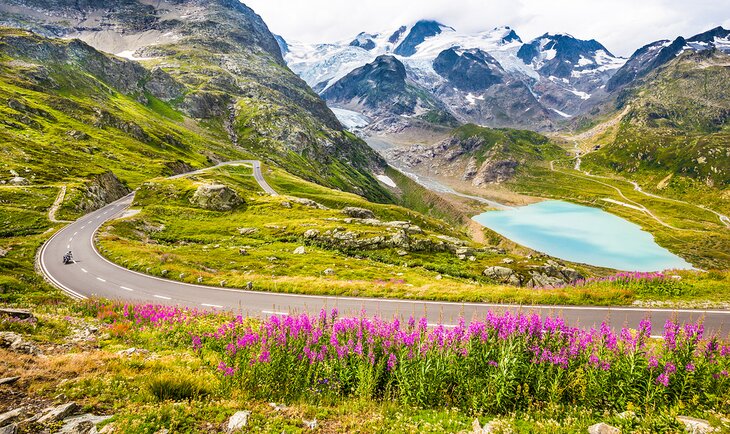
The French Alps correspond with the historic duchy of Savoy , as well as the Dauphiné region . The impressive Château de Ducs de Savoie is found in Chambéry. The old château in Annecy belonged to the Counts of Geneva, while Grenoble was the meeting place of the Estates of the Dauphiné.
Most tourists focus their visit on outdoor activities, such as hiking , biking, and mountain climbing in summer; skiing and snowboarding in winter. The ski resorts of Chamonix, Val d'Isère, and Portes du Soleil offer excellent facilities, a lively ambience, and regional charm.
Relaxation is another reason to visit the French Alps. For over a century, tourists have arrived here in search of the rejuvenating fresh air and leisure. Many Belle Epoque spa towns, including Aix-les-Bains, Evian-les-Bain, and Saint-Gervais-les-Bains, are still popular today.
Tourists will be amazed by the wealth of cultural and natural attractions to discover here. Find the best things to see and do in the region with our list of the top tourist attractions and places to visit in the French Alps.
Vercors Regional Natural Park
Aix-les-bains, val d'isère, evian-les-bain, cirque du fer-à-cheval, route du galibier, albertville and surrounding ski resorts, portes du soleil ski area, route napoléon, saint-gervais-les-bains, thonon-les-bains.
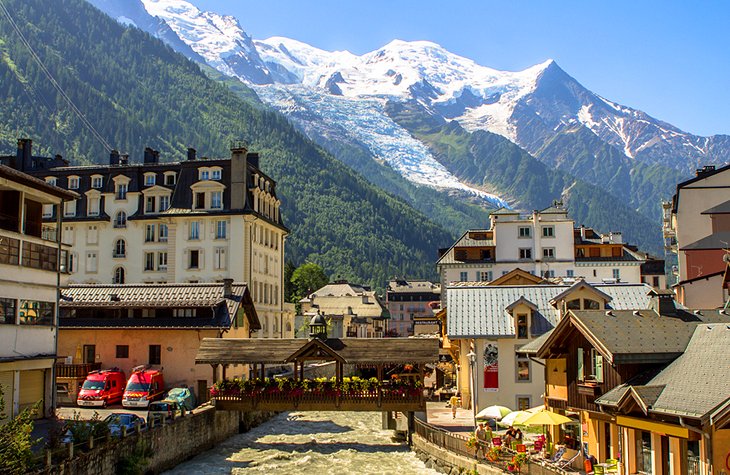
The village of Chamonix nestles in the peaceful Chamonix Valley at the foot of Mont Blanc, the highest peak in the Alps . Reaching an impressive altitude of 4,807 meters, Mont Blanc is covered in a blanket of snow during all seasons of the year, even in summer.
Surrounded by mountains, meadows, and rushing streams, Chamonix is a high-mountain town that draws tourists from around the world. Visitors come to experience the beauty of the Alpine scenery and to participate in outdoor sports, such as skiing, hiking, climbing, mountaineering, biking, and golf.
Chamonix is the base of an internationally renowned ski resort offering some of the best skiing in Europe . The resort area extends for 23 kilometers along the Vallée de Chamonix between Les Houches and Argentière.
Tucked away among farms, lush forests, and Alpine meadows, Les Houches (a group of little hamlets) provides a dreamy escape for vacationers. Families especially appreciate the traditional mountain-village atmosphere and the many children's activities. Les Houches has a wide selection of hotels, chalets for rent, restaurants, and shops.
One of the must-see sites in Chamonix is the Aiguille du Midi summit (at 3,842 meters high) with incomparable views of Mont Blanc and the Glacier des Bossons. From the center of Chamonix, the Aiguille du Midi is accessible by a 20-minute cable car ride over high-mountain forests.
Another way to admire incredible vistas is on the Panoramic Mont-Blanc gondola. This exciting, scenic route traverses above ice falls and crevasses, with vantage points towards Pointe Helbronner in Italy.
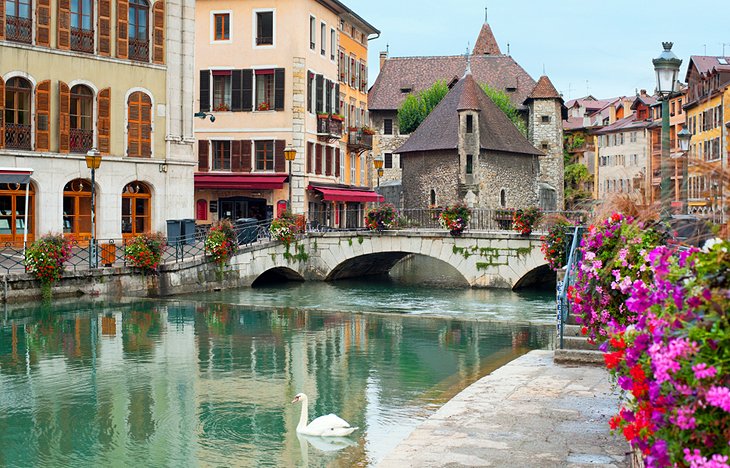
Set by a tranquil lake with snowcapped mountains in the background, Annecy looks like a scene straight out of a storybook. Graceful white swans glide around the narrow canals of the Thiou River, which flows out of the lake and through the old town.
The old town (historic center) of Annecy charms visitors with its beauty and old-world ambience. Many building façades feature balconies adorned with colorful geraniums. Winding cobblestone streets invite a leisurely amble, while water channels traversed by small foot bridges add to the fairy-tale look.
Within the old town, an especially delightful place to wander is along the Rue Sainte-Claire . This distinctive street features arcaded 16th- to 18th-century buildings that now house many shops and restaurants.
Tucked away on Annecy's medieval streets are many architectural treasures. Annecy has two historic churches, the 15th-century Eglise Saint-Maurice and the 16th-century Cathédrale Saint-Pierre .
Not to be missed in the old town is the 12th-century Palais de l'Île , on an islet in the Canal du Thiou. The building was originally a prison and later used as the Palace of Justice. Today the Palais de l'Isle displays a collection of exhibits about regional architecture and history.
Another of the top attractions in Annecy is the Château d'Annecy , which dates back to the 13th century and was once the residence of the Counts of Geneva. Today, the château is a museum devoted to local history, medieval sculpture, landscape paintings, and contemporary art.
For those who enjoy animated films, it's worth taking a short walk from the château to the Musée du Film d'Animation (18 Avenue de Trésum), which presents exhibits about the process of creating animated films.
When the weather warms up, the Lac d'Annecy draws many vacation-goers. Beginning in springtime, the lake awakens with activity and potted flowers decorate the lakeside promenade .
Visitors can stroll along the shores of the lake that runs parallel to the Avenue d'Albigny , shaded by plane trees, with a path for bikers and pedestrians. The avenue extends alongside the lake for approximately one kilometer (about a 20-minute walk), ending up at the Parc Charles-Bosson , a lakeside park with benches near the water's edge and a spacious lawn that's ideal for picnics.
Just past the Parc Charles-Bosson on the Avenue d'Albigny is the Impérial Palace , a legendary Belle Époque hotel set in beautiful leafy grounds with a rose garden. This four-star hotel offers contemporary-style guest rooms, elegant salons, a gastronomic restaurant, spa with wellness center, and concierge services.
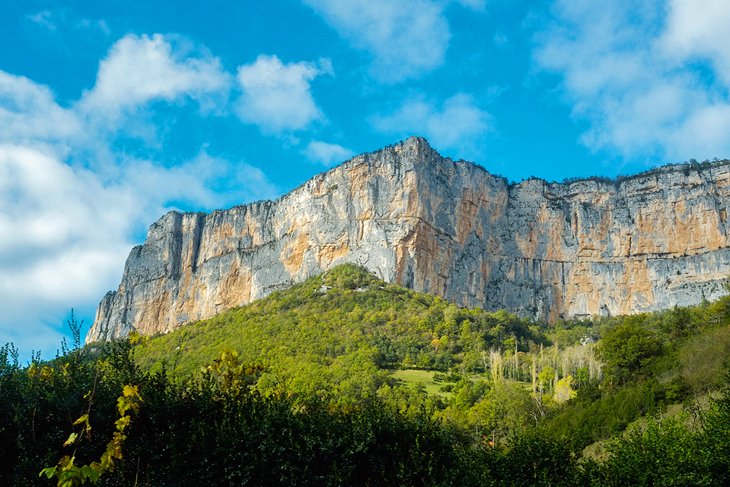
The Vercors is a range of forest-covered hills in the Dauphiné region between the Rhône Valley and the Route d'Hiver des Alpes. The mountains rise to 2,346 meters at the Grand Veymont and are broken up by deeply indented valleys and gorges.
The natural park has numerous well-groomed paths and trails, allowing visitors to explore the Vercors on foot or on horseback. In winter, excellent facilities are available for a variety of sports. It is worth making a special trip around the Vercors to take in the unusual scenery of the region.
Through the Combe Laval , there is a mountain road constructed in 1897, originally for the transport of timber from the Forêt de Lente to Saint-Jean-en-Royans. The finest stretch of the road begins at the wooded Col de la Machine on the way down to Saint-Jean, offering magnificent views of the countryside below.
Beyond Villard-de-Lans, the road descends into the Bourne Valley, which narrows into the Gorges de la Bourne, and continues through tunnels and over bridges. Beyond the little town of Pont-en-Royans is the Vernaison Valley and the picturesque Vernaison gorges. It climbs, with many bends, to the grandiose Grands Goulets gorge.
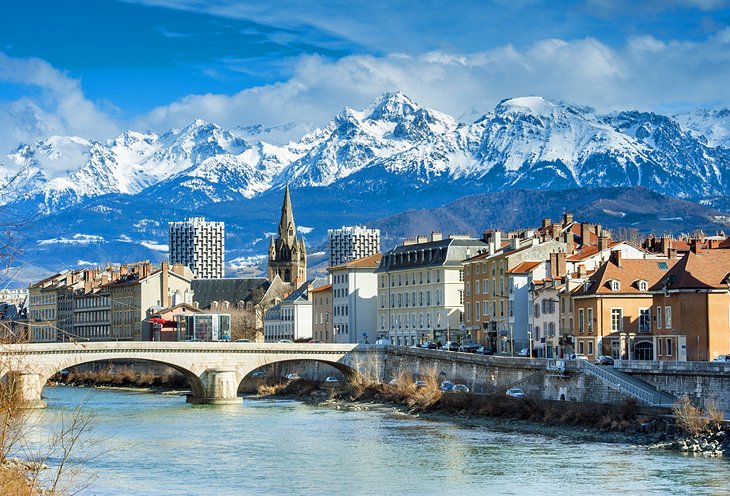
The old capital of the Dauphiné region, Grenoble lies in a basin of the Isère Valley surrounded by mountains rising to 3,000 meters. Grenoble is dominated in the north by Fort Rabot and the Fort de la Bastille, both on foothills of the Mont Rachais range.
Must-see historic landmarks in Grenoble's Vieille Ville include the Palais du Parlement du Dauphiné (Hall of Justice of the Estates of the Dauphiné), an opulent palace blending Flamboyant Gothic and Early Renaissance styles; and the Musée de l'Ancien Évêché , a 13th-century Episcopal palace that houses a museum of Grenoble's history.
The Musée de Grenoble is one of France's most important fine arts museums. The collection includes paintings by the great masters, including Rubens, George de La Tour, and Philippe de Champaigne, as well as 19th-century artists such as Delacroix and Monet. Modern art is represented with works by Picasso, Matisse, and Léger, among others.
In addition to Grenoble's cultural riches , it is blessed with a gorgeous natural setting and lush parks. Not to be missed is the Jardin des Dauphins, 30 hectares of terraced gardens with exceptional views. Shaded pedestrian paths and staircases make this park a pleasant place to stroll.
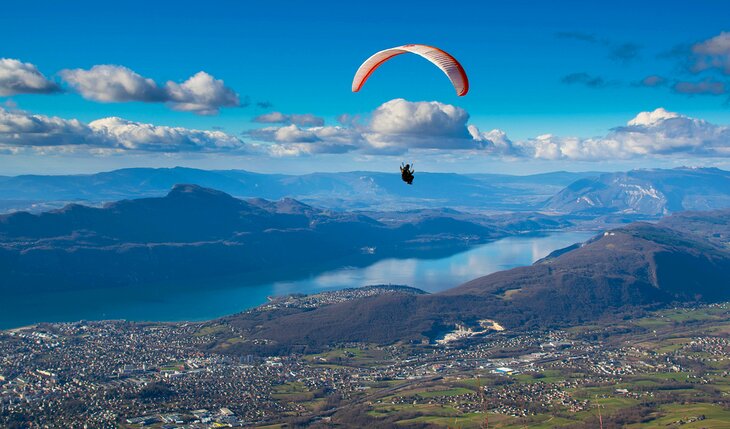
In the mountains by the Lac du Bourget, Aix-les-Bains is an internationally renowned spa town. The bucolic landscape, majestic views, and serene atmosphere make it ideal for a health retreat.
The town's natural hot springs have been used for curative purposes since Roman times. The ruins of Roman baths , the Arch of Campanus and the Temple of Diana, are open to the public.
Aix-les-Bains still welcomes visitors to bathe in its mineral waters and become immersed in restorative leisure time.
The modern facilities at the Marina Adelphia Spa and Hotel include a wellness center with therapeutic baths and an upscale spa with a sauna, Jacuzzi, and hammam. This four-star hotel also has a gourmet restaurant that serves traditional French cuisine.
Other thermal bath facilities are found at Domaine de Marlioz , which includes two hotels (3-star Ibis Styles and 4-star Hôtel Mercure ), two restaurants, therapeutic thermal baths, and a full-service spa. The property is set in a calm, verdant park shaded by hundred-year-old trees.
In a lovely spot with mountain views, the Thermes Chevalley offers spa treatments, saunas, and swimming pools filled with warm thermal mineral waters. The Thermes Chevalley waters are said to cure various health conditions including rheumatism, joint stiffness, back pain, and osteoarthritis. The facility's staff also provides relaxation programs, nutritional guidance, fitness courses, and physical therapy.
Much of the architecture in Aix-les-Bains dates back to the Belle Époque, when it was a fashionable spa destination. From an earlier era, the 15th-century Château des Marquis d'Aix (now the Town Hall) has a Renaissance staircase built of stone from Roman structures.
Art lovers will appreciate the Musée Faure (10 Boulevard des Côtes) housed in a stately villa, which has an interesting collection of Impressionist paintings, Rodin sculptures, and faience ceramics.
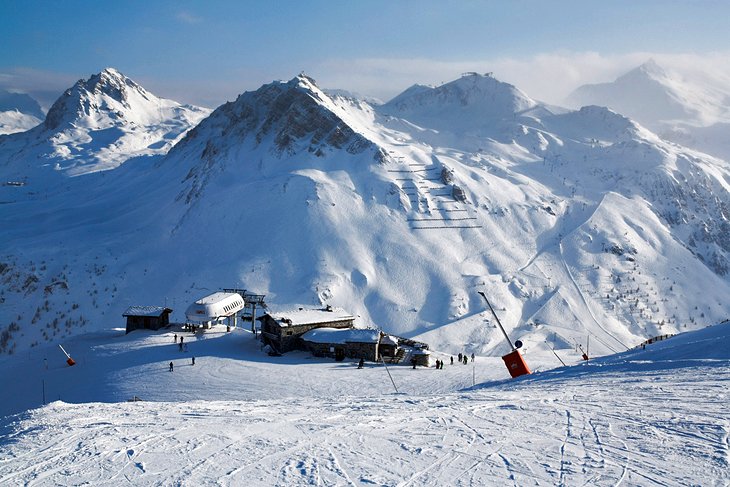
Val d'Isère has long been a favorite skiing area because it offers numerous ski lifts and cableways over an enormous terrain. The expansive Tignes-Val d'Isère ski resort is located in the Tarentaise Mountains at an altitude of between 1,550 meters and 3,500 meters.
The Tignes-Val d'Isère ski area is so vast and with so many options, both on- and off-piste, that it is possible to try a different run every time. The area offers 163 ski slopes on mountainsides that cover 300 kilometers.
The village of Val d'Isère is, at its heart, a traditional Alpine hamlet, with little chalets centered around a Baroque church.
The historic village has grown into a modern resort and boasts a lively après-ski ambience with an array of restaurants, from casual dining rooms that serve hearty Savoyard cuisine to Michelin-starred gastronomic establishments (including one-starred La Table de l'Ours and two-starred L'Atelier d'Edmond).
During summertime, Val d'Isère attracts many visitors with its vibrant mountain scenery and outdoor activities such as hiking, horseback riding, mountain biking, and climbing. It's also a marvelous area for taking nature walks to see wildflowers and bird life.
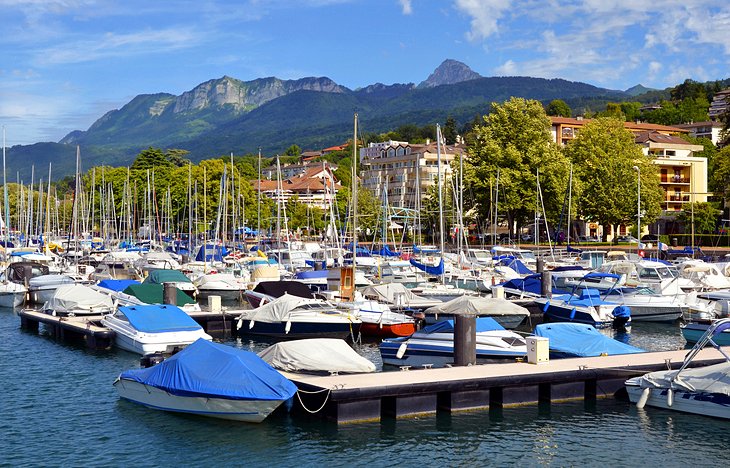
Nestled in the green mountain pastures of the French Alps, the spa town of Evian-les-Bains overlooks the crystal-clear blue waters of Lake Geneva . In this pristine location, Evian-les-Bains is a popular health resort and leisure destination known for its culture and entertainment options.
Evian-les-Bains has a rich history that dates back to the medieval era, but its heyday was during the Belle Époque when the town flourished as a spa resort. Elegant 19th- and early 20th-century architectural landmarks reveal the town's heritage as a prestigious destination for taking the waters.
Visitors still come to Evian-les-Bains to bath in the curative mineral waters. Les Thermes Evian spa facility offers therapeutic thermal baths and wellness programs as well as fitness courses. The facility's hydrotherapy spa treatments feature hydromassage jets designed to provide relaxation and muscle toning benefits.
An excellent example of spa architecture, the Palais Lumière was a thermal spa built in 1902 and now hosts art expositions throughout the year.
Listed as a Historical Monument, the Théâtre Antoine Riboud was built between 1883 and 1885 by a student of Charles Garnier. This lavish neoclassical theater hosts Estivales Théâtrales , a summertime theater festival focused on lighthearted comedies.
Evian-les-Bain also draws crowds for its classical music festival, Rencontres Musicales d'Evian , which takes place from the end of June through July.
For the simple pleasure of strolling in a rejuvenating setting, visitors can head to the town's lakeside promenade and Pré Curieux water gardens .
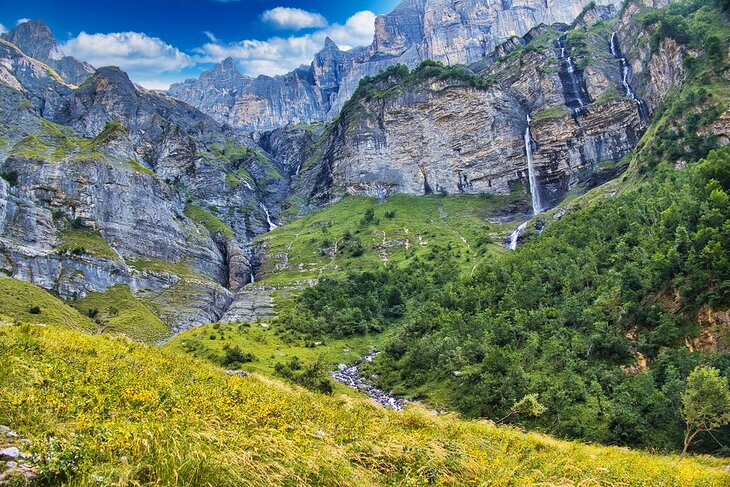
The Cirque du Fer-à-Cheval is a spectacular limestone mountain that was carved out by glaciers into a circular shape. This unspoiled nature reserve has wonderful trails for scenic walks and hiking. Visitors are enchanted by the peaceful Alpine environment of snow-capped mountain peaks, refreshing pine trees, and abundant waterfalls.
Nestled in this wilderness area, the picturesque village of Sixt-Fer-à-Cheval is listed as one of France's "Plus Beaux Villages" (Most Beautiful Villages). The village is actually a collection of 24 small hamlets surrounded by the nature reserve and graced by the "Cascade du Rouget" waterfall.
Sixt-Fer-à-Cheval is distinguished by its traditional Alpine architecture of high-pitched roofs and steepled churches. The town has an ancient abbey, the Abbaye de Sixt-Fer-à-Cheval , founded by Ponce de Faucigny in the 12th century, as well as an adjoining 13th-century parish church with a garden that is open to the public.
Nearby is a ski resort, as well as access to many hiking trails and other outdoor activities such as mountain biking and fishing.
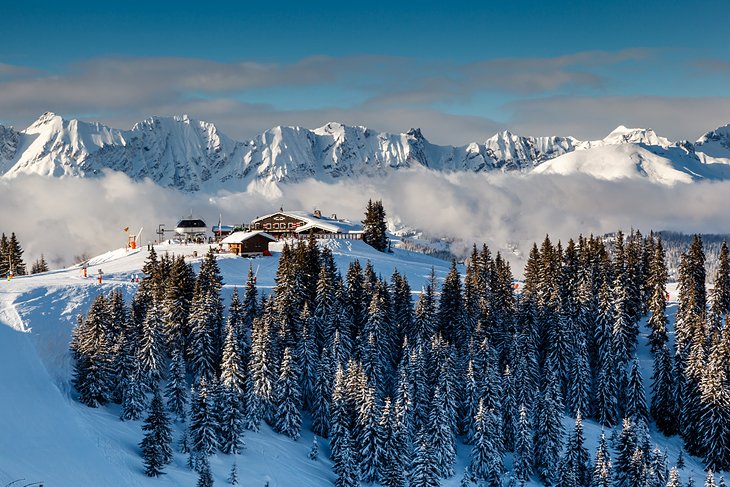
Megève is another one of France's best ski resorts , with opportunities for downhill skiing, cross-country skiing, and snowboarding. The quaint medieval village of Megève dates back to the 14th century and offers an authentic Alpine experience.
As a typical mountain village, Megève has narrow cobblestone streets, a main town square, and a historic parish church. The atmosphere is charming and vibrant, and the village is also well-developed enough to handle the influx of seasonal visitors to the ski resort.
Travelers will appreciate the abundance of modern hotels, exclusive boutiques, and upscale restaurants.
Although the skiing at Megève is limited because of its low elevation, the extensive ski domain incorporates areas in the nearby towns of Combloux, Saint-Gervais Mont Blanc, Saint Nicolas de Véroce, and Les Contamines Montjoie, with the skiable terrain encompassing eight mountain peaks.
Megève is also a popular vacation destination during summertime, for those who enjoy outdoor activities. Things to do include hiking, white water rafting, mountain biking, and rock climbing.
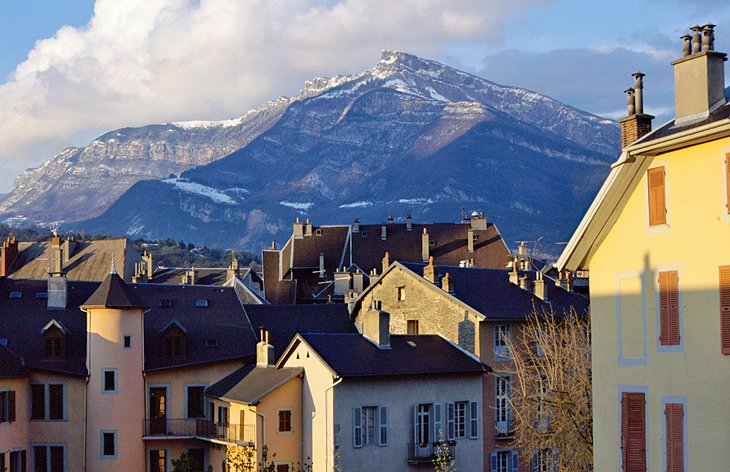
On the banks of the fast-flowing Leysse River, in a fertile basin surrounded by hills and mountains, picturesque Chambéry has a rich history tied to the Dukes of Savoy. The town was the capital of the independent state of Savoy from the 13th to the 16th centuries and is dominated by the old castle of the Dukes of Savoy.
The Château de Ducs de Savoie is a fortified castle that was founded in the 11th century and designed as a walled village, although the edifice that stands today was mostly built in the 14th century.
The château houses the local government offices, however a few rooms in the medieval wing are open to the public and display exhibits about the history of the castle. Visitors may take a guided tour (available in French only) to see more of the castle.
The Musée des Beaux-Arts , which occupies a former grain barn, displays an impressive collection of masterpieces by the Old Masters including Uccello, Titian, Tintoretto, Veronese, Lorenzo Lotto, Giovanni Battista, and Georges de La Tour. There are also noteworthy landscape paintings by Albert Charpin, Xavier de Maistre, Jacques Barthélemy Appian, and Antoine Watteau.
An indication of the town's former grandeur and cultural influence are the regal old mansions , created by noble families in the 15th and 16th centuries. The finest of these " hôtels particuliers " are found along the Rue Croix-d'Or.
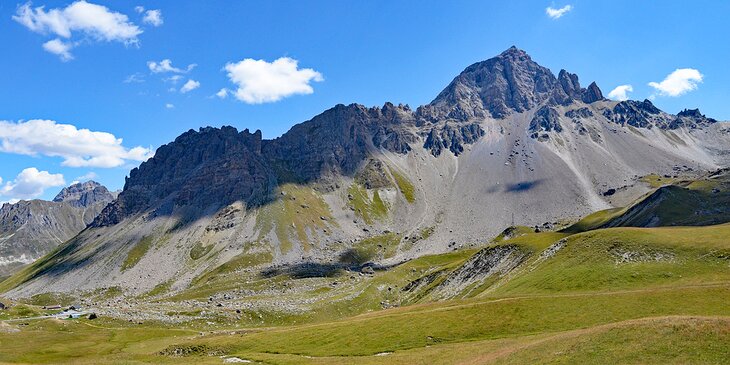
The Col du Galibier, in the sunny Maurienne valley of the northern Dauphiné district, reaches a height of 2,646 meters and ranks with the Col de l'Iseran (200 meters higher) as one of the highest mountain passes in France .
There are awe-inspiring panoramic views on both the ascent and the descent from the summit. The scenic drive is best planned during the summer, as it may be impassable from October until the end of May because of snow.
At the south entrance to the tunnel on this route stands a monument to Henri Desgranges, who initiated the Tour de France cycle race in 1903. The Col du Galibier is part of the Tour de France route but is also popular among recreational cyclists.
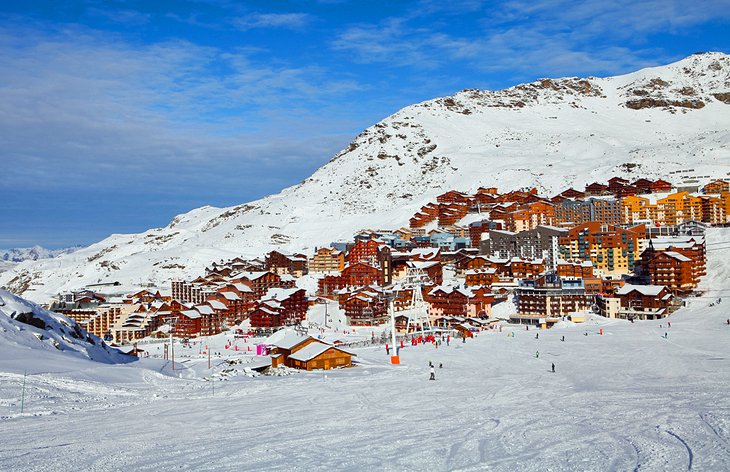
Albertville is a good base for a ski holiday in the French Alps and a worthwhile destination to simply enjoy the Alpine scenery. This bustling high-mountain town was founded by King Charles-Albert of Savoy in the 19th century and was laid out with a modern city plan.
On a hilltop spur above the town is Conflans , the oldest part of Albertville. This historic quarter is a relic of the past with its Gothic town gates, medieval walls, historic houses, and Baroque church.
Several top ski resorts are less than an hour away from Albertville. About 45 kilometers from Albertville is La Clusaz , a popular winter sports destination. La Clusaz ski area encompasses five interlinked mountain peaks, with 85 ski slopes covering 125 kilometers of groomed trails.
The charming historic village of La Clusaz , with its narrow, winding streets and splendid views, is a wonderful place to stay. Accommodations range from luxurious five-star hotels to cozy chalets and family-friendly rental apartments.
Another nearby option for skiers (60 kilometers from Albertville) is La Plagne , part of Paradiski ski area, which is one of the largest ski resorts in Europe with 425 kilometers and around 150 ski slopes. The resort area of La Plagne includes several small villages, and each has its own distinct high-mountain character.
Those looking for endless ski runs should head to Les 3 Vallées , just 27 kilometers from Albertville. Les 3 Vallées is the most extensive ski area in the world . This 600-kilometer domain has 166 lifts that provide access to 328 ski slopes.
Les 3 Vallées comprises several different resort areas, including the prestigious Courchevel area, which has six villages; the charming Alpine village of Méribel ; the more affordable resort of Brides-les-Bains ; and the family-oriented ski area of Les Menuires .
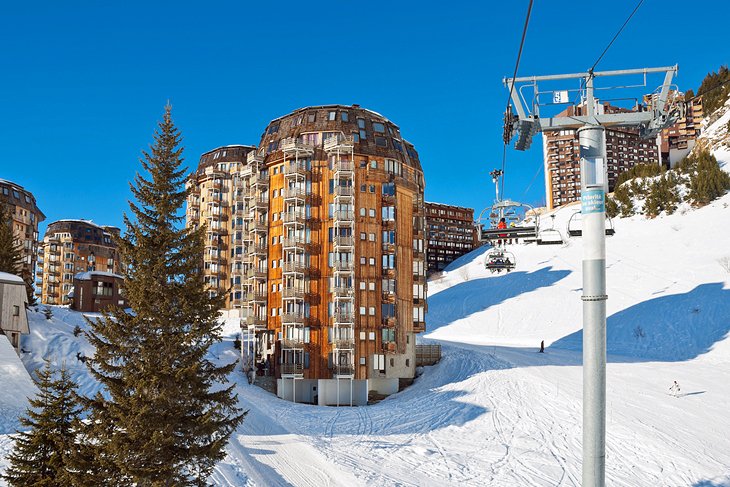
The Portes du Soleil ski area includes 12 different ski resorts in the Chablais mountain range. The resorts on the French side include Abondance, Chatel, Montriond, Morzine-Avoriaz, Saint-Jean d'Aulps, Avoriaz, La Chapelle d'Abondance, and Les Gets.
The bustling resort of Morzine-Avoriaz is sheltered in a forested valley with the Chablais mountains as a backdrop. Morzine provides a wide selection of accommodations in its authentic Alpine village. Avoriaz is a modern traffic-free resort that is popular with families.
La Chapelle d'Abondance enjoys a postcard-perfect setting in the sunny Vallée d'Abondance. This traditional Savoyard village offers all the amenities of a top-notch French ski resort . The nearby ski area includes downhill slopes and cross-country skiing.
In an idyllic lakeside setting, Montriond is an excellent choice for skiers who appreciate long runs. The nearby ski area boasts an almost eight-kilometer-long ski run, l'Abricotine, which extends from a mountain peak near the border with Switzerland.
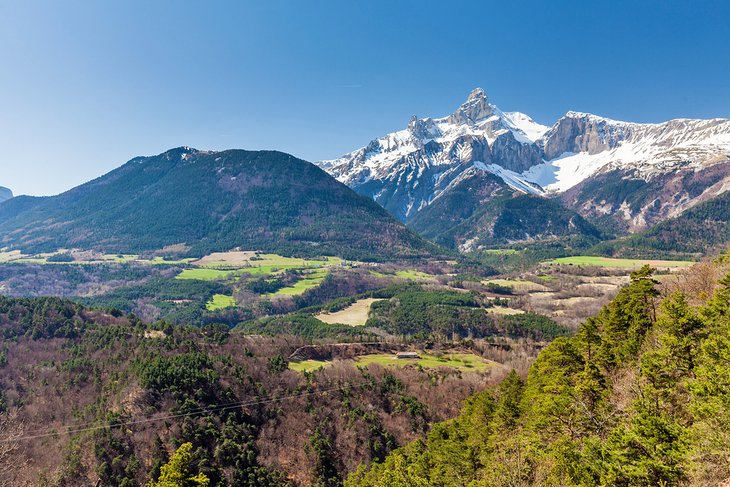
The Route Napoléon is a scenic itinerary for a driving tour through the French Alps. The four lakes of Laffrey are the main features on the barren plateau of Matésine. Here, on March 7, 1815, Napoleon won against a battalion, which had been sent to prevent him from advancing any further.
The Route Napoléon runs between Gap and Grenoble and one of the best places to visit is Corps , a fetching historic town in the expansive Vallée des Drac. The rural landscape in this area is particularly scenic.
It's worth taking a detour from Corp to the Church of Notre-Dame de la Salette , perched at an altitude of 1,170 meters amid stunning Alpine scenery. The church was built after the Virgin reputedly appeared to two children in 1851, and every summer, it attracts many pilgrims.
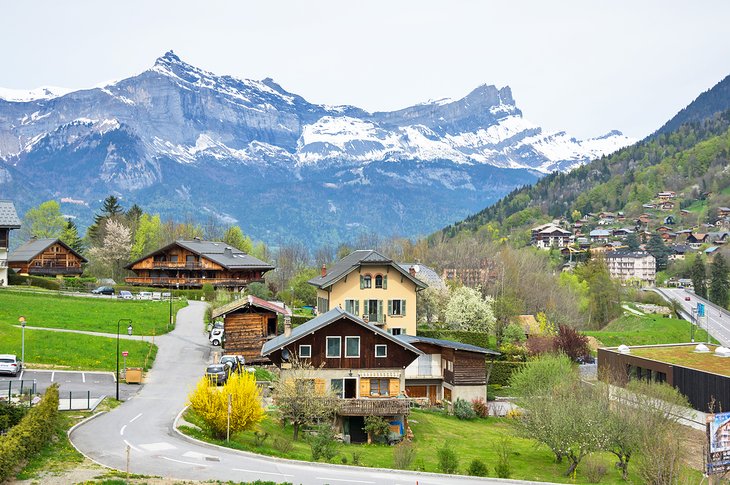
In the foothills of the Alps, the town of Saint-Gervais has been renowned since the Belle Époque period as one of the best spas in the Savoy region .
The town offers an escape to nature where visitors may enjoy the beauty of the mountain scenery and take advantage of the thermal baths. Many hotels in Saint-Gervais-les-Bains offer bathing facilities and spa treatments.
The luxurious Armancette Hotel provides comfortable accommodations in stylish guest rooms, suites, or fully equipped chalets. This five-star hotel has an upscale spa with an indoor-outdoor pool, three Jacuzzis, a sauna, and steam room. The hotel's outdoor terrace overlooks Mont Blanc .
Saint-Gervais-les-Bains is also a popular wintertime destination as it's connected by a network of cableways to the skiing areas of Megève and Chamonix.
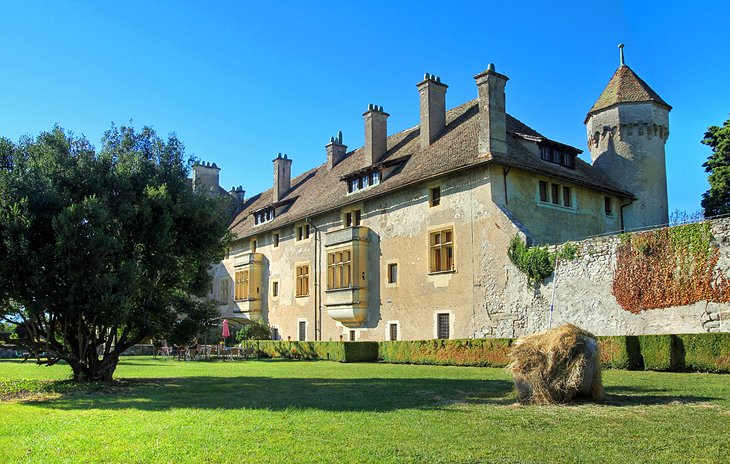
Perched above Lake Geneva, Thonon-les-Bains is a popular spa destination both in summer and winter.
A top place to visit is the 17th-century Château de Sonnaz, which offers glorious panoramic views of the Jura Mountains and Lake Geneva. The château houses the Musée du Chablais , which presents exhibits about the heritage of the Chablais Mountains region.
About 14 kilometers west of Thonon-les-Bains is Excenevex , a resort town on Lake Geneva with a large natural beach of fine sand bordered by pine trees. The beach has shallow waters ideal for swimming. Other things to do at Excenevex include boating, fishing, and volleyball. There is also a children's playground.
It's worth traveling a few kilometers farther to the medieval village of Yvoire , one of the "Most Beautiful Villages in France." This enchanting lakeside village boasts a 14th-century château with fortified ramparts and an exquisitely landscaped garden (listed as a " Jardin Remarquable ").
More Related Articles on PlanetWare.com
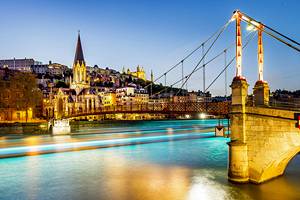
Nearby Attractions : About an hour and 30 minutes away by train or car from Grenoble, the UNESCO-listed city of Lyon offers cultural treasures and enchanting old-world ambience, as well as famous regional cuisine. There are many attractions that can be reached on a day trip from Lyon , such as the ancient Roman temple in Vienne and the medieval hilltop village of Pérouges.
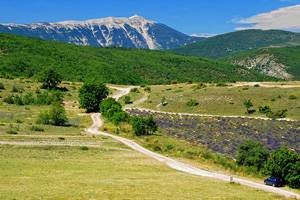
Highlights of Provence : Several top attractions of Provence are within a two- to three-hour drive away from the French Alps, including Avignon , the medieval city of Popes, and Nîmes , with its fascinating ancient Roman monuments. In the Haut-Vaucluse area of Provence, must-see sights are Orange, an important town in antiquity; the perched hilltop village of Gordes; and UNESCO-listed Mont Ventoux.

More on France


©Jevgeni Zabegajev/500px
Mountains loom large almost everywhere you look in Chamonix. Skiers and sightseers are launched by cable car to heights of 3842m on the Mont Blanc massif, while the glacial void of La Vallée Blanche – one of Europe's most fêted off-piste adventures – beckons to the brave. Skiers and boarders have a choice of pistes along the valley, while in summer the same lifts access hiking and biking trails.
Attractions
Must-see attractions.

Aiguille du Midi
The great rocky fang of the Aiguille du Midi (3842m), rising from the Mont Blanc massif, is one of Chamonix’ most distinctive features. The 360-degree…

Mer de Glace
France’s largest glacier, the 200m-deep 'Sea of Ice', flows 7km down the northern side of Mont Blanc, scarred with crevasses formed by the immense…

The highest peak on the western side of the Chamonix Valley, Le Brévent (2525m) has tremendous views of the Mont Blanc massif, myriad hiking trails…

Musée Alpin
This diverting two-level museum allows you to wander through Chamonix history, from butter moulds and farming tools of yore to the dawn of the 18th…

Musée des Cristaux
Beautifully lit collections of crystals, many from around Mont Blanc, are exposed within this small museum. The adjoining Espace Tairraz focuses on the…

Grotte de Glace
Step directly inside the glacier at this tunnel of ice, reshaped every year for the past half-century, which sparkles with perennially recreated ice…
Plan with a local
Experience the real France
Let a local expert craft your dream trip.
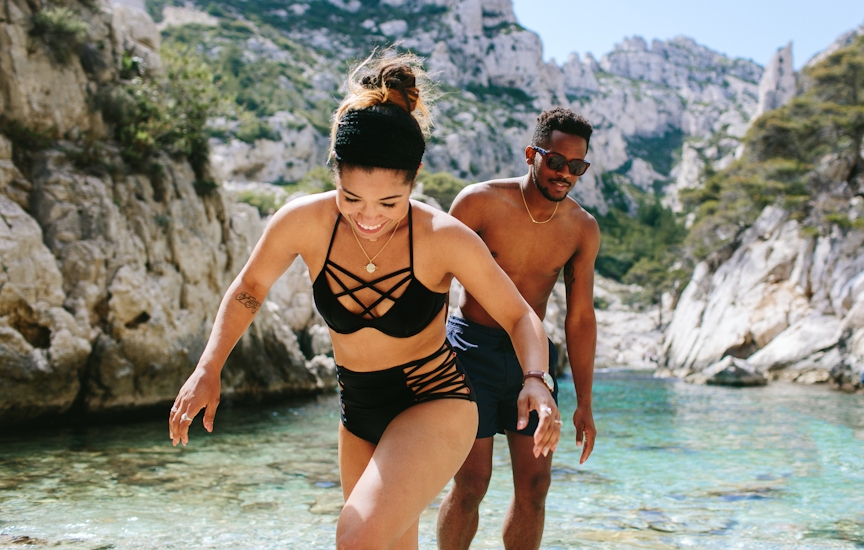
Latest stories from Chamonix

Sustainable Travel
Feb 24, 2020 • 3 min read
On 13 February, French president Emmanuel Macron announced a plan to limit access to Mont Blanc, curbing the number of ascents allowed and introducing a…

Jan 29, 2020 • 5 min read
French Alps

- 1.1 Mountains
- 4.1 Ski resorts
- 4.2 Water sports
- 5 Understand
- 8 Get around
- 13 Stay safe
<a href=\"https://tools.wmflabs.org/wikivoyage/w/poi2gpx.php?print=gpx&lang=en&name=French_Alps\" title=\"Download GPX file for this article\" data-parsoid=\"{}\"><img alt=\"Download GPX file for this article\" resource=\"./File:GPX_Document_rev3-20x20.png\" src=\"//upload.wikimedia.org/wikipedia/commons/f/f7/GPX_Document_rev3-20x20.png\" decoding=\"async\" data-file-width=\"20\" data-file-height=\"20\" data-file-type=\"bitmap\" height=\"20\" width=\"20\" class=\"mw-file-element\" data-parsoid='{\"a\":{\"resource\":\"./File:GPX_Document_rev3-20x20.png\",\"height\":\"20\",\"width\":\"20\"},\"sa\":{\"resource\":\"File:GPX Document rev3-20x20.png\"}}'/></a></span>"}'/> The French Alps are part of the large European chain of mountains known as the Alps . They are primarily attractive for outdoor activities, such as Alpine Skiing and mountaineering . Less famous but still popular sports, in the region, include mountain bike (cross-country, Downhill), white water rafting and paragliding. The region is also noted for its stunning beauty, including many alpine lakes, the largest being Lake Geneva (Lac Leman), Lac d'Annecy and Lac de Bourget; these lakes are year-round attractions for their beauty and access to numerous water sports.
The French portion of the Alps are also home to famous resorts towns Chamonix , St. Gervais , Albertville (1992 Olympic Winter Games), Grenoble (1968 Olympic Winter Games), and Annecy with its old city and lake. The 2030 Winter Olympics will be held at several locations in the French Alps (as well as Nice and the Italian city of Turin ), and will be the first Olympics officially hosted by a region instead of one or tow cities.
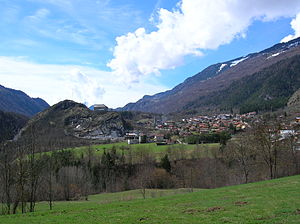
- Auvergne-Rhône-Alpes
- Provence-Alpes-Côte d'Azur
The French Alps are well connected to the rest of the country. The nearest international airport is Grenoble Isère Airport . Lyon and other cities have a direct TGV (fast train) to Paris. Many towns are also connected by TGV or ordinary trains. There are also highways in many valleys. There is also the international airport of Geneva ( Switzerland ) nearby.
- Albertville (Winter Olympic Games in 1992)
- 45.899167 6.129444 1 Annecy
- 45.566389 5.920833 2 Chambéry
- 45.186944 5.726389 3 Grenoble (Winter Olympic Games in 1968)
Other destinations
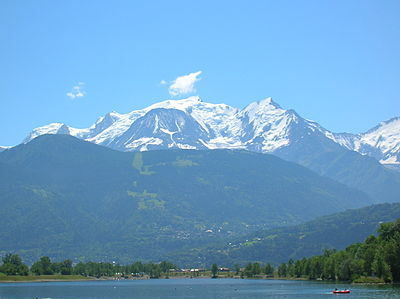
Ski resorts
- 45.09 6.07 1 Alpe d'Huez
- 45.4525 6.566667 2 Brides les Bains (part of Les Trois Vallées )
- 45.922222 6.868889 3 Chamonix (Winter Olympic Games in 1924)
- 45.415 6.633889 4 Courchevel (part of Les Trois Vallées ; 2030 Winter Olympics)
- 45.904167 6.423056 5 La Clusaz
- 46.007 6.68312 6 Le Grand Massif
- 45.571667 6.807778 7 Les Arcs
- 45.007222 6.121667 8 Les Deux Alpes
- Les Menuires (part of Les Trois Vallées )
- 45.35 6.6 9 Les Trois Vallées (Winter Olympic Games 1992)
- 45.401111 6.565556 10 Meribel (part of Les Trois Vallées ; 2030 Winter Olympics)
- 45.856944 6.6175 11 Megève
- 46.174757 6.806054 12 Portes du Soleil
- 44.648611 6.64 13 Risoul (part of La Forêt Blanche)
- 45.469722 6.909444 14 Tignes / Val d'Isère
- 45.298056 6.58 15 Val Thorens (part of Les Trois Vallées )
- Vars (part of La Forêt Blanche)
Water sports
- Lake of Aiguebelette
- Lake of Annecy
- Lake of Bourget
- Lake Geneva - the Societe Nautique de Geneve and the mercenary team of Alinghi hold the America's Cup.
The primary language in the French Alps is French, although as with any other tourism hotspot, don't be surprised if your broken French is met with well spoken English.
Due to the mountains, you can't fly directly into the French Alps, however, you can fly to surrounding airports and arrange transfer from there. There are many companies that specialise in airport transfers from local airports to all the major ski resorts. The major local airports are in Grenoble and Chambéry .
One of the best ways to get around the Alps is renting a car. It gives you the freedom to go wherever you please while you're there and take in all the wonderful scenery. As a major tourist location, there are plenty of car rental agencies to help you do this.
The tallest mountain in the Alps and in Europe (outside the Caucasus) is Mont Blanc in Haute-Savoie, which stands at 4,807 m (15,767 ft), so it's definitely worth a look if travelling to the Alps. Lake Geneva is another natural landmark that can be seen in this area.
The beautiful terrain around the French Alps means that there is plenty to do all year round and that people can try a range of diverse and exciting activities. The area is of course most famous for its skiing however visitors flock to the area for a variety of other activities including mountain biking, hiking and mountaineering.
The French Alps have also great many restaurants and are especially famous for its numerous varieties of cheese.
The popularity of the Alps, particularly for skiing, has led to very high prices, especially for drinks. It is not unusual to pay more than €4 for a small glass of beer in a mountain bar.
- Has custom banner
- City listing with no coordinates
- Has map markers
- All destination articles
- Extra regions
- Region articles
- Has Geo parameter
- Pages using the Kartographer extension
Navigation menu
The Alps and Franche-Comté Travel Guide
Book your individual trip , stress-free with local travel experts
Select Month
- roughguides.com
- the-alps-and-franche-comte
- Travel guide
- Itineraries
- Local Experts
- Travel Advice
- Accommodation
Plan your tailor-made trip with a local expert
Book securely with money-back guarantee
Travel stress-free with local assistance and 24/7 support
I would give this 6 stars if the ratings went that high! This really was one of the highlights of our vacation. Due to scheduling issues, we ended up with ...
The wild and rugged landscape of the Alps , formed by the collision of continental tectonic plates over tens of millions of years, and the eroding actions of multiple glaciers and fast-flowing rivers, contains some of Europe’s most stunning mountain landscapes. King of all it surveys, and Europe’s highest peak, is Mont Blanc , which sits pretty over the Chamonix valley below, itself the region’s premier sporting playground. On offer are some of the most thrilling outdoor activities on the continent, from world-class skiing and mountain climbing, to superb road cycling and the most gentle of valley walks. While resorts like Chamonix absorb the lion’s share of adrenaline-seeking visitors to the Alps, there are excellent alternatives, notably the Queyras and Écrins national parks.
Chambéry and around
The chartreuse massif, cross-country skiing and mountain biking in the jura mountains, food and drink in the alps and franche-comté, hiking and climbing in the alps and franche-comté, lons-le-saunier and around, the route des grandes alpes, skiing in the alps, skiing in the savoie, the isère valley and the vanoise, vauban and his fortresses.
Yet you’ll also find plenty of charming villages and towns to explore, notably Grenoble , the economic capital of the Alps, which possesses a vibrant nightlife and lively cultural scene. Chambéry , too, offers stimulating cultural attractions alongside some wonderful Italianate architecture, while easy-going Annecy is a town whose picture-postcard lakeside setting is sure to delight. Close by, the genteel spa resort of Aix-le-Bains presents further possibilities for lake-bound fun, as does Lake Geneva , whose pristine shoreline is punctuated by well turned-out towns and villages like Evian and Yvoire . Further south, Briançon , one of the highest towns in Europe, offers Vauban’s formidable fortress as a reminder of the tumultuous past of this region on France’s eastern frontier.
The region of Franche-Comté , which lies to the northwest of Lake Geneva, was once ruled by the Grand Dukes of Burgundy, and annexed by France in the late seventeenth century. The four départements of Franche-Comté – the Territoire de Belfort, the Haute-Saône, the Doubs and the Jura are generally far more rural and less touristy than those in Rhone-Alpes. The region’s capital, Besançon , is an attractive town built around imposing fortifications, developed by the French military engineer Vauban during the late 1600s.
Lying in the rich agricultural valley to the south of Besançon, the quiet town of Lons-le-Saunier provides a gateway to the Jura Mountains to the east. Composed of gentle, forested slopes in the west, of more sheer crags in the east and of high-forested plateaux in between, these mountains have long been popular for cross-country sking, but the varied terrain also provides plenty of good trails for hikers. Note that the official département of Jura in the south of Franche-Comté does not contain the whole of the mountain range commonly known as the Jura; these mountains also stretch northward into the Doubs département as well as into Switzerland. A particular highlight in these mountains is the Région des Lacs , which possesses beautiful lakes, pine forests and small farming communities as well as ski resorts. At the northern tip of the region is the historic town of Belfort , a rewarding destination in itself, and, one that makes a handy base for exploring the area.
Travel ideas for France
Created by local experts

An active walking tour out of the way in France
Your trip starts with an in-depth introduction to France in Paris: several unique day excursions connect you with local Parisians to show you their city and way of life. Afterwards continue south to start a few days walking journey through Southern France before ending around Avignon.

Southern France – Walks in the Alpilles and Lavender fields
Start your tour in the coastal city of Marseille, exploring Cassis on the way. Around the Alpilles in Provence, you will be provided with detailed walking materials to explore the area on foot, from both Les Baux and St Remy. End your tour in famous Avignon.

Tasting Eastern France
A delicious yet active journey through Eastern France. Start your trip in Lyon with some unique food tours before setting off on a 4-day walk across the Beaujolais region. Almost every day ends with a wine tasting in your guesthouse, soothing for body and soul.

Taste of Three - Belgium, France and Switzerland
Start your journey in Belgium and explore Brussels, Ghent and Bruges. A high-speed train will then take you to Strasbourg, from where you'll discover the Alsace. Proceed to Basel as your base, from where you'll see plenty of Switzerland: Zermatt, Matterhorn, Mount Pilatus and much more.
Lying 50km to the south of Lake Geneva, Annecy , set on a sparkling turquoise lake, the Lac d’Annecy, is one of the most beautiful and popular resort towns of the French Alps. It enjoyed a brief moment of political and religious importance in the early sixteenth century, when Geneva embraced the Reformation and the Catholic bishop, François de Sales, decamped here with a train of ecclesiastics and a prosperous, cultivated elite.
These days, the delights of the town lie not just in its historical monuments, like the imposing château on the hill or the stronghold of the Palais de l’Île closer to the lake, but also in the stunning scenery. Annecy’s old town is a bewitching warren of passages and arcaded houses that date from the sixteenth century and are divided by peaceful little branches of the Canal du Thiou . Many of the houses here are ringed by canalside railings overflowing with geraniums and petunias in summer; added to the cool shade offered by the arcades, these flowers make the town’s pedestrianized streets a delight to wander around on a sunny day. At the height of summer, however, you can barely move for the crowds, so you’d do well to take to the streets as early as you can in the morning.
Nestled in the gap between two mountain ranges – the Vosges to the north and the Jura to the south – lies Belfort , a town assured of a place in French hearts for its history as an insurmountable stronghold on this obvious route for invaders. The town is remembered particularly for its long resistance to a siege during the 1870 Franco–Prussian War; it was this resistance that spared it the humiliating fate of being annexed into the German empire, a fate suffered by much of neighbouring Alsace-Lorraine. The commanding officer at the time was one Colonel Denfert-Rochereau (known popularly as the “Lion of Belfort”), who earned himself the honour of numerous street names throughout the country, as well as that of a Parisian square and métro station.
Eurockéennes
First staged in 1989, today Eurockéennes is one of France’s biggest and most diverse annual rock festivals, attracting top international artists as well as plenty of up-and-coming French acts. The three-day festival takes place over the first weekend in July in a lovely setting on the shores of the Lac du Malsaucy , 6km northeast of Belfort , and the vibe is suitably relaxed and friendly, despite crowds of 100,000 or more. There’s a free campsite nearby with 12,000 spaces for those who want the full rock festival experience.
The capital of Franche-Comté, B esançon , is an attractive town of handsome stone buildings that sits between the northern edge of the Jura Mountains and a loop of the wide River Doubs. It is this natural defensive position that has defined the town’s history. Besançon was briefly a Gallic fortress before Caesar smashed the Gauls’ resistance in 58 BC. Strong outer walls were developed during the Middle Ages and the indefatigable military engineer Vauban added the still-extant citadelle in the seventeenth century in order to guard the natural breach in the river, and a large French army presence remained in the area until well into the twentieth century.
For the most part, visitors are unlikely to stray far from the old town which is squeezed into a tight loop of the Doubs. Its pedestrianized streets and narrow walkways conceal a wealth of good museums and cosy cafés.
Nestling in a valley to the north of the Chartreuse Massif, the town of C hambéry commands the entrance to the mountain passes which lead towards Italy, and has thus held an important strategic position for the various armies and merchants who have crossed the Alps over the centuries. The town grew up around the château built by Count Thomas of Savoie in 1232, and became the Savoyard capital, enjoying a golden age in the fourteenth and fifteenth centuries. Although superseded as capital by Turin in 1562, it remained an important commercial and cultural centre, and the philosopher Rousseau spent some of his happiest years in the town during the 1730s. Only incorporated into France in 1860, modern Chambéry is a bustling provincial town with a wealth of grand Italianate architecture and a strong sense of its regional identity.
Around 13km north of Chambéry is the spa resort of Aix-les-Bains , with its famous thermal baths, as well as the Lac du Bourget , one of the best sites in the country for watersports.
Aix-les-Bains
Thirteen kilometres north of Chambéry is Aix-les-Bains , one of France’s premier spa resorts. The town’s waters have been famous for their healing qualities since Roman times but most of the elegant buildings here date from Aix’s belle époque heyday of the late 1800s, when members of European high society dropped by to relax and take the waters; Queen Victoria was a frequent visitor. These days, Aix-les-Bains is a sedate and genteel place, with thousands of French pensioners descending on the town throughout the year for state-funded thermal treatments. The spa centre, Les Thermes Nationaux d’Aix-les-Bains was formerly housed in the impressive (though now sadly redundant, save for the tourist office) Art Deco building on place Maurice-Mollard, but these days you’ll find it at Thermes Chevalley , a five-minute walk uphill behind here on route du Revard. There are also some parks to amble through and plenty of cafés where you can sit back with a pastis and watch the world go slowly by. Aix is also the best base for enjoying the sights and outdoor activities at the nearby Lac du Bourget.
Connected to the River Rhône by the Canal de Savières, the Lac du Bourget is France’s biggest natural lake, at 18km long and 3.5km wide, and a place of great beauty, a protected wildlife reserve and home to the now scarce European beaver. “Nowhere could one find such perfect concord between water, mountains, earth and sky”, enthused the nineteenth-century French writer Balzac, and it’s clear what attracted him and so many other poets and artists to this place. The lake’s “Côte Sauvage” rises precipitously above the sparkling blue water on its western bank, which is dominated at its southern end by the looming presence of the Dent du Chat (1390m).
Nestling a short way north of Grenoble, the Chartreuse massif is a place of spectacular landscapes, including sharp limestone peaks, mountain pastures and large areas of pine forest. Designated in 1995 as the Parc Naturel Régional de Chartreuse the landscape provides wonderful opportunities for all manner of recreational pursuits. The Maison de la Montagne office in Grenoble can offer advice on many of these activities, and also publishes descriptions of the various hiking routes in the area. The massif’s main local landmark is the Grande Chartreuse Monastery , situated up the narrow Gorges des Guiers Morts, southeast of St-Laurent-du-Pont, and some 35km from Grenoble.
The high plateaux of the Jura mountains guarantee good snow cover in winter, but they also lack the steep gradients of the Alpine peaks further to the south; it is this high but level terrain which has made the Jura into France’s most popular destination for cross-country skiing , or ski de fond . The goal of any superfit fondeur is the 175km Grande Traversée du Jura (GTJ), which crosses the high plateau from Villers-le-Lac to Giron, a town in the south of the Parc Naturel Régional Haut Jura.
The same gentle topography and established infrastructure that enable cross-country skiing have made this region an ideal high-summer venue for mountain biking , with hundreds of waymarked cross-country skiing pistes used out of season as trails for adventurous mountain bikers. The 360km GTJ–VTT , which starts near Montbéliard (just to the south of Belfort), has become the greatest long-distance biking challenge in the area. Many people cycle on the road; there aren’t many cars, so if you can handle the hills, then go for it.
Most characteristic of Alpine cuisine is the liberal amount of cheese made from the local cow, ewe and goat milk. The fromageries of Franche-Comté and the Northern Alps are full of cheeses like Roblochon, Tome des Bauges, Emmental, Chèvre, Comté and Beaufort. These are found not just in the famous fondue, but also raclette and tartiflette (both cheese-based dishes served with ham and potatoes). Other cheeses worth seeking out include the smooth blue-veined Bleu de Gex, produced exclusively in the Pays de Gex region, and creamy Saint Marcellin, from the Grenoble area.
Many restaurants feature fish (notably salmon and trout) from the Alpine lakes and use locally grown herbs, like thyme, basil and rosemary. These herbs are particularly in evidence in the Southern Alps around Briançon, where they are often used to flavour the saucisson (cured sausage), which you’ll find in many a morning shopping market.
The region produces many light and fruity varieties of wine , of which the most popular is the dark red Mondeuse, with its faint taste of raspberries. By contrast, the expensive vin jaune from the Jura is a potent, golden wine, made from Sauvignon grapes with a fermentation process similar to that of sherry – it remains in the cask for 6–10 years before being bottled. Vin jaune is a favourite accompaniment for the local cheeses of Franche-Comté, and is used in speciality dishes such as poulet au vin jaune (chicken in a creamy sauce flavoured by the wine). It’s also worth sampling some regional liqueurs . The most famous of these is undoubtedly Chartreuse , the drink produced by Carthusian monks since the sixteenth century, which contains 130 different herbs and is known as the “elixir of life”, while Chambéry is famous for its high-quality vermouth , including the unique Chambéryzette, flavoured with strawberries.
Set serenely at the confluence of the Drac and Isère rivers, Grenoble , the self-styled “capital of the Alps”, is, at just 213m above sea level, France’s lowest city, watched over by the snowcapped peaks of the Belledonne, Vercors and Chartreuse massifs. It’s a vibrant and cosmopolitan place, home to more than sixty thousand students and a lively cultural scene, while at its centre is a quirky maze of streets, where modern and medieval buildings are packed close together. Its restaurants and cafés, meanwhile, provide relaxing spots in which to sit and admire the grandeur of this fantastic mountain setting.
Settled by the Celtic Allobroges tribe, who called their settlement Cularo, it was renamed Gratianopolis by the Romans in the fourth century and became the seat of a bishop. The city was annexed by France in the fourteenth century, and it was here, far from Paris, that a local uprising in 1788 (known as the Journée des Tuiles) initiated the French Revolution. Grenoble is the final stop on the Route Napoléon; the French emperor arrived here on March 7, 1815, declaring “Before Grenoble, I was an adventurer. In Grenoble, I was a prince.” The prosperity of the city was originally founded on glove-making, but in the nineteenth century its economy diversified to include industries as varied as mining and hydroelectric power, while more recently it has forged a reputation as a centre for scientific research in the electronic and nuclear industries.
Fort de la Bastille
The Bastille’s main draw is its spectacular views . At your feet, the Isère flows under old bridges which join the St-Laurent quarter (a home for Italian immigrants in the late 1800s) on the northern bank of the river to the nucleus of the medieval town. Even this far south, if you look northeast on a clear day you can see the distant white peaks of Mont Blanc further up the deep valley of the Isère. To the east, snowfields gleam in the high gullies of the Belledonne massif (2978m). To the southeast is the peak of Le Taillefer (2807m), while further to the south you can make out the mountain pass which the famous Route Napoléon crosses on its way northwards from the Mediterranean. This was the road towards Paris that Napoleon took after his escape from Elba in March 1815. Finally, to the west you can admire Moucherotte (1901m), the highest peak of the Vercors massif, and the mountain which most seems to dominate the city beneath.
Musée de Grenoble
A vast modern complex down by the riverbank, the Musée de Grenoble is home to one of the country’s most prestigious art collections. The classical wing has a fine spread of masterpieces spanning the thirteenth to nineteenth centuries. Pieces by Rubens,Veronese, and Canaletto take centre stage in the first few rooms, followed by nineteenth-century luminaries Gauguin, Renoir, and local hero, Henri Fantin-Latour. Once you’ve absorbed those, there is still a further two dozen or so rooms of twentieth century and modern art to negotiate, including works by Chagall, Matisse, Picasso and Warhol, to name but a few. If you can summon the energy, take a peek at the basement collection of Egyptian antiquities.
There are seven national or regional parks in the area covered by this chapter: Vanoise , Chartreuse , Bauges, Écrins , Queyras , Vercors and Haut Jura. All of these contain gentle day-walks and more demanding treks – not least classic long-distance paths like the Tour du Mont Blanc – which require one or two weeks’ walking. Most of these routes are clearly marked and dotted with refuge huts; the routes are also described in high detail by the Topo-guides guidebooks. Nonetheless, even the most experienced walkers or skiers treat these mountains and their unpredictable weather conditions with due respect. Even low-level walks in the Alps during summer often require a good level of fitness and specialist equipment, such as crampons or ice axes. You should take account of the weather conditions (which can vary considerably between the valleys and peaks), of the potentially debilitating effects of high altitude, and of the serious danger of avalanches.
The Alps were the first great centre for European rock climbers in the nineteenth century and still offer countless routes that can be enjoyed by both novices and world-class climbers. A more recent development has been the creation of via ferrata courses, in which wires and ladders are bolted onto the rock so that even inexperienced climbers (wearing harnesses and ropes) can make ascents which would otherwise be impossible for them. There are via ferrata courses being developed across the whole region, but at present two of the largest centres for this popular sport are at Serre Chevalier and in the Parc National des Écrins.
The Bureau Info Montagne office in Grenoble and the Office de Haute Montagne in Chamonix can provide information on the best guides and the most up-to-date information on all the GR paths and the best via ferrata courses, while local tourist offices often produce detailed maps of walks in their own areas.
The origins of the sleepy little spa town of Lons-le-Saunier date back to Roman times, although most of the town was destroyed by a fire in the early seventeenth century, and much of the old town you see today dates mainly from the 1700s. Lons was once a major, and very prosperous, centre for winemaking and salt production, and the legacy of this era can still be seen in the grand townhouses and public buildings. These days it’s a rather quiet place, but there’s a handful of sights worth spending a lazy afternoon looking over. A good day to visit is Thursday, as that’s when people from all over roll into town for the enormous market .
The ideal place to start your tour of the town is the sunny place de la Liberté , where the theatre clock at the eastern end chimes a familiar half-dozen notes from La Marseillaise to honour Lons’ most famous citizen, Rouget de Lisle; he composed the anthem during his time as a campaigner in the French revolutionary army during the early 1790s.
The Région des Lacs
If you drive east for 20km along the N78 road from Lons, you’ll enter the Région des Lacs , an area of woods, pastures and lakes strung out along the valley of the River Ain. During the journey, the road begins its ascent to the peaks and gorges that define the border with Switzerland. With each bend in the climbing road, the views down to the tiny villages become all the more impressive. Some of the lakes charge parking fees during the day, but after 6pm, when the crowds and swimming supervisors have gone home, they are deserted and serenely peaceful – the perfect place for an evening picnic at sunset.
Winding its way over mountain passes and secluded valleys all the way from Thonon-les-Bains to Menton on the Mediterranean coast is the most renowned tourist route of the French Alps, the 684km Route des Grandes Alpes . The route crosses six Alpine passes over 2000m, three of which – the Col de la Cayolle, the Col de l’Izoard and the Col de Vars – were only paved in 1934. The complete route opened in 1937 and has been a popular touring route for drivers, walkers and cyclists ever since. It can be covered in a couple of days by car, but only by rushing through the stunning mountain landscapes and intriguing settlements (including Morzine, Valloire, Briançon and Barcelonnette) that line the route.
With their long and varied runs, extensive lift networks, and superb après-ski, the French Alps offer some of the best skiing not just in Europe, but in the world. Skiing first became a recreational sport here in the early 1900s but the industry really began to boom in the Alps during the 1960s with the construction of dozens of high-altitude, purpose-built resorts that ensured good lasting snow cover. Some of these resorts have their detractors: the modern architects often created sprawling concrete settlements that had little in common with the traditional farming villages lower in the valleys, and in so doing they earned France a lasting reputation for “ski factories”. Nonetheless, few can knock the efficiency of these resorts. They have an abundance of hotels, equipment outlets and ski schools, while at many you can simply clip your skis on at the hotel door and be skiing on some of the most challenging pistes on earth within minutes.
Although downhill is the most common form of the sport at all the resorts, cross-country or nordic skiing has become increasingly popular on gentler slopes (particularly around Morzine and in the Parc Naturel Régional du Queyras), while there are also several famous routes for ski touring (a form of cross-country skiing with uphill sections and across much longer distances), not least the Haute Route between Chamonix and Zermatt (Switzerland) and the Grande Traversée des Alps , which leads south from Thonon-les-Bains on Lake Geneva through several national parks. There are also plenty of opportunities for snowboarding with many resorts having developed snow parks expressly for snowboarders.
The ski season runs from December to late April, with high season over Christmas and New Year, February half-term and (to a lesser extent) Easter.
Unquestionably, the Savoie region offers some of the world’s greatest skiing . To begin with, there’s Les Trois Vallées , one of the world’s largest linked skiing areas, with endless off-piste possibilities. Its four component resorts are glitzy Courchevel , which also has by far the finest restaurants of any French ski resort; ugly and family-oriented Les Menuires ; Val Thorens , favoured by younger crowds and the snowboarding set; and Méribel , traditionally dominated by British tourists, and which therefore perhaps explains its status as the party capital of the Three Valleys. Despite the British imports, though, the small wooden chalets which climb the eastern side of the valley do manage to give the resort a traditional Savoyard feel. Less well known is the Paradiski ski area, on the slopes above Bourg-St-Maurice, which comprises the resorts of Les Arcs and La Plagne , linked together by a giant double-decker téléphérique that swings over the Ponthurin valley. The former is accessible from the town via a funicular railway, and offers excellent snow and terrain for all levels, while La Plagne is made up of ten resorts high above the Isère valley, with plenty of opportunities for both beginners and more advanced skiers. Beyond here, the world-famous resort of Val d’Isère , site of the 1992 Olympic downhill, offers some of the most varied and demanding skiing in the country, including year-round skiing on its glacier.
The Massif de la Vanoise , a rugged set of mountains east of Chambéry, rises to heights of over 3500m, and offers challenging routes for skiers, particularly along the steep slopes of the Isère valley . The glacier-capped southeast quadrant of the Vanoise forms the Parc National de la Vanoise , where hikers will find some of the most spectacular GR trails in France. The easiest road access to the Massif is from Chambéry or Grenoble, although driving the winding and precipitous old highways from Annecy or Chamonix is an adventure in itself.
The A43 from Chambéry cuts between the Massif des Bauges to the north and the Vanoise to the south, following the path of the lower Isère River as it flows down from Albertville. Following the river by road from here involves a 180km journey south, north and south again back to its source high in the mountains near the Col de l’Iseran (2770m), close to the Italian frontier. From Albertville, the N90 climbs southeast along the bends of the Isère River for 50km to Moûtiers, the turn-off for the massive Les Trois Vallées ski region. At Moûtiers, the river course swings northeast and following it will lead you to Bourg-St-Maurice , the town at the midpoint of the upper Isère valley. At Séez, a couple of kilometres further east, the road comes to an important junction: the N90 continues to climb steeply towards the Col du Petit St-Bernard (2188m), while the D902 heads south towards Val d’Isère .
Walking in the Parc National de la Vanoise
The Parc National de la Vanoise occupies the eastern end of the Vanoise Massif. It’s extremely popular, with over 500km of marked paths , including the GR5 , GR55 and GTA (Grande Traversée des Alpes), and numerous refuges along the trails. For in-depth information on the various routes, head for the tourist offices in Val d’Isère, Bourg-St-Maurice and Méribel.
To cross the park, you can take the GR55 from the Lac de Tignes and over the Col de la Vanoise . You can then connect with the GR5 , which brings you out at the southern end of the park in the town of Modane. There are countless shorter but equally beautiful walks in the park. Settlements in the Arc Valley, like Bessans, are decent bases to start exploring the park, but even the ski resorts of Tignes, Val d’Isère and Méribel are good starting points.
The citadelle in Briançon is just one example (albeit a spectacular one) of the many fortifications built on France’s eastern borders by Sébastien Le Preste de Vauban (1633–1707), a Marshal and engineer in the army of Louis XIV. In all, Vauban built 33 fortresses and strengthened countless others in order to defend the new lands won by Louis , the so-called “Sun King” , during the wars of the seventeenth century. Vauban was highly innovative in the design of his fortresses, which were often built in the shape of a star so that the various defensive bastions could defend each other with covering fire. The other spectacular fortifications planned and constructed by him in the Alps and Franche-Comté are the citadelles at Besançon and Mont-Dauphin. Twelve of Vauban’s fortresses, dotted around France, are now included on UNESCO’s World Heritage List.
Top image: Annecy, France © Elenarts/Shutterstock
Discover more places in France
- The Hautes-Alpes
- Lake Geneva
The Rough Guides to France and related travel guides
In-depth, easy-to-use travel guides filled with expert advice.
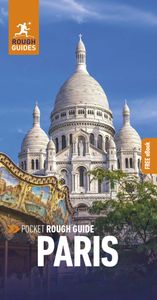
Find even more inspiration for France here

Planning your own trip? Prepare for your trip
Use Rough Guides' trusted partners for great rates
written by Rough Guides Editors
updated 10.09.2021
Ready to travel and discover France?
Get support from our local experts for stress-free planning & worry-free travels.
- Travel advice
- Where to stay
Our local experts can design your trip based on your preferences

Warning - You are using an outdated browser. Please upgrade your browser to properly view this website.

- Destinations
- French alps
French Alps travel guide
The high, snow-capped mountains, pristine lakes and the elegant spa towns of Savoie are not just for skiers and snowboarders. Vast fields of wild flowers welcome the spring visitor, and in summer horse riding, mountain biking, tennis, rafting, hang-gliding and paragliding now join the more traditional activities of climbing and hiking – all lorded over by the magnificent Mont Blanc , Europe’s highest mountain.
Places to visit in the French Alps
The lake and small city of Annecy are both associated with Jean-Jacques Rousseau. It was here, soon after his flight from Geneva, that he first met Madame de Warens. Like most cities around Lake Geneva on both the French and Swiss sides, Annecy was a town of lake-dwellers in prehistoric times. It derives its name from an ancient Roman estate, the Villa Aniciaca . Annecy developed in the 12th century, when its fortress was constructed. Its most famous citizen, Rousseau aside, was Saint François de Sales, who became a priest in 1593 and entered into the Wars of Reformation against the Calvinists.
The lovely old town of Annecy is picture-perfect with its triangular-shaped, 12th-century Palais de l’Isle in the middle of the Thiou river. The main street, the Rue Ste Claire , is lined with ancient arcaded buildings intersected by canals. Cars are forbidden in parts. The 17th-century church of St François , the 16th-century château and the Cathédrale St François de Sales constitute the other major landmarks.
The Alps’ main city is Grenoble , in a wonderful mountain setting where the River Drac joins the Isère. The birthplace of Stendhal, author of The Red and the Black, is an old and respected university town, though the campus is now in the suburbs.
The Winter Olympic Games of 1968 gave the town a push into the modern age and changed it forever. It is a many-faceted city, with chemical, computer and microchip industries, and all the noise and rush of modern traffic. But it also has a lively cultural life. A clutch of museums testify to a rich cultural heritage. The modern Musée de Grenoble has a painting collection from the 16th century onwards and includes works by Chagall and Matisse. The Musée Dauphinois in a former convent gives an idea of the history of the region – Grenoble was the capital of Dauphiné, an independent county in the Middle Ages. L’Ancien Evêché has earlier artefacts from Celtic and Roman times.
To get an overview of Grenoble, take the cable car up to the Fort de la Bastille . There is a superb view of the layout of the city and the surrounding mountains.
Chambéry became the capital city of the dukes of Savoy in 1232 and remains a largish town defended by its fortress. Its best-known monument is the Fontaine des Eléphants , built in 1838 as a memorial to a town benefactor, the Count de Boigne, and his rollicking adventures in colonial India.
Adjoining the cathedral housed in the former Franciscan monastery is the Musée Savoisien which is devoted to local Savoyard history, archaeology and fine arts. Particularly interesting are the 13th-century wall paintings. The Château des Ducs de Savoie , now home to the Préfecture, was erected as the home of the first rulers of Chambéry and then the Savoie dukes. From the Place du Château there is a fine view of the old town centre.
Chambéry is associated with perhaps the most famous French romantic, the creator of the revolutionary social contract, Jean-Jacques Rousseau. In 1728, at the age of 16, Rousseau, then an apprentice engraver who had been badly treated by his employer, ran away from his Calvinist home in Geneva.
The thermal towns of Thonon and Evian
Thonon-les-Bains is a chic little spa town sitting on a cliff overlooking the lake, with a funicular that links the upper town to the harbour where boats can be hired. The spa waters have a high mineral content and they are used to treat intestinal disorders. Fill up your water bottles with Thonon mineral water for free at the Fontaine de la Versoie in the Parc Thermal. On the Place du Château stood a fortress of the dukes of Savoy, which was destroyed by the French in 1589. The Musée Chablais is devoted to the folklore of the region. At the church of St Hippolyte (12th–17th century), Saint François de Sales preached the return to Catholicism to the wavering believers in the area.
Evian-les-Bains is the source of bottled Evian mineral water. Much of the construction along the lakeside here, including the casino, dates from 1865, when the city fathers shrewdly decided to develop “Evian water” and turn the small fortified city into a spa. The baths are open daily in the summer and Evian churns out around 40 million bottles every month. The Jardin Anglais (English Garden) fronts the lake near the port, where the Lake Geneva paddle-wheel steamers carry tourists to the towns all around the lake and make repeated journeys from Evian to Lausanne (on the Swiss side) to take French people who go to work daily in Switzerland. In summer it is possible to make a complete tour of Lake Geneva from Evian. The steamers of the Compagnie Générale de Navigation link up a total of 42 ports on both the French and Swiss sides of the lake.
Average customers rating

{{_ "pagesAdmin.destinations.overviewCulturalFeaturesIn"}} {{currentName}}
{{_ "pagesAdmin.destinations.overviewViewAllFeatures"}} {{currentName}}
{{_ "pagesAdmin.destinations.overviewHistoricalHighlights"}} {{currentName}}
{{_ "pagesAdmin.destinations.overviewViewAllHighlights"}} {{currentName}}
Read more from the travel guide to France
- Top attractions
- Historical highlights
- Cultural features
- Plan your trip
- Top restaurants
- Top cafes and bars
- Useful phrases

- Skip to primary navigation
- Skip to main content
- Skip to primary sidebar
- Skip to footer
LOVE STORIES? I share behind the scenes travel mishaps and adventures on the road. Subscribe

Helene in Between
Lifestyle and Travel blog helping Bloggers Succeed Online.
Chamonix Travel Guide: The Essential Escape in the French Alps
By Helene Sula
The Alps have always fascinated me. The illusive snow-capped peaks and jagged mountains are some of the most stunning places I've ever seen. Winter sport enthusiasts everywhere are beckoned here to experience the extreme pistes. In the spring and summer, lush green grasses and cows donning bells echo throughout the valleys. And while all the Alpine regions in Europe are beautiful, Chamonix tops them all. Literally. Mont Blanc is the highest point in Europe at a staggering 4,807 meters (15,778 feet) tall.
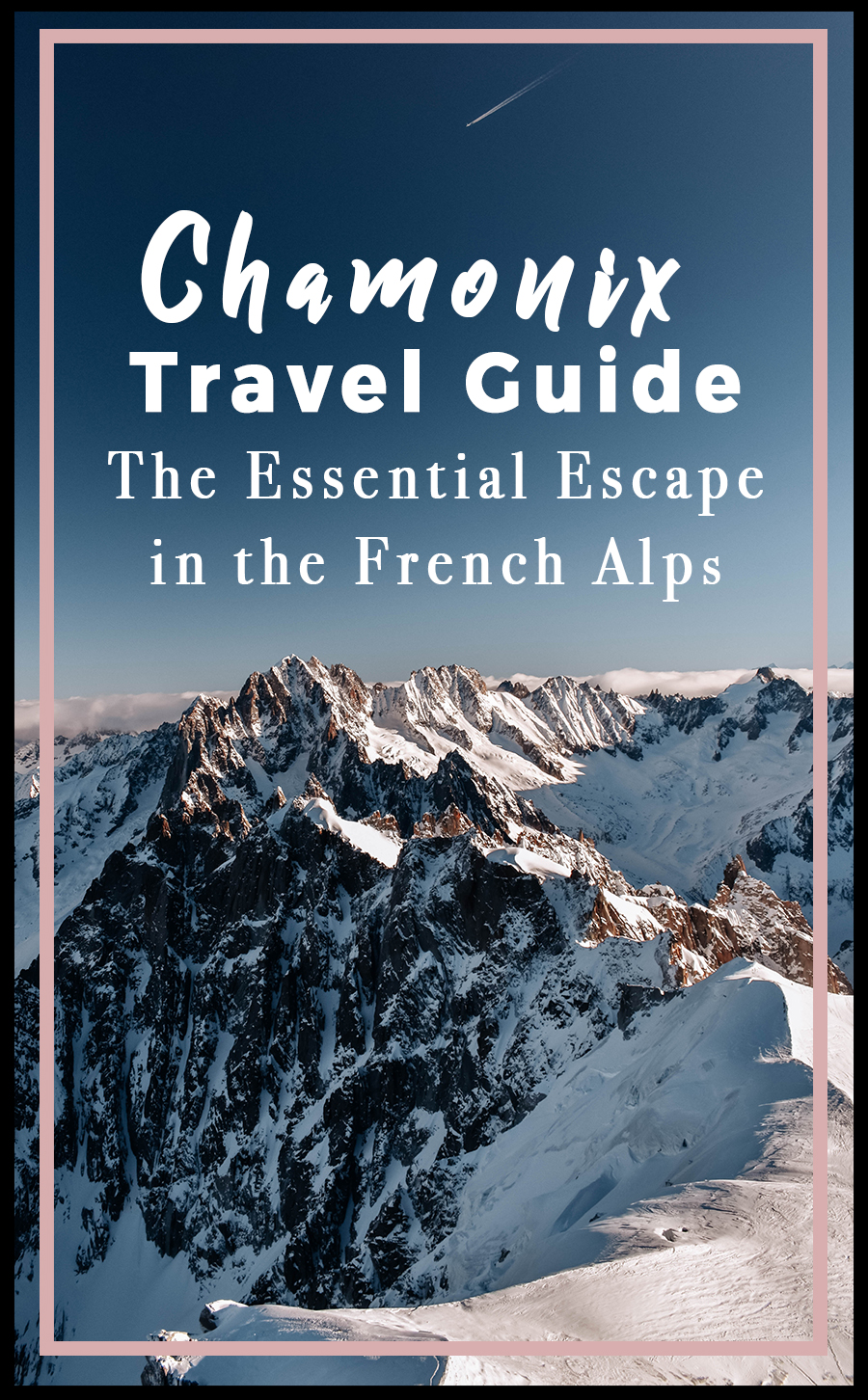
This Chamonix travel guide gives you an idea of what to see and do in this “beach on ice”oasis. Whether you're interested in exhilarating skiing or hiking, want to feast on some of the best cuisine, get a glimpse of a glacier, or just stroll around town, Chamonix is the essential escape in the French Alps.
As the host of the world's first Winter Olympics in 1924, Chamonix is an adventure lover's paradise. But it's not just about the mighty Mont Blanc, the city itself is a wonderful spot to relax and enjoy the scenery.
We had the most exceptionally beautiful weather when visiting Chamonix. I’m talking about the kind of days where the PR companies are sent out on helicopters to capture the beauty. But I have a feeling rain or shine, Mont Blanc stuns.
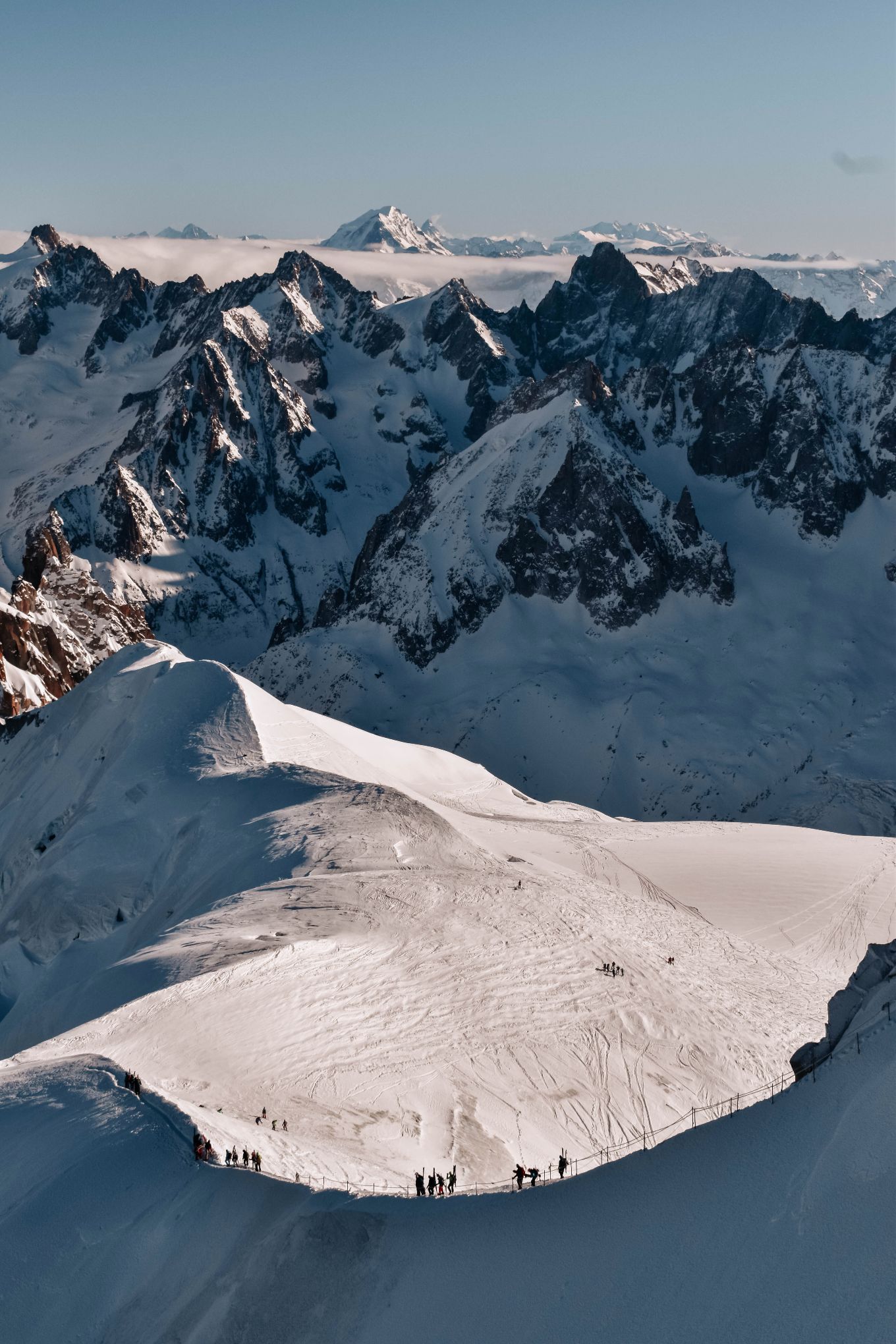
I'll give you a full guide to Chamonix, complete with where to stay, things to do, where to dine, and tips to make the most out of your trip. Make sure to look outside at the extraordinary mountains at night. The stars and moon cover the sky with the backdrop of the darkened mountains and the snow muted the night, and the world, around us. Chamonix is not a place I will ever forget.
Things to do in Chamonix
Chamonix is wonderfully accessible. This might be why Mont Blanc has claimed so many lives. Novice climbers come to take on the mountain without having a full understanding that you need to have proper training. But since I had no interest in that, I wasn’t scared. The first people to climb Mont Blanc were Jacques Balmat and physician Michel Paccard on August 8, 1786. This climb, initiated by Horace-Bénédict de Saussure, who gave a reward for the successful ascent, traditionally marks the start of modern mountaineering.
No matter what you choose to do in Chamonix, I suggest getting the Mont Blanc Unlimited pass . For €65 per person, you get access to all Ski Areas (including those in Courmayeur in Italy and Verbier in Switzerland), Aiguille du Midi, Mer de Glace, Tramway, and so much more. I find this price to be phenomenal, considering all that's included. This is a one-day pass that also includes all public transportation. Of course, you can also get the pass for more days if needed. We were able to do everything we wanted with the pass in a day so this was perfect for us.
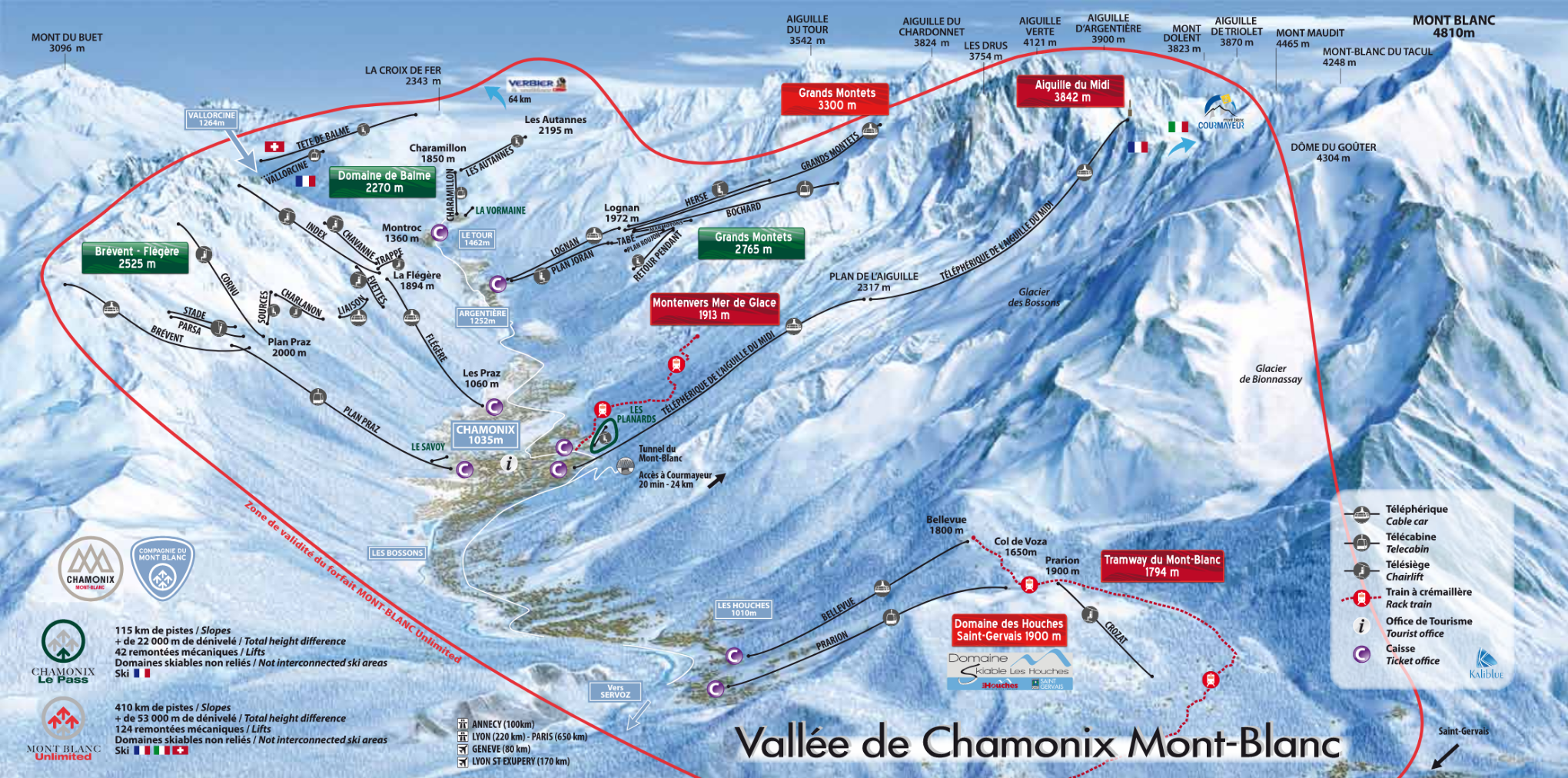
Gondola Ride to Aiguille du Midi
The clouds drifted across a blue sky and cast shadows on the sparkling white snow. The granite Mont Blanc towered over the bustling city below, and as we reached the summit, it was as if we were viewing a dollhouse, complete with a train set, from high above.
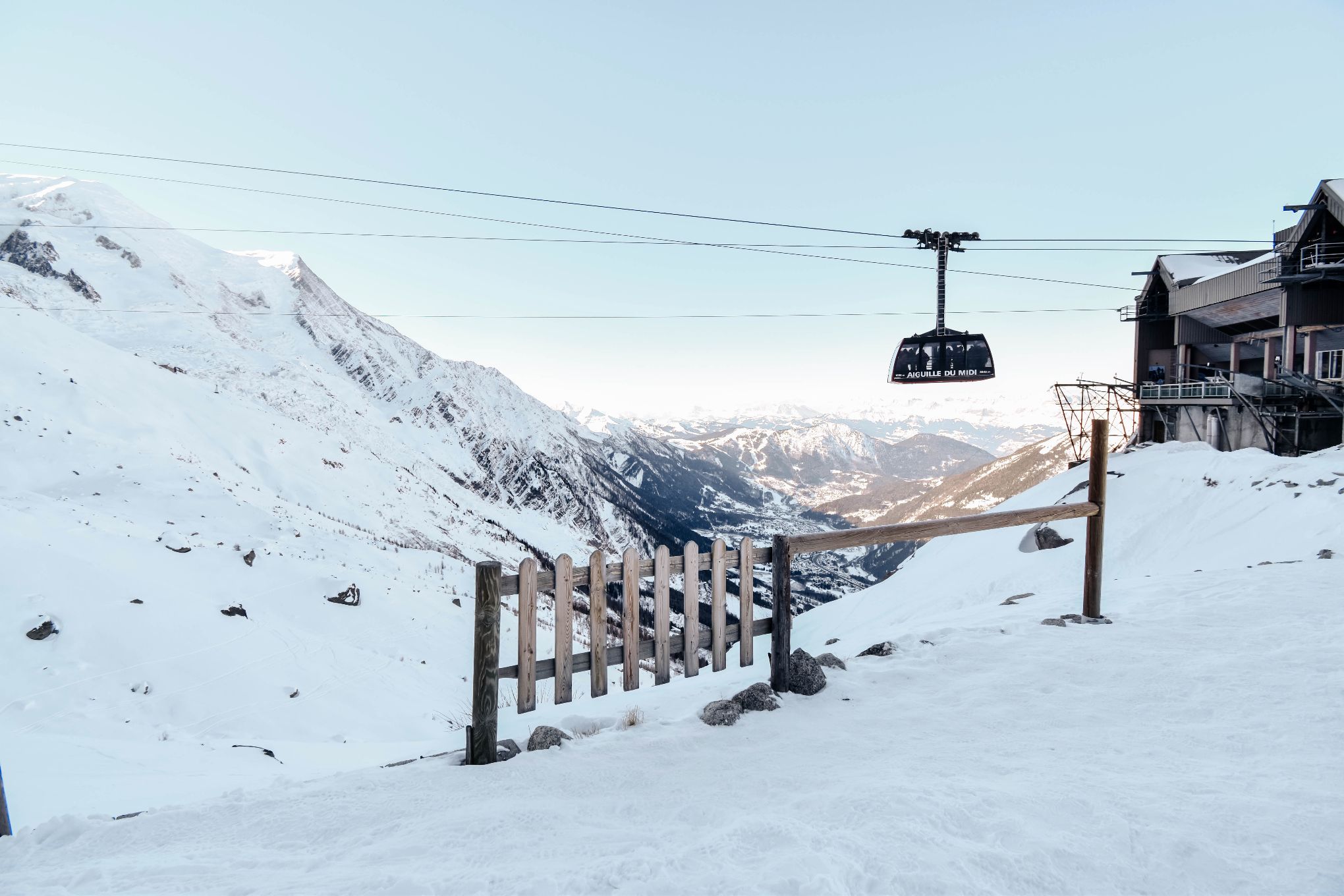
Since 1954 the gondola has carried tourists and locals up to the 12,500 foot high Aiguille du Midi. We got there early to be some of the first on the cable car. The lift is fairly large and they pack it with skiers, snowboarders, and those that just want to go up for the views. As we rose steeply into the mountain I was awestruck by the grandeur of the Alps.
The Aiguille du Midi leaves from the center of Chamonix. You start rising sharply up the mountain and feel like you're suspended in air, about to skim the side of the mountain. This cable car holds the world record for the highest vertical ascent! At the half-way point you'll arrive at Plan de l'Aiguille, where you'll see many people might start skiing from this point. Here, you'll take a second lift to the top.

Camouflaged perfectly into the alps, Aiguille du Midi is the best place to get a 360-degree view of the epic mountains. Make sure to leave some time here to explore, there's a lot to do.
Make sure the check the website to ensure the lifts are open and running.
Explore Aiguille du Midi
Not only will you find breathtaking views, but you can also get a history of the mountains in Chamonix, and those brave enough to climb Mont Blanc. This is the closest you can get to Mont Blanc without having to climb it! Aiguille du Midi means “needle of the Mid-day” and looks a bit like a needle pointing up to the sky.
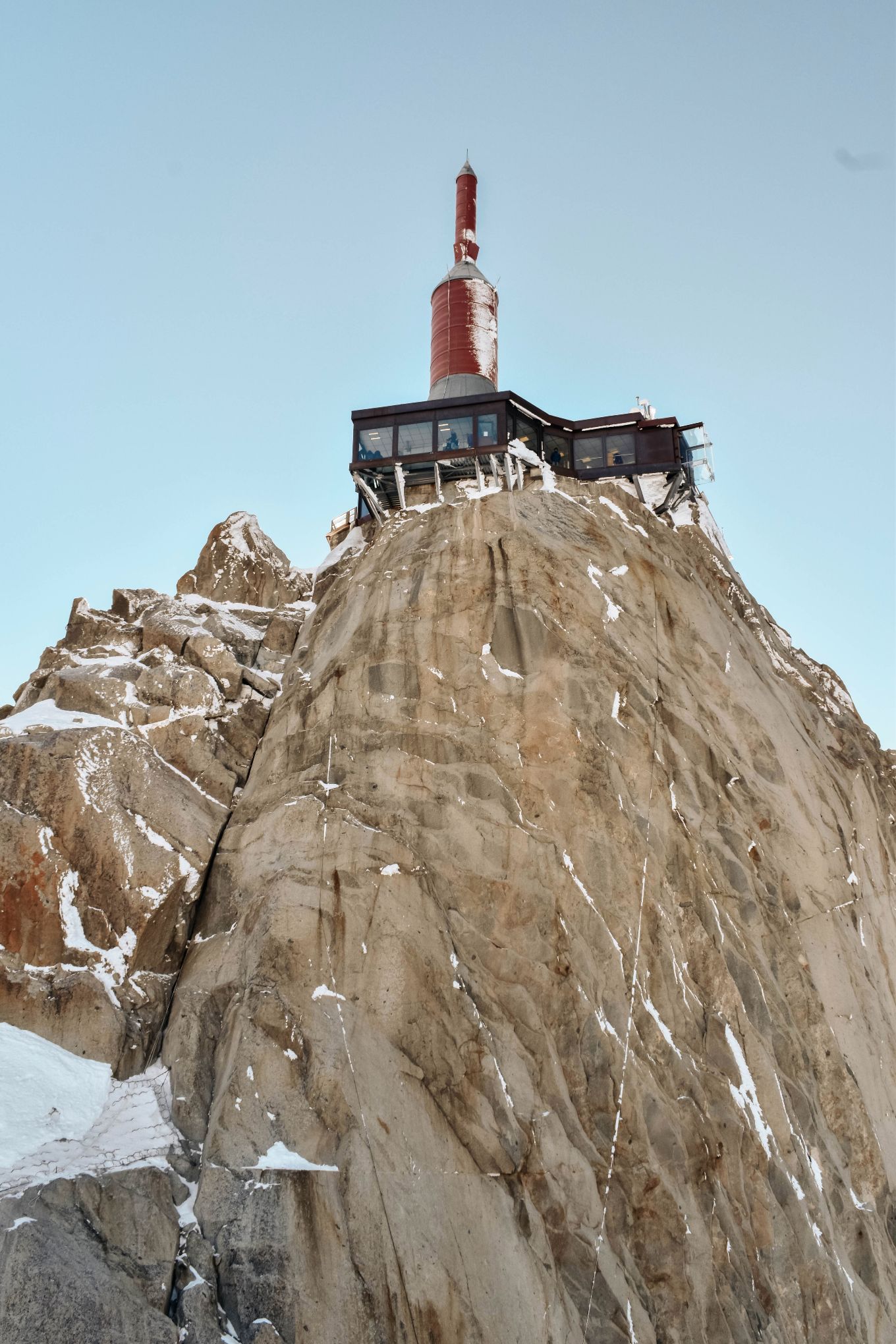
Take time to look out at the incredible views that surround you. Seeing the convergence of countries, France, Switzerland, and Italy, is mind-blowing. Look out for other peaks such as the distinctive Matterhorn in Switzerland, the Dome du Gouter, the Mount Maudit, and of course, Mont Blanc.
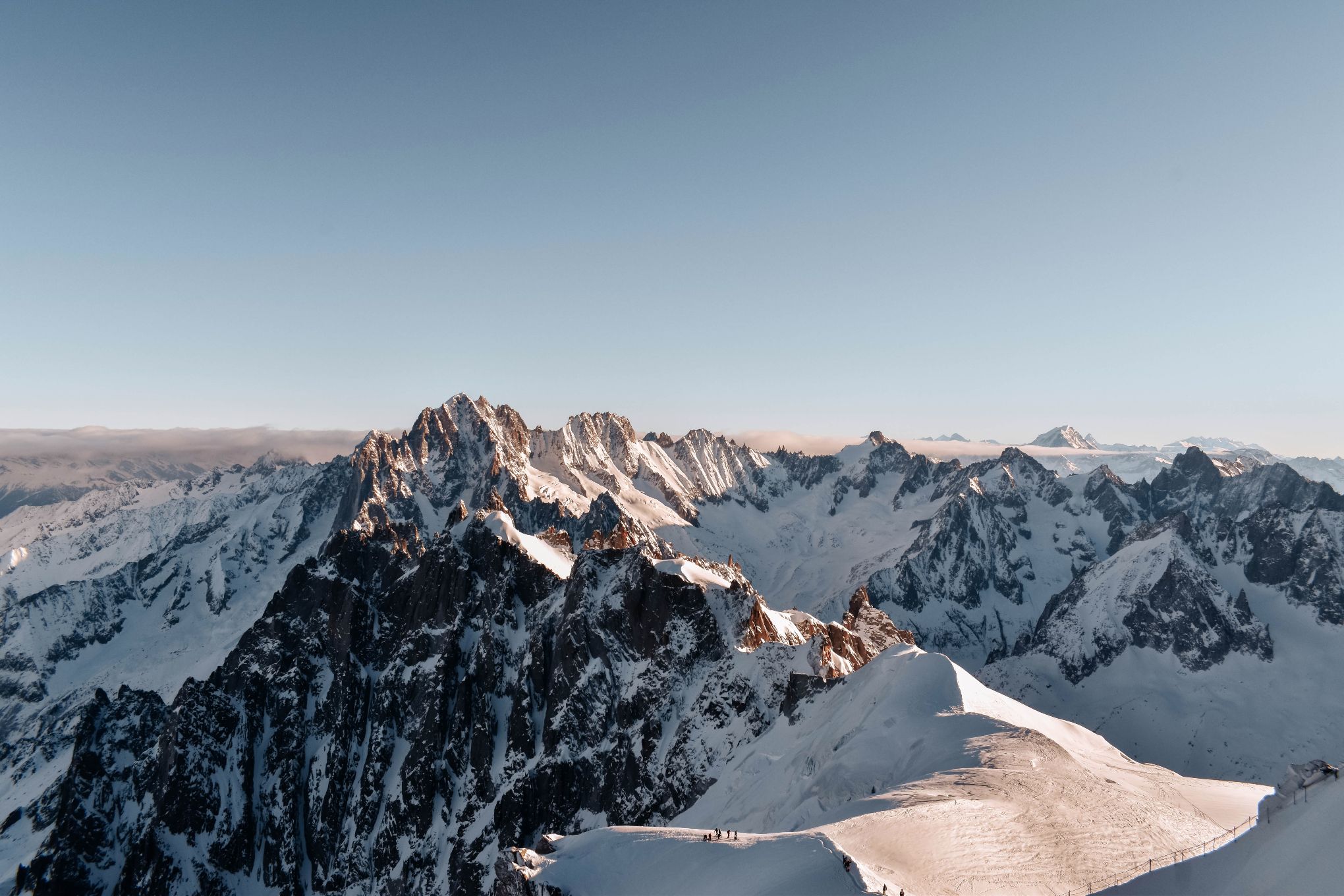
Make sure to “ Step Into the Void ” a glass cage looking over the mountains. You'll feel like you're suspended in thin air over the Alps! You need to take the elevator once you reach Midi to go to the very top and experience the view.
At the departure and arrival point there's also the History Area where you can learn more about the history of building the incredible cable car and station. For even more history, there is the Espace Vertical and Espace Mont-Blanc . The museum displays those daring enough to climb Mont Blanc and the gear that goes along with it. Here's a view of Mont Blanc from Midi:
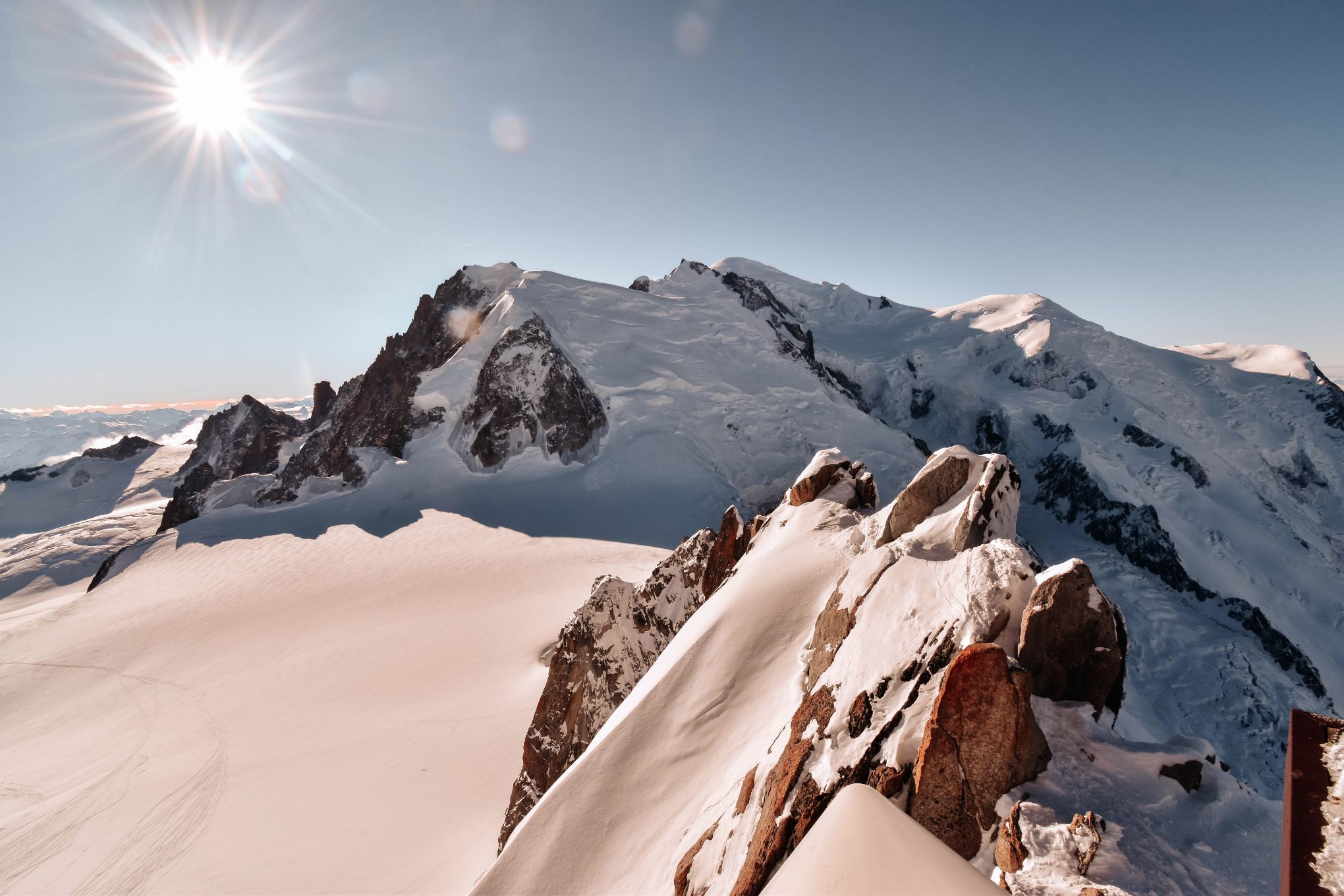
You can walk the long steel gallery, aka the “ Pipe ” or in French “Le Tube”. I also loved walking through the tunnel of snow to look at the landscape of the mountains. You'll also find a short movie showing the mountains from above.
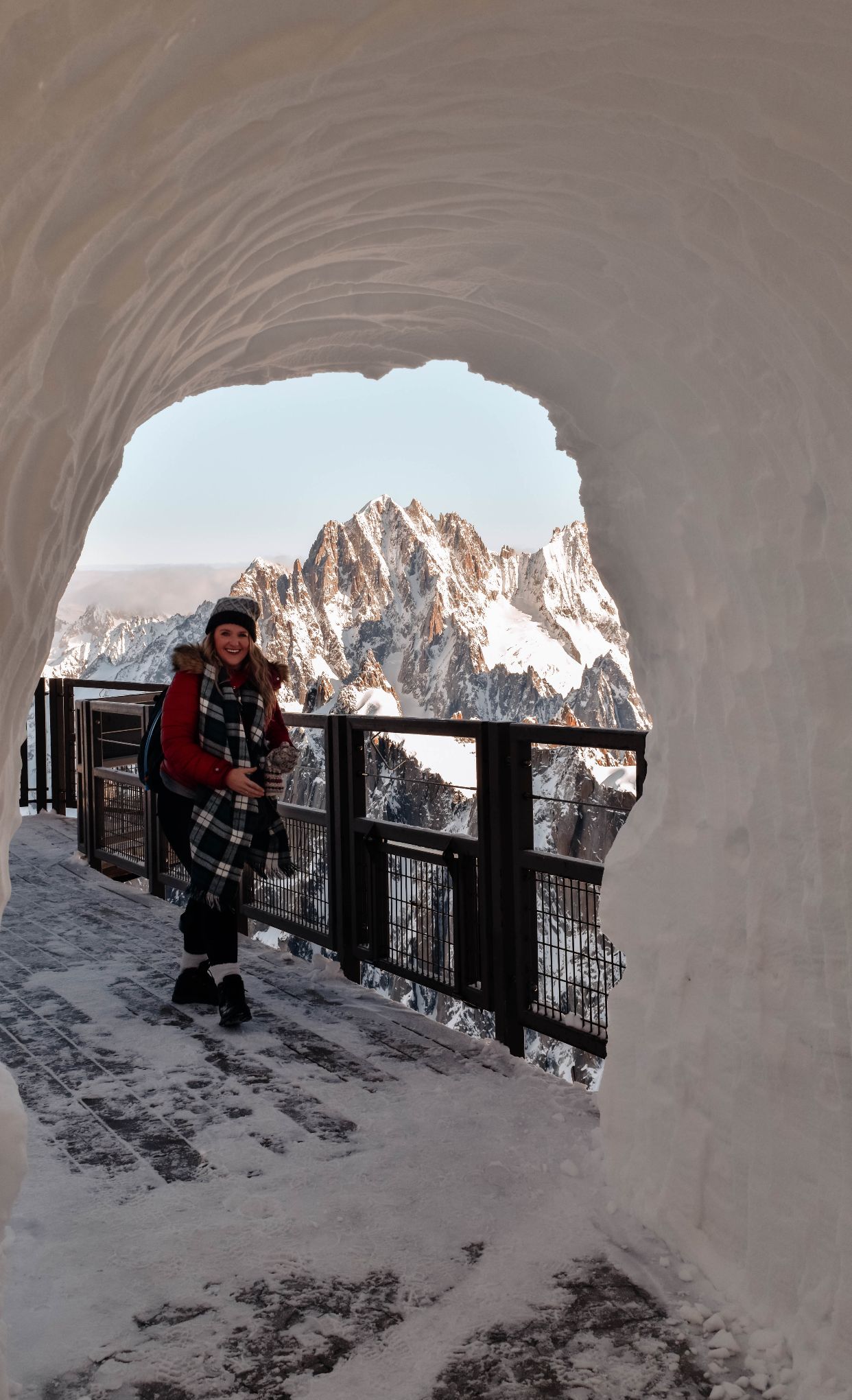
During the summer months Restaurant 3842 is open, appropriately named since it's situated at an altitude of 3,842 meters and is one of the highest restaurants in the world! Year round there are also cafes on site and a souvenir shop. If you'd like, you can also take the gondola over the Alps to Italy to Point Helbronner. From the terraces of Midi, there is a cable car, the highest in the world, that connects France to Italy. This 5 kilometer (2.5 mile) journey goes from Midi to Point Helbronner.
Picturesque train ride to Mer de Glace
Mer de Glace translates to “Sea of Ice” and is the largest, although shrinking, glacier in France. To see the glacier and ice cave, head to the Chamonix central train station and take the train to Montenvers Mer de Glace. The Montenvers Railway was the first custom-built tourist attraction in the area, in 1908. I marveled out the large train windows, looking at the stunning scenery around me.
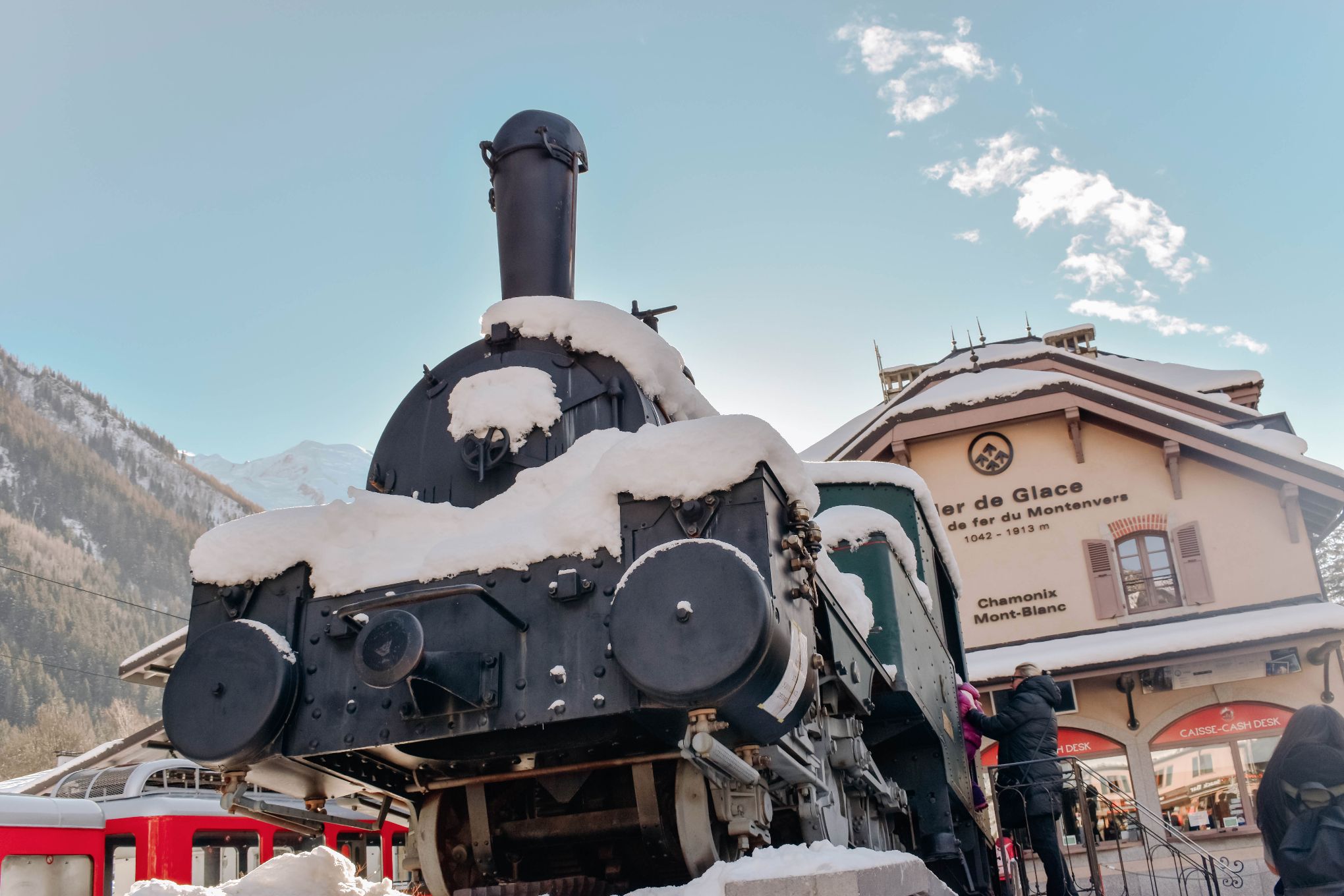
As you exit the train, you'll notice the striking mountain standing above the rest. It's the aptly named “Giant's Tooth” which is distinctive and looks just like its name. The rocky fang is there to almost point you in the direction of the glacier below.
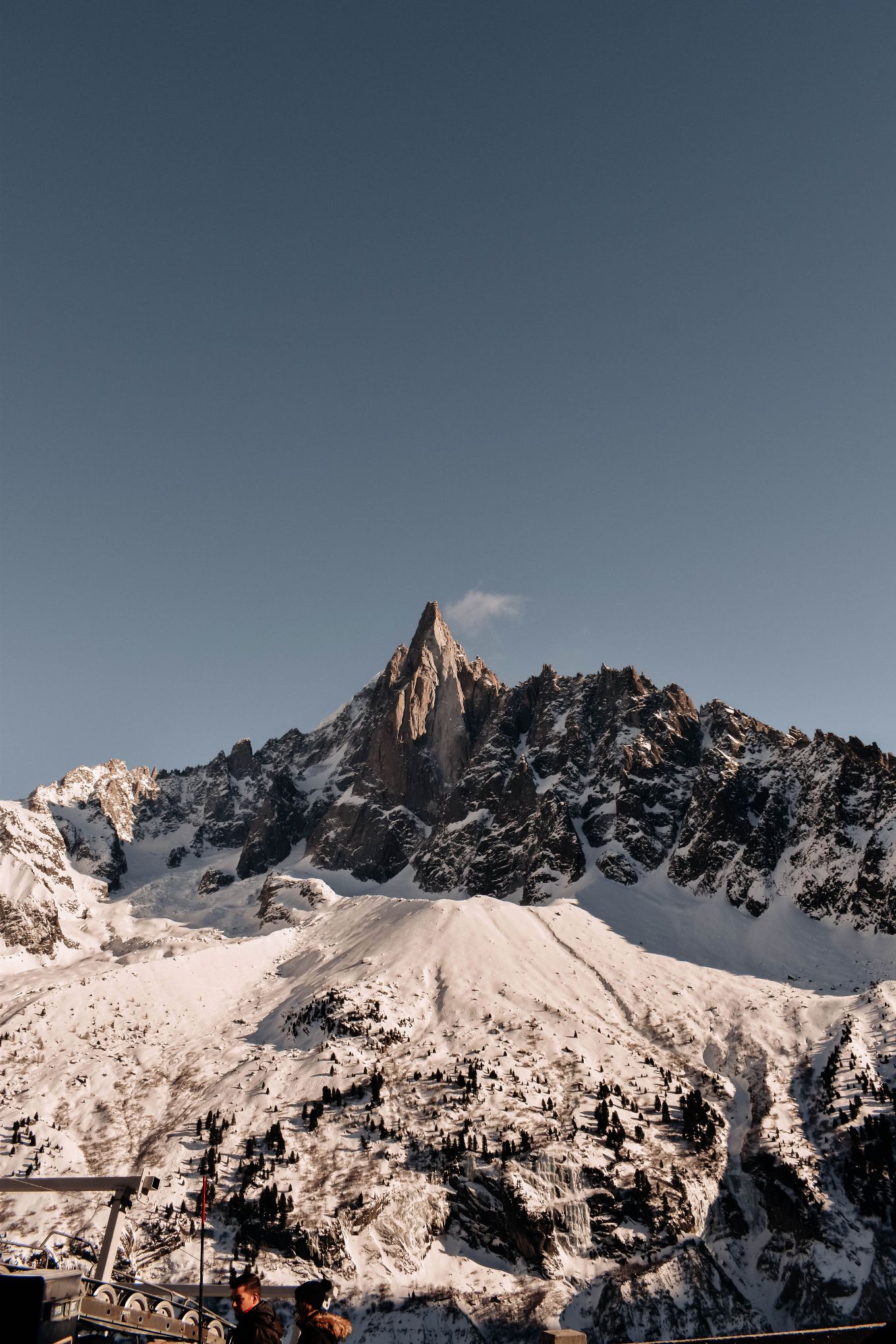
You'll take a short ride on a cable car descending towards the glacier. You'll walk on concrete and steel steps, getting closer and closer to the glacier. It's about 500 steps down so wear comfortable shoes. As you go down, you'll start seeing the aquamarine color of the beautiful glacier next to the brilliant white snow.
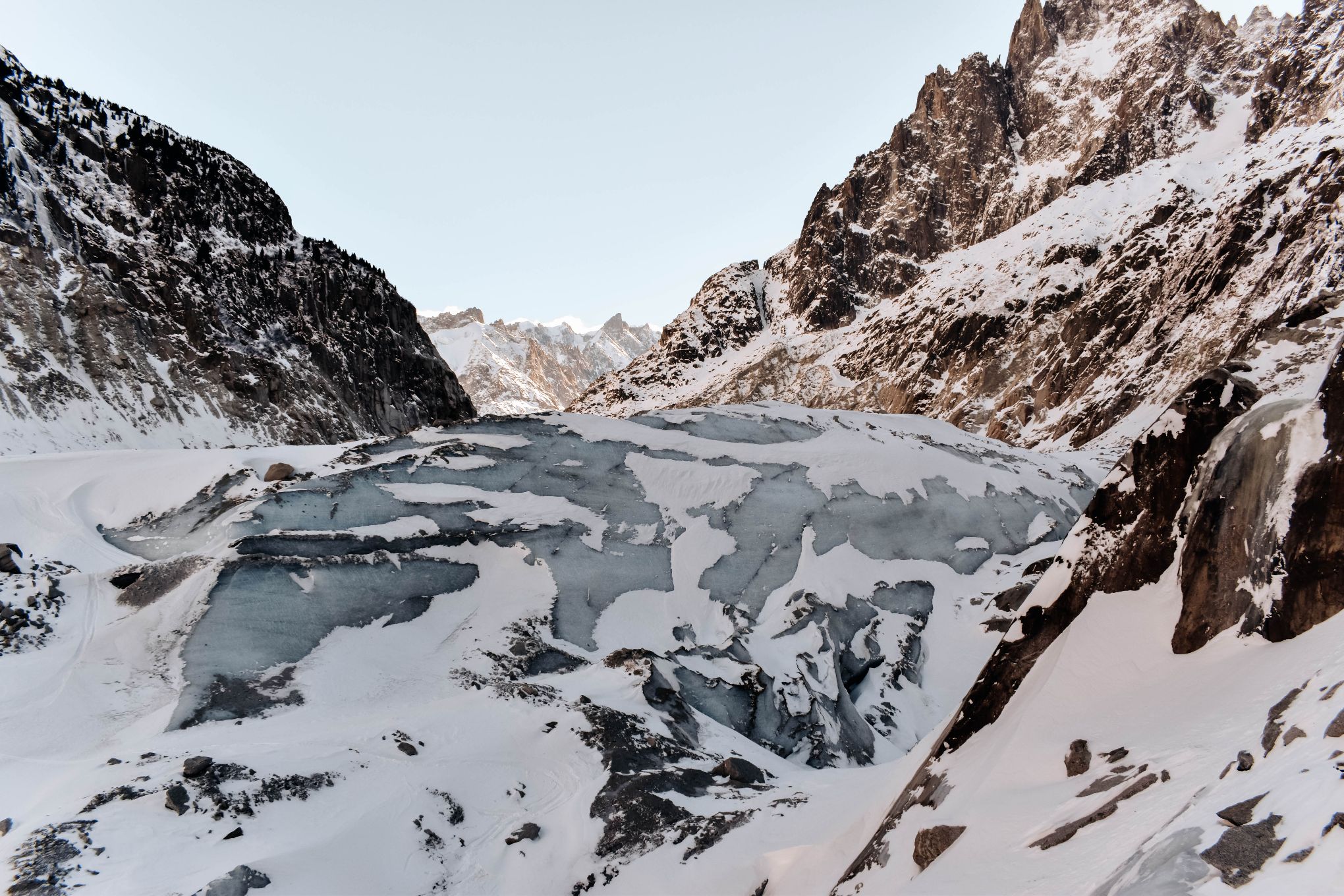
One of the most striking things I found was how much the glacier has shrunk over time. As you climb down, you'll see markers noting the height of the glacier over time. It used to be only 200 steps down to the glacier; now it's 500.
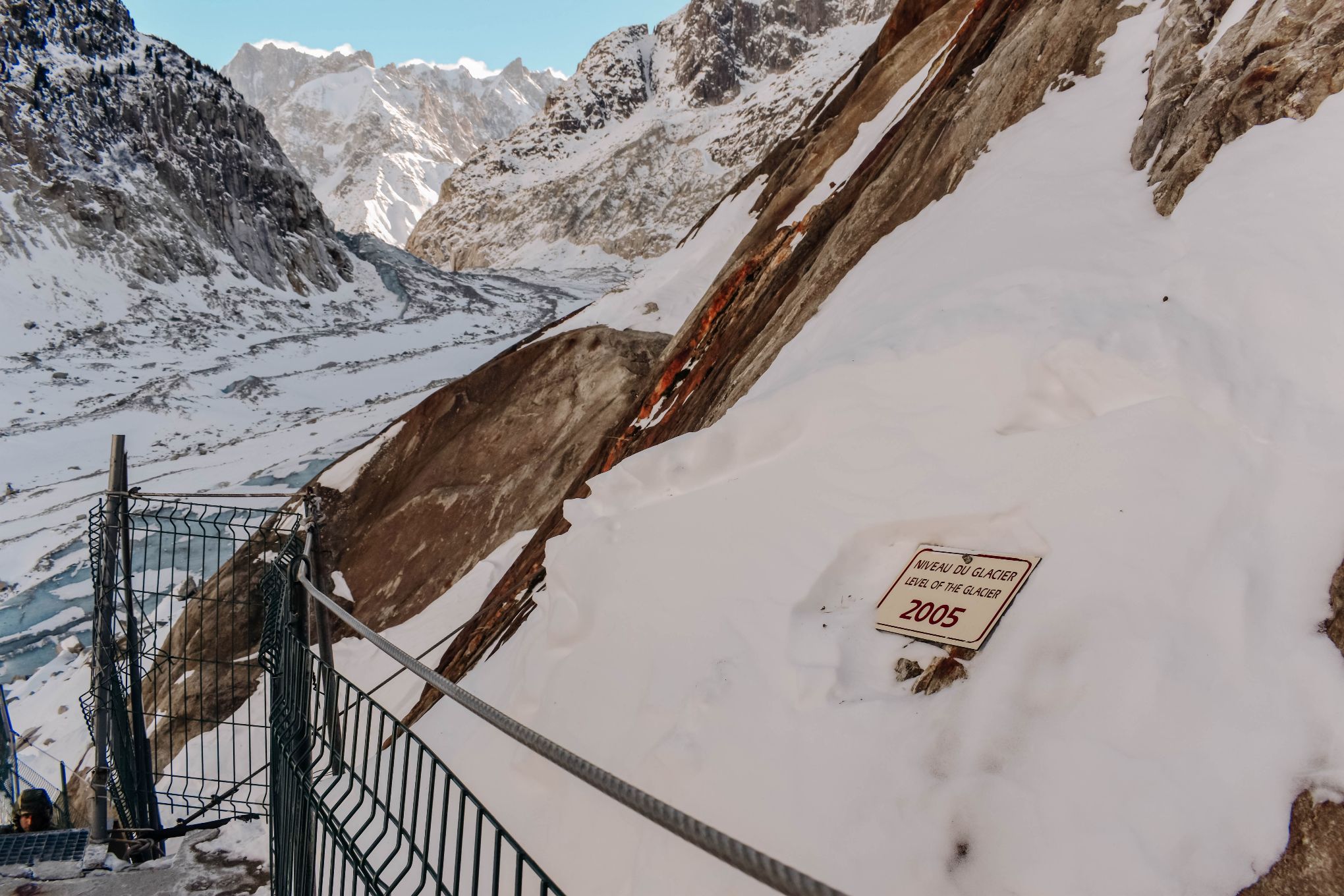
Once you reach the bottom, you can experience the Ice Cave and get a feel for the glacier up close. Inside, you'll find ice sculptures like a chair, a bar, and even a bear.
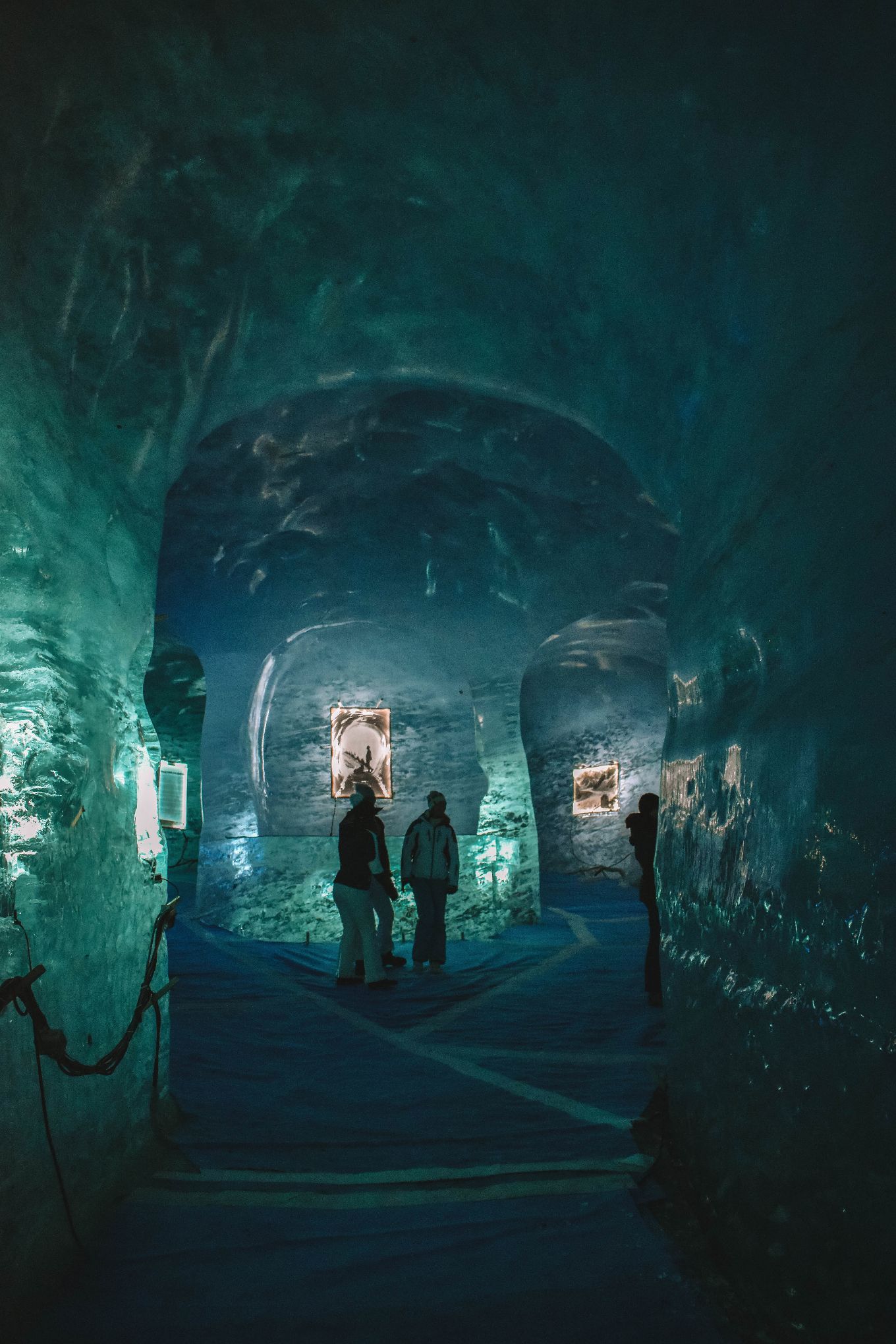
Nearby the train station you can find restaurants, a hotel, and the Glaciorium which features a crystal exhibit.
Explore the Town of Chamonix
The charming town of Chamonix itself is not to be missed. It's small, so it's easy to see it all in a day or so. I enjoyed strolling the streets, popping into cafes, and basking in the warm sunlight on a chilly day.
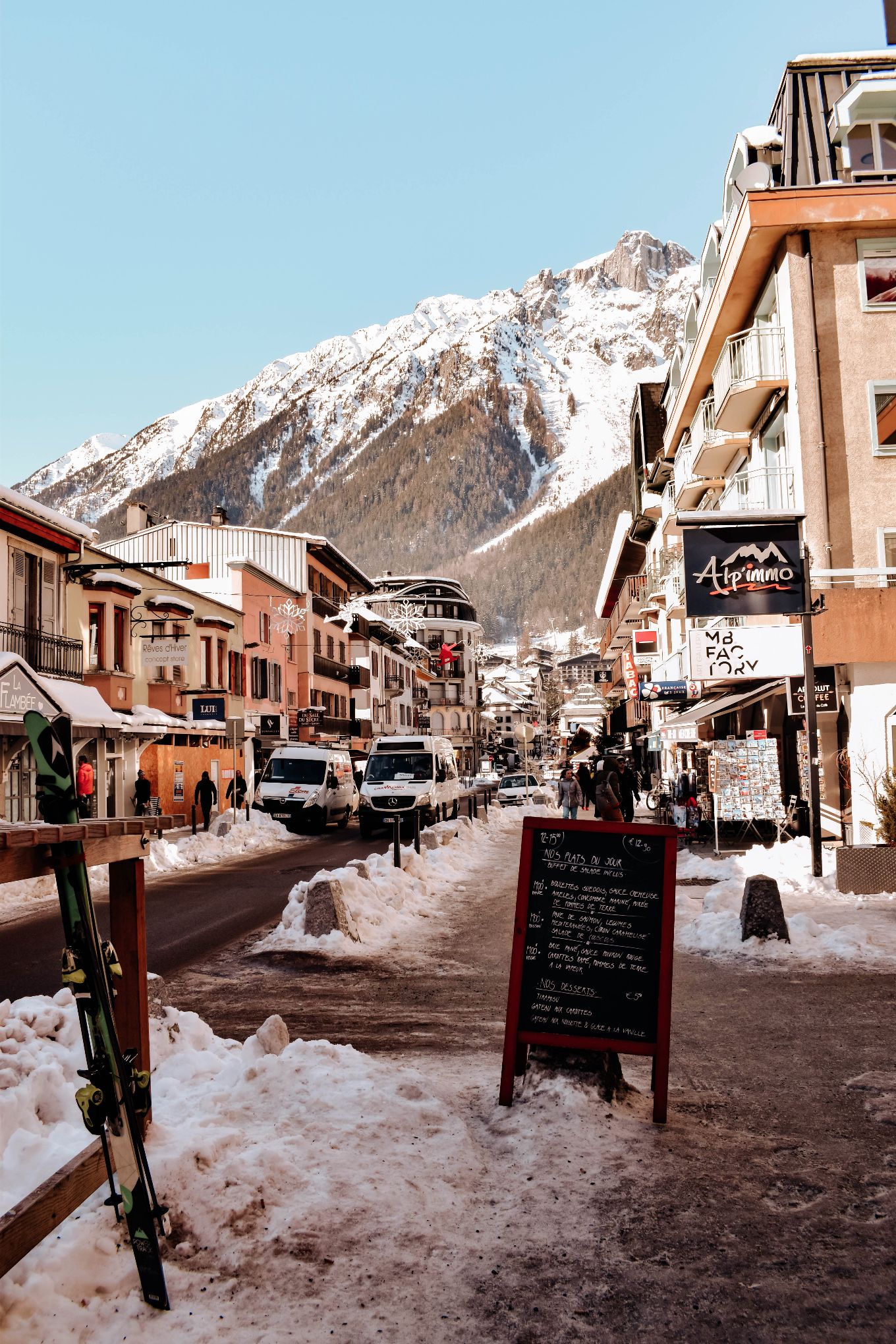
You'll see a statue of two men pointing straight at Mont Blanc; this is explorers William Windham and Richard Pocock. In 1741 they came here and are credited to initiating tourism to the valley. Before the Romantic era, many people looked to the mountains as a nuisance. It was something in the way and caused terrible trouble. But the dawn of a new era meant people, no matter their stature, had leisure time. Ski resorts and relaxation activities started taking place. Chamonix was one of the original Alpine resorts.
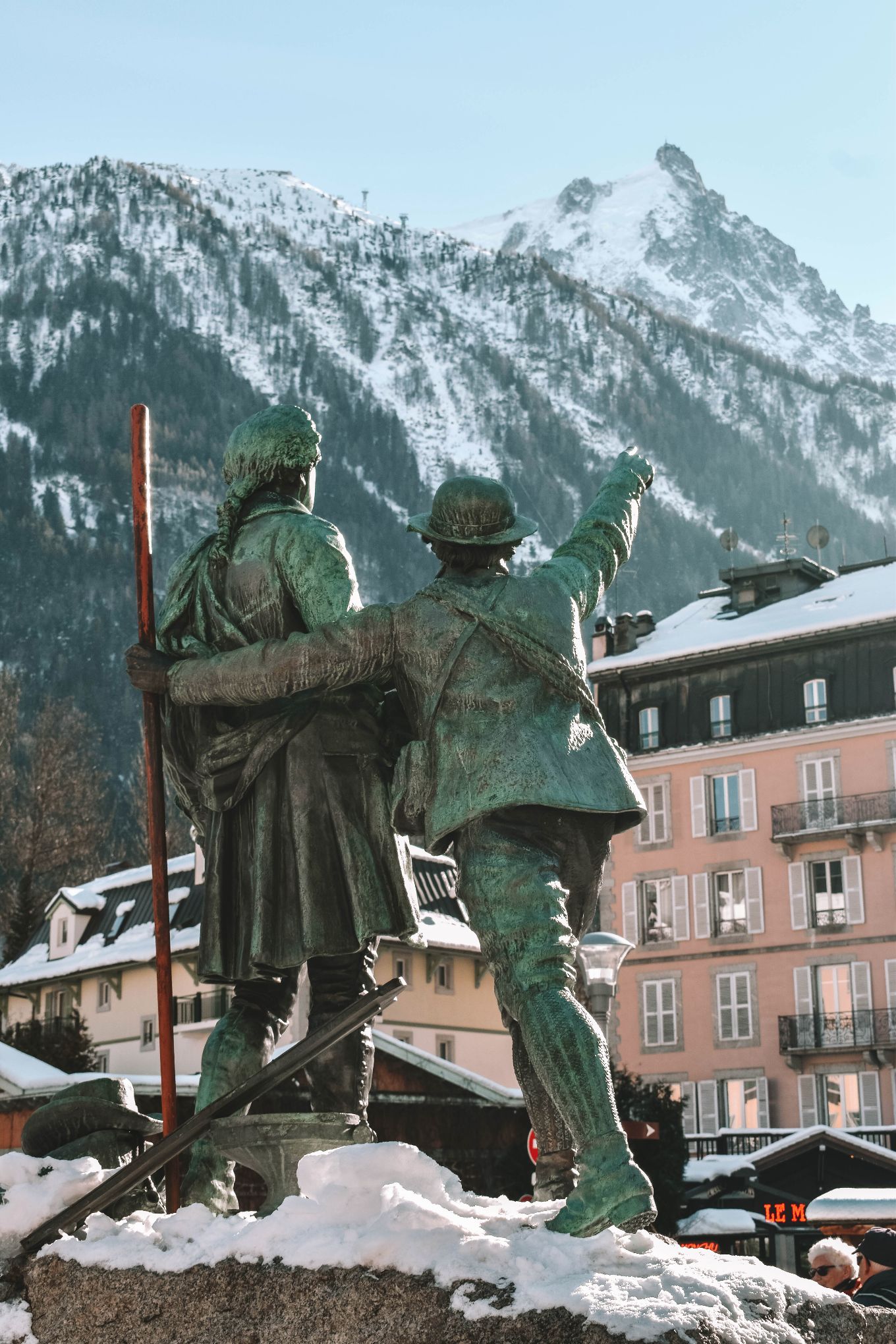
Locals call Chamonix, “Cham” and you'll see it's not just tourists, but residents who pop in and out of shops and restaurants. There's no shortage of decadent French cuisine, where the typical “Savoy” dishes from the region are served.
A mix of upscale restaurants and laid-back bars is what gives Chamonix it's unique atmosphere. Don't forget to grab an old-timey poster or postcard – it makes for the perfect keepsake.
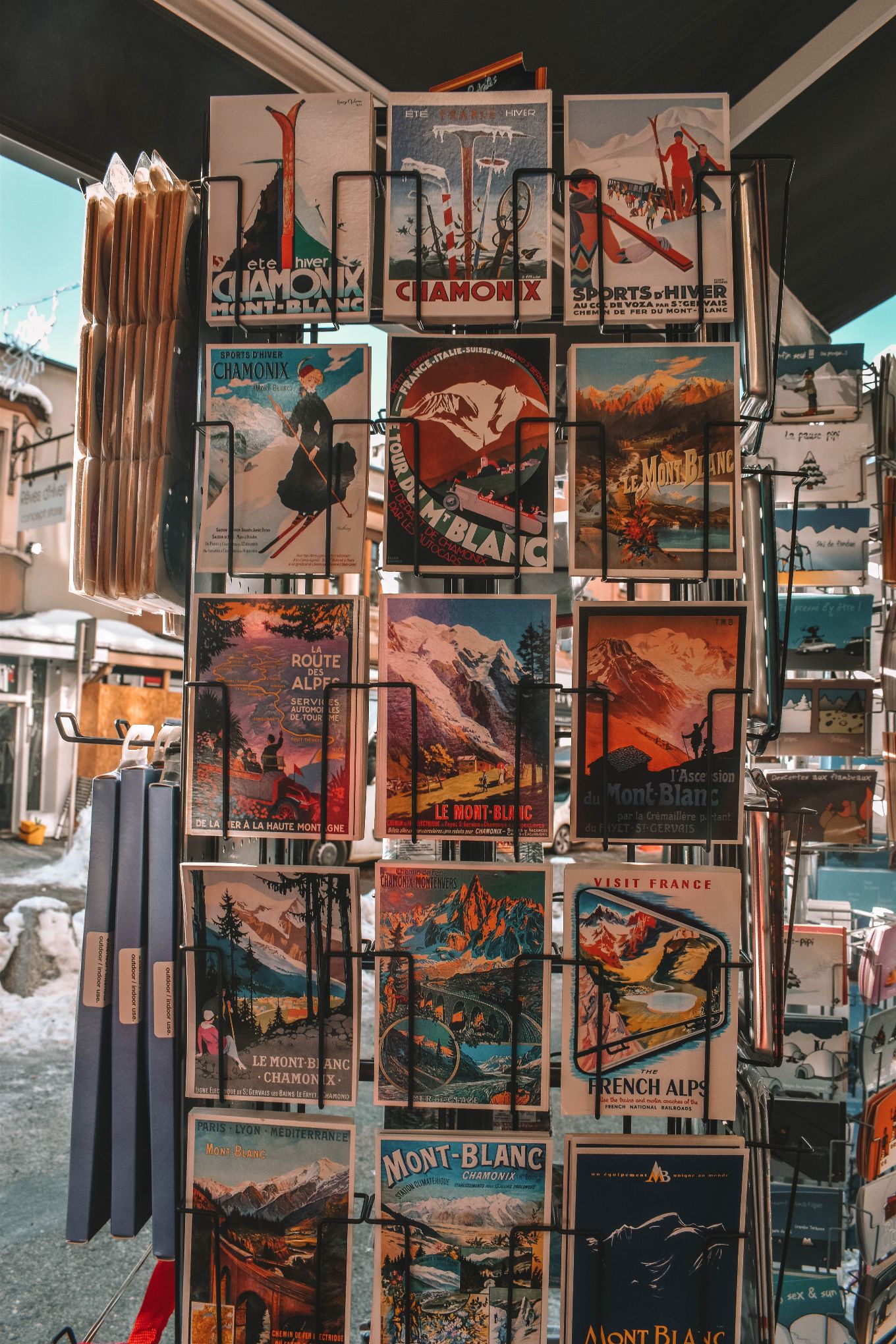
Ski/Snowboard/Sled/Hike in the Alps
Of course, you can have your fill of winter activities in the mountains and surrounding villages of Chamonix. To ski near Mont Blanc you will most likely go with a guide. The ski season runs from mid-December to mid-April. However, the best part about winter activities here is that there's year-round snow on Mont Blanc, so you'll always have a place to bask in the snow.
There are many places to ski off-piste if you're a skilled skier. The skiing and snowboarding are not of the faint of heart. You'll find steep mountainside terrain, some that you have to hike down just to ski! You can check out all the ski areas here, which also recommends different areas for different levels of skiers. As someone who has torn my ACL skiing in the alps, I opted out of this one.

I loved spending time on the mountains near Les Houches called, “Ski Camp.” Here there are beautiful views, plenty of snow, and easier ski runs. To be honest, if you're interested in sledding or tobogganing you won't find much here. I suggest heading to Megève which is about a 45-minute drive from Chamonix. Also, Gstaad, Switzerland has excellent toboggan runs as well and is about a 2-hour drive from Chamonix. Both offer paths that are well marked and miles long! You can sled all day.
My preferred way to burn off the fondue is with a hike. We found great hiking trails all throughout Chamonix. There are well-marked trails as well as more remote areas for all levels of hikers. We took a lovely sunset hike with the dogs one evening but did find some of the trails a bit icy and hard to walk.
There are so many options for winter activities in Chamonix: snowshoe, paraglide, and even paintball. Chamonix truly has it all.
Where to Stay
We stayed at the lovely Les Campanules in Les Houches, a short drive or public transportation stop from Chamonix. This was extremely affordable, had a great room (and view), an incredible on-site restaurant, and easy access to public transportation that they offer for free! The train or bus is just a short 5-minute walk from the hotel, but they also offer complimentary shuttle service.
Walking through the room to the large floor to ceiling windows leading to the balcony I was struck at the clear sight of Mont Blanc. Stretching past the clouds and shining brilliantly it stood proudly. Right next to it was Midi, the point where you can take the lift up to get the best view.

The hotel is traditionally alpine. Nothing over-the-top fancy, but comfortable. The rooms are simple and clean with all the amenities you need. I loved the fireplace in the lobby and comfy nooks to snuggle up and read a book. Bonus points: this hotel is dog-friendly! If you're more interested in staying in the heart of Chamonix, I recommend these hotels .
The best part of Les Campanules is its appetizing restaurant. Michael has the most tender pork he’d ever tasted. I dined on the local dish “Tartiflette” which is melt in your mouth divine. The prices were reasonable and the view is unmatched. If you stay here or even if you don’t, go to this restaurant. Which brings me to my next point…
Where to eat in Chamonix
The best part of this trip, besides the mountains, was the food. I could see Switzerland from the top of Midi, but I’d be paying triple on food and lodging. And it’s not always quite as good. To me, France has the best food in the world.
You won’t find cheap prices, but there are mid-range restaurants. Of course, there are also fancy spots as well if you’re in the mood. Here's what I suggest.
Le Fournil Cafe – I cannot say enough wonderful things about this cafe and bakery. We went here three times. I suggest grabbing some pastries to take up with you, then eat them at the top of Midi and stare at the great expanse of mountains and sky. It's right near the lift in Chamonix and you'll notice there's often a line of locals and tourists, don't worry, it goes quick!
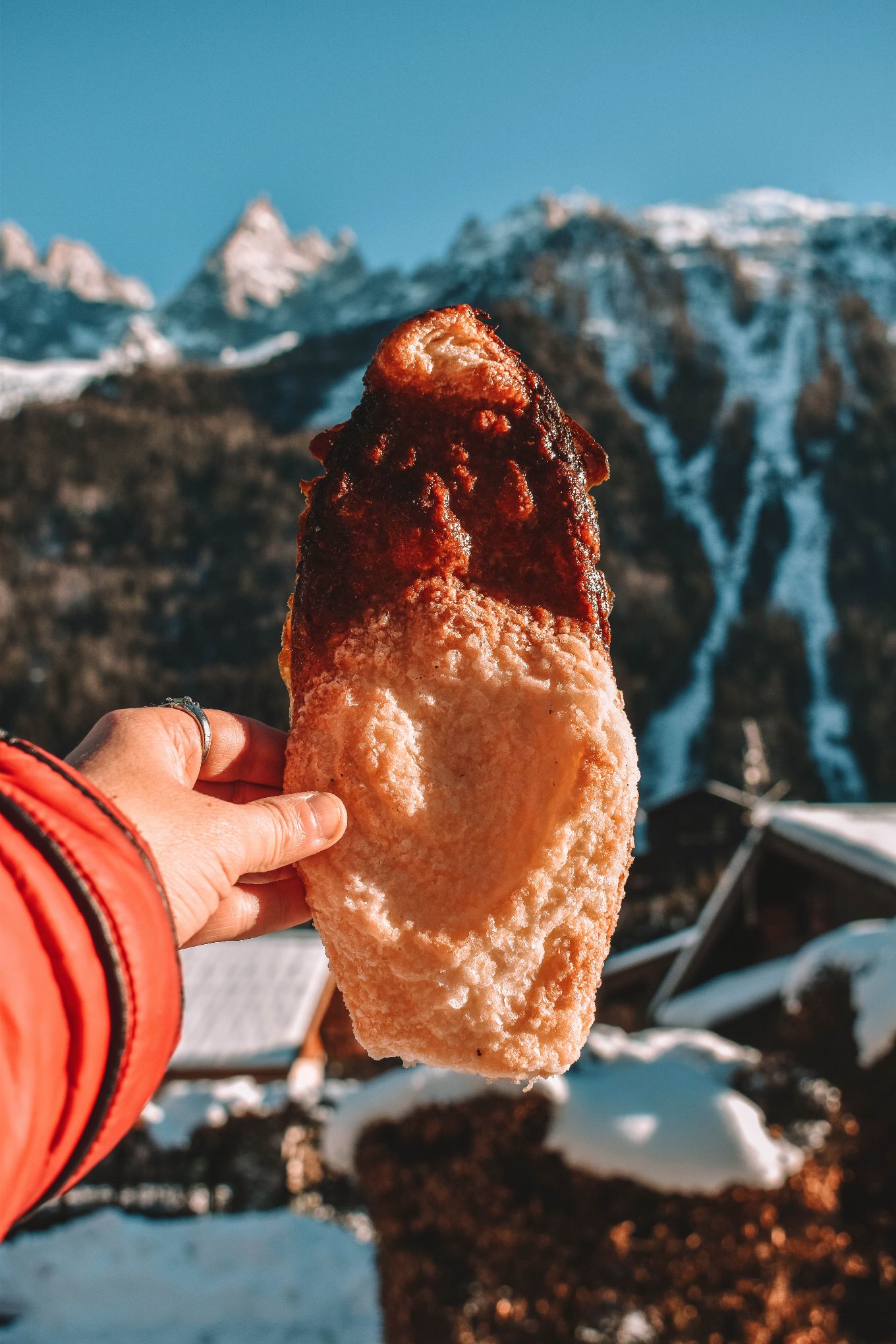
Cap Horn – if you're looking for an upscale, romantic restaurant with traditional French cuisine, look no further. You'll find large portions, which is great, especially for fine dining. Try the duck spring rolls and profiteroles for dessert.
Cool Cats – I'm recommending a place that sells chili cheese dogs and pulled pork sandwiches… in France. Honestly, you could pull my Texan card from me if I recommended a place that wasn't good! It's casual and fun and has a great view of the mountains outside. Yes, there are heaters!
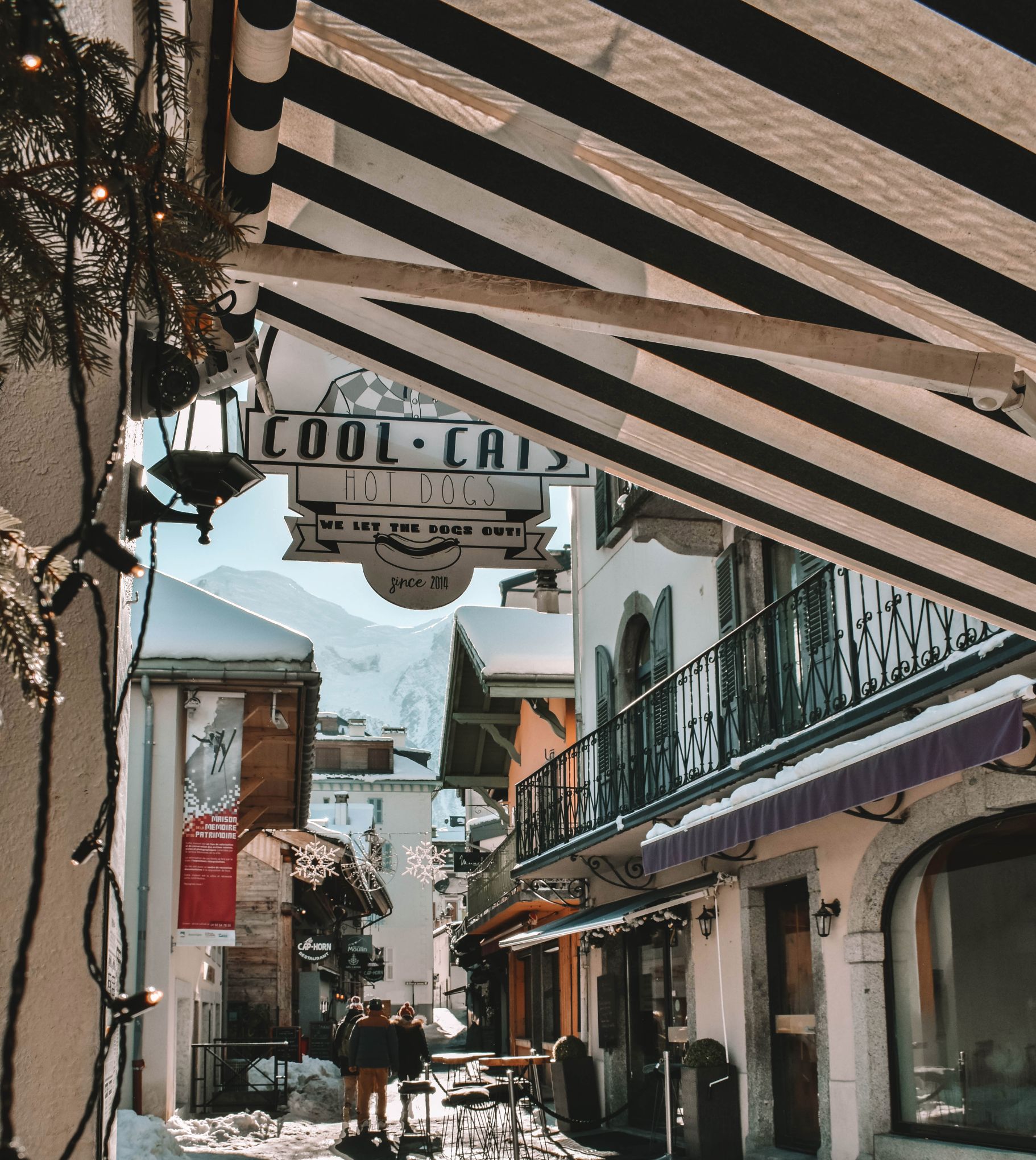
Pizzeria des Moulins – Sometimes you just need a good pizza at a great price. Find it here!
Le Panier des 5 Saisons – Inventive dishes and French fare in a cozy atmosphere. Lots of satisfying dishes after a hard day of running around.
Monkey Bar – This is a great place for Apres Ski activities with live music and a happy hour.
Les Campanules in Les Houches. This is the hotel where we stayed but the food was so divine, I'd also go here to eat.
Le Delice – This is a mixture of French, European, and international cuisine. I highly recommend the squid, Michael really enjoyed the ribs, I had the guinea fowl, and the sticky toffee pudding was divine. There are also vegetarian and vegan options available.
Le Basilic – Serving typical french food as well as cuisine from the Savoyard such as fondue and tartiflette. The menu is small but each dish is delicious.
Kitsch Inn – Open for breakfast, lunch, and dinner, you'll find French and international cuisine. You can actually ski straight in here. They offer live music and Apres-Ski activity.
When to Visit Chamonix
The winter time is best as the activities for outdoors are best. I suggest early to mid- January. You can also go in March during the Boss de Bosses, a ski festival. It's the longest running season workers' competition in the Alps. Of course, there are also summer activities, but it's just so magical during the winter season.
How to Get to Chamonix
Fly – About an hour's drive from the Geneva Airport; you can easily take a train or rent a car. Once you're in Chamonix transportation is a breeze with easy to access trains and buses.
Drive – There are so many lovely places to see in the Alps, it's nice to have a car to get around.
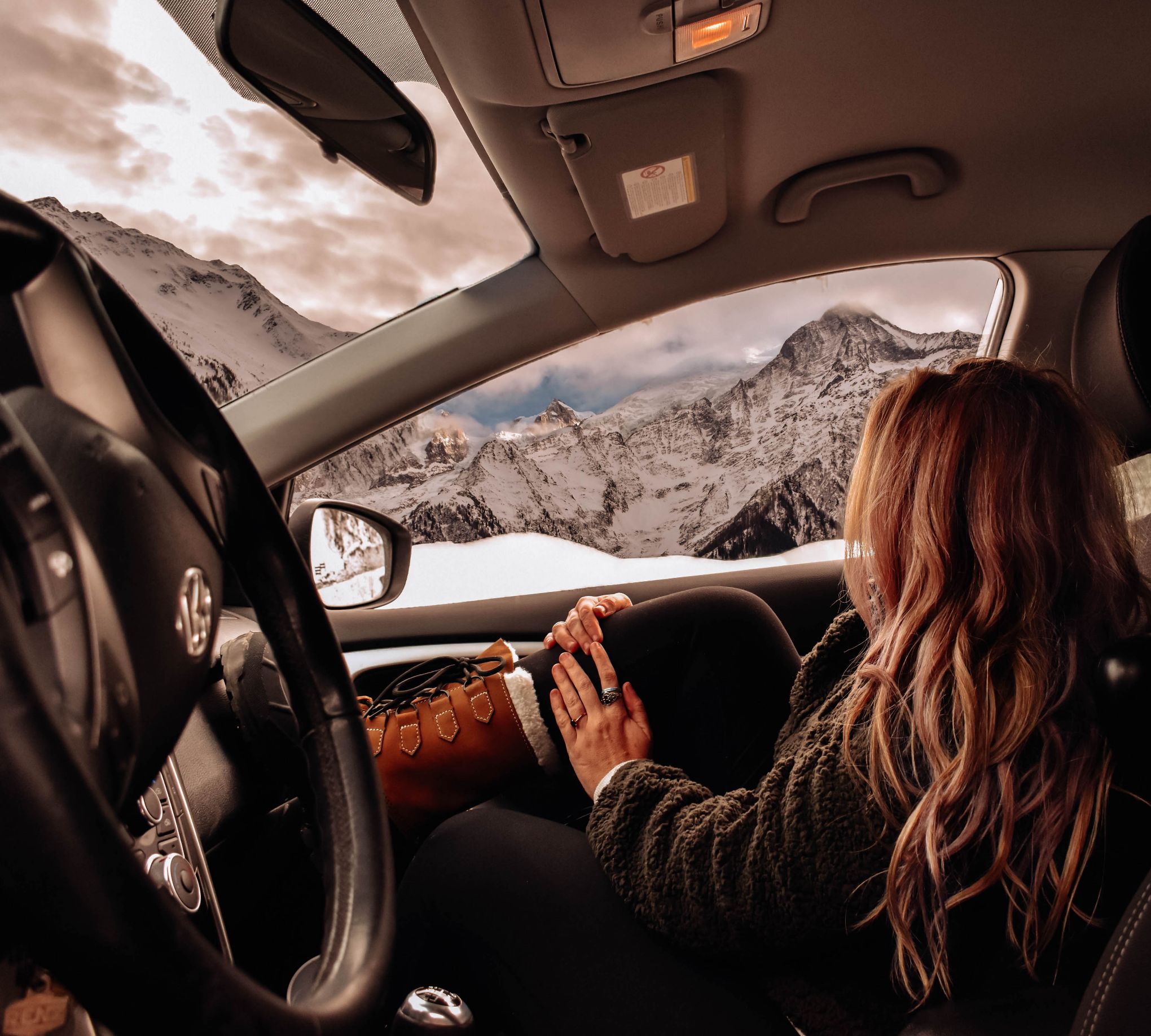
Train or Bus – You can take a train or bus ride ( I use this site to find the best prices and times) right to the heart of Chamonix-Mont Blanc.
Where to go from here
If you have time to explore more of this region then I've got a few suggestions. The adorable, lakeside town of Annecy is about an hour and a half drive from Chamonix. Here, you'll find a delightful French alpine city complete with cobblestone streets, pastel-colored houses, and a beautiful chateau. My favorite part of visiting Annecy was the incredible dining options. We feasted on fondue and Raclette (cheese is unlimited!) at Le Freti . The Savoyard specialty means they bring you a wheel of cheese and an ancient looking metal device to warm the cheese. When it gets hot, you scrape the melted cheese on to your plate. Divine! The way they spoke of cheese is how one might speak about their children, very fondly. The prices were great and the fondue was some of the best I've ever had. Annecy is an idyllic place to spend a few days. I recommend staying in or near the old town so you can easily walk the town.
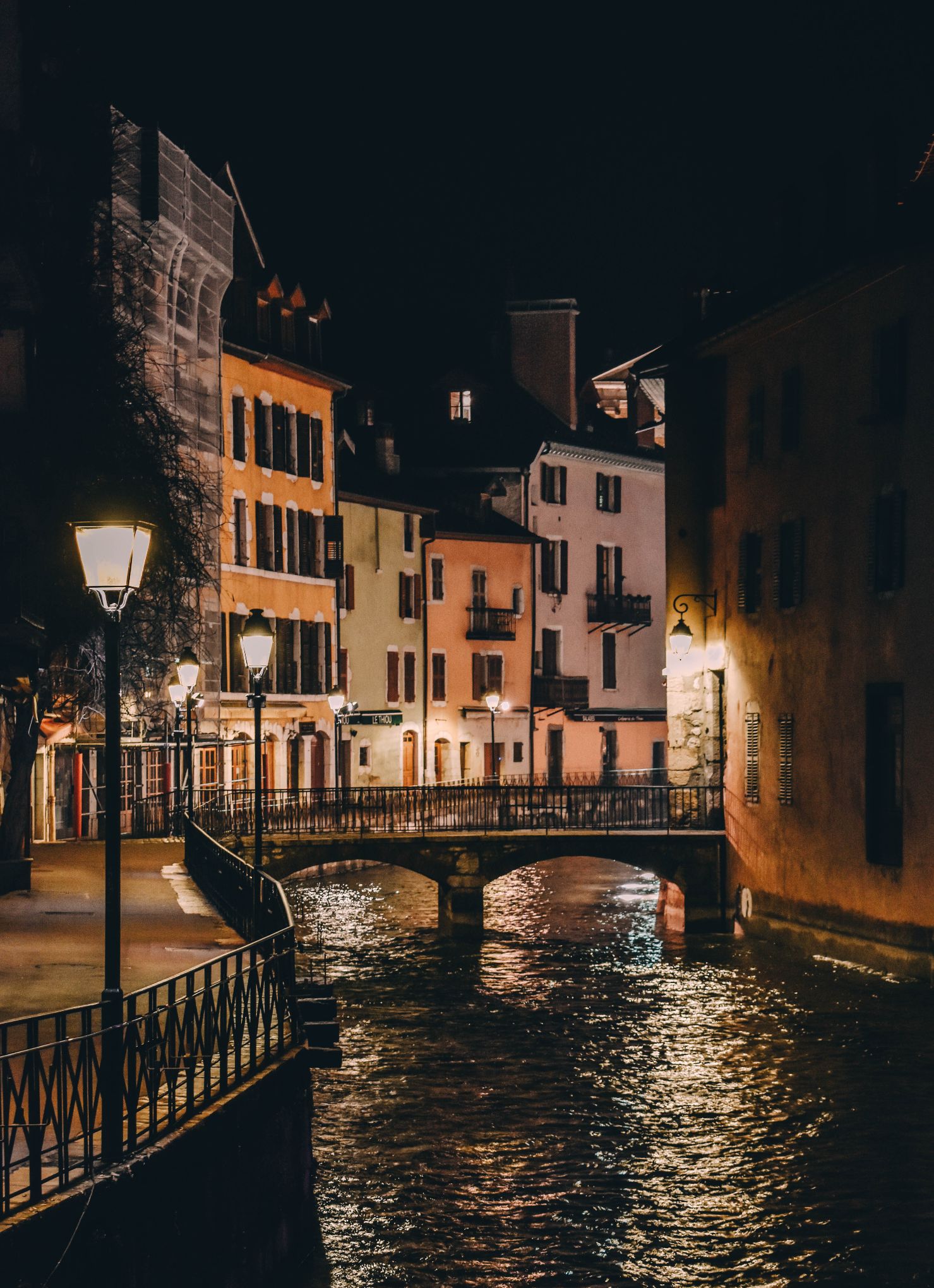
As I mentioned above, if you're interested in sledding (and you should, it's a blast) I highly recommend Gstaad , Switzerland . This is a lovely area of Switzerland and the drive from Annecy was beautiful. There are many ski, snowboard, and of course, sled routes that are miles long. There is ample parking and getting to and from the various lifts is easy. Or, Geneva is a larger city at the southern tip of Switzerland that also has an airport. If you'd like to say in France, I'd recommend Megève for more options to sled and ski.
Lastly, I'd recommend Liechtenstein . This tiny country is the only one completely in the alps. It's truly a feast for the eyes to wander through the alpine villages and admire then mountains that surround you. Vaduz is the capital, but I recommend staying in Malbun and then making a day trip to explore Vaduz. It's small, so it's easy to see it all. We had the most glorious hike just outside of our hotel in Malbun . There are lots of ski runs here and even an ice block you can climb!

My trip to the French Alps and Chamonix was exceptional. I will not soon forget the incredible views, the decadent food, and the cheerful atmosphere. Mont Blanc was a place I heard so much about, finally traveling here confirms this as one of the most magical places in all of Europe. It's definitely a place I hope to venture back to soon!
Pin the post so you don't forget it!

MEET THE AUTHOR
Helene Sula
I believe that one trip can change your life. It did for me. I'm a self proclaimed home body that quit her job, moved abroad, and more often than not, lives out of a carry-on bag. If I'm not traveling, I'm most likely re-reading Harry Potter or watching "Midnight in Paris" while snuggling my dogs. I'm a digital marketing expert who turned my love of travel into a full-time career. And I help others do it too.
Related Posts

- Travel Is Rewarding

DO YOU LOVE STORIES?
Let me tell you a good one. I share behind the scenes travel mishaps and adventures on the road.
You're on the list! YAY! Please check your email to confirm your email.
There was an error submitting your subscription. Please try again.
Helene in Between Courses

- Instagram Content System
Easily manage your content while finding captions that WORK for you.
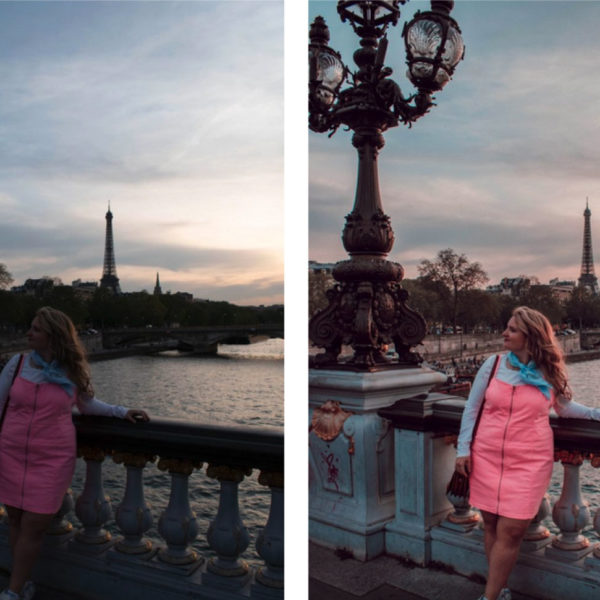
- The Lightroom Vault
140 presets + ALL the skills you need to edit like a pro.

- The Convert Course
Learn how to turn readers into followers + blog post templates
Join 560k+ Instagram Followers
Real life, attainable travel & inspiration to #livealittle at @heleneinbetween

Choose a Destination
Asia Austria Belgium Canada Denmark Estonia Europe Finland France
Quick Links
- Buying a Camera Guide
- Free Lightroom Presets
- Travel Tips
- Shop My Looks
Quick Guide to the French Alps in Summer
Article written by Elisa This article may contain compensated links. Please read disclaimer for more info.
French Alps Summer Holidays
If you love nature and wide-open spaces, the French Alps are among the best places to visit in France in summer . Mountains, lakes, rivers, waterfalls, and more await you in this small peaceful land located in Eastern France .
Whether you are visiting on a weekend getaway or planning dedicated French Alps summer holidays, there are many incredible places to see and great experiences to live in this unique mountain range! From hiking to mountaineering or paragliding, there’s a good reason the French Alps in summer lure millions of visitors each year.
The Alps in France also have a beautiful historical heritage, which you will discover as you stroll through the alleys of Vieux-Annecy , Chambéry, or the upper town of Briançon .
Fancy some wine, great cheese, or even better, a fondue? Then the French Alps will amaze you with its culinary choices too.
From the most beautiful towns in the French Alps to national parks and iconic alpine landscapes, here’s a quick guide to the French Alps in Summer, with the best places to visit and things to do, and our top planning tips.
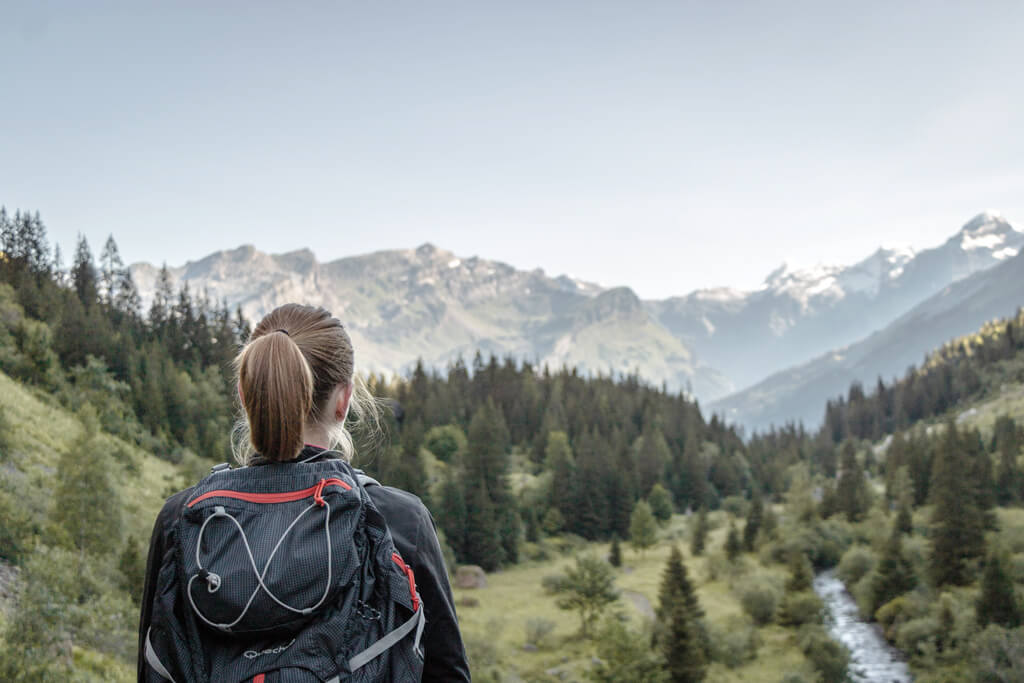
How to Get to & Around the French Alps in the Summer
Numerous low-cost airlines offer affordable flights from Europe to the airports of Lyon , Grenoble , and Chambéry – Click here to buy your flight tickets to the French Alps
From Paris, you can travel to the French Alps by TGV or SNCF trains to Lyon, Chamonix, Annecy, Chambéry, or Briançon – Click here to buy your train tickets to the French Alps
The best way to get around the French Alps in the summer is by car. If you don’t have a car in France, you can rent one in places like Annecy, Grenoble, or Chambéry. When we need to hire a car, we use Discover Cars . Discover Cars compares 900 companies at over 53,000 locations to guarantee you the best price! – Click here to rent your car in France
Don’t leave for the French Alps without travel insurance!
HeyMondo offers travelers insurance that combines medical and travel-related coverage for single trips (with the possibility to include coverage for numerous adventure sports), annual multi-trip, and extended stays (with Covid-19 coverage included). Use this link to get a 5% off .
Best Places to Visit in French Alps in Summer
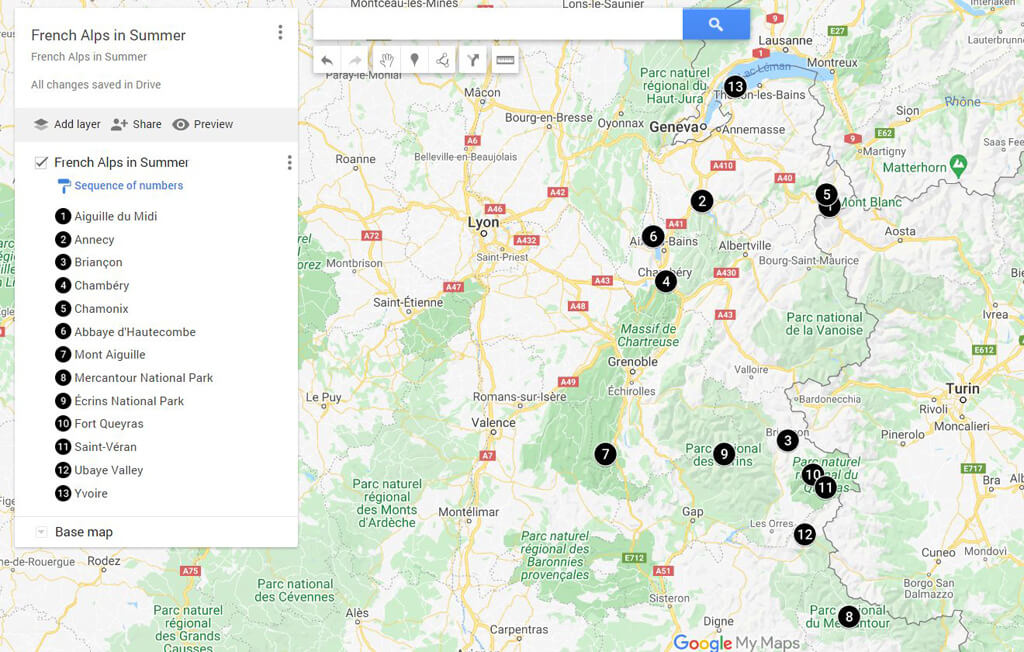
Click here to view this Map on Google My Maps
TIP: If you want to combine some of these places during your French Alps summer holidays, this French Alps summer itinerary by car is perfect for you!

Things to Do & Best French Alps Towns in Summer
Where to go in the French Alps in Summer? Here is the list of the best things to do in the French Alps and the best places to visit for a fun summer in the French Alps.
1. Aiguille du Midi (Mont Blanc)
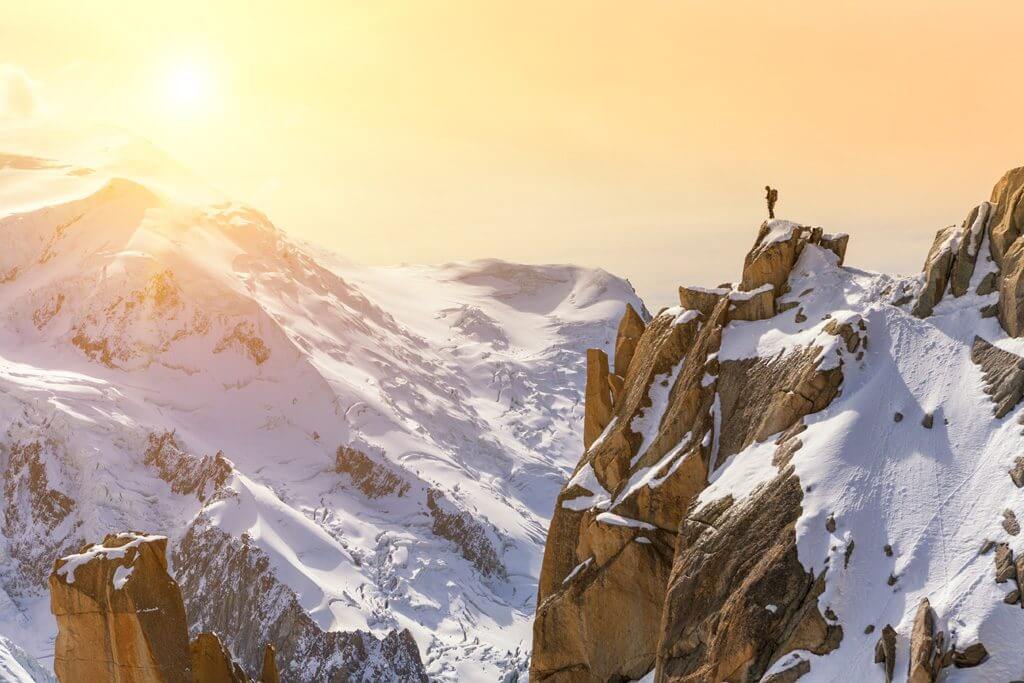
L’Aiguille du Midi (3,842 m) is a mountain in the Mont Blanc Massif, accessible by cable car. This is the highest attraction in Europe, offering the visitor a unique panorama that embraces the highest peaks of Western Europe. It is also an excellent opportunity to get a closer view of Mont Blanc (4,808 m), the highest mountain in the Alps and Western Europe.
We have listed the Aiguille du Midi as one of the top things to do in France ! Don’t miss The Vertical Space , a museum dedicated to the adventure of ascending Mont Blanc throughout history.
In just 20 minutes, the Aiguille du Midi cable car will take you from the center of Chamonix to the high mountains. The total visit lasts 2 to 3 hours on average. Children under 3 years old are not accepted (not recommended for children under 5 years old).
We recommend:
- Chamonix, Aiguille du Midi, and Mer de Glace full-day trip from Geneva (Switzerland)
2. Annecy and its Lake
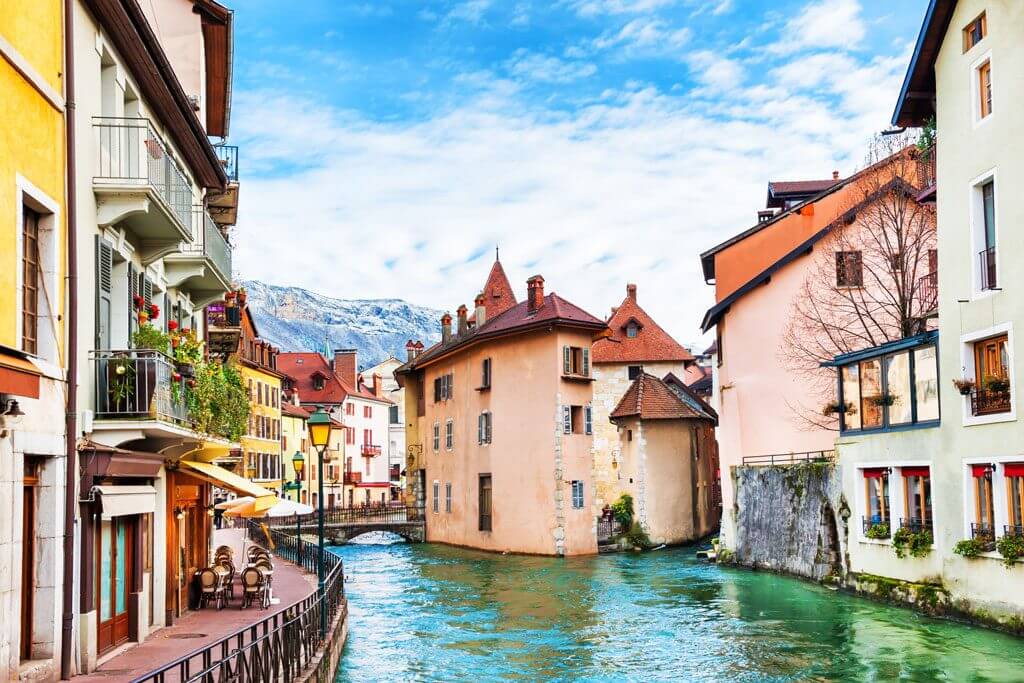
Annecy is one of the loveliest cities in the French Alps, and we are sure it will steal your heart too. Located on the north side of Lake Annecy , in the Haute-Savoye department, Annecy is one of the most beautiful cities in France , with many things to do in and around.
Annecy has a pretty medieval center, with landmarks like the castle Palais de l’Isle , which is now a history museum, and the Château d’Annecy . The surrounding wooded mountains provide the town’s wonderful scenery.
Annecy is a great destination for a relaxing weekend getaway (check out our Annecy 2-day itinerary ) and also for an adventurous summer in the French Alps . You can tour around the Lake by bike, take a boat trip, rent a stand-up paddle, or spend a relaxing day on one of the beaches. Annecy Lake is one of the world’s favorite locations for paragliding, and several competitions have been held there.
- Tandem paragliding flight over Lake Annecy
- Canyon of Angon near Lake Annecy
- Stand-up paddle rental on Lake Annecy
- Electric bike rental on Lake Annecy
- Rent a boat, with or without a skipper, in Annecy
3. Briançon
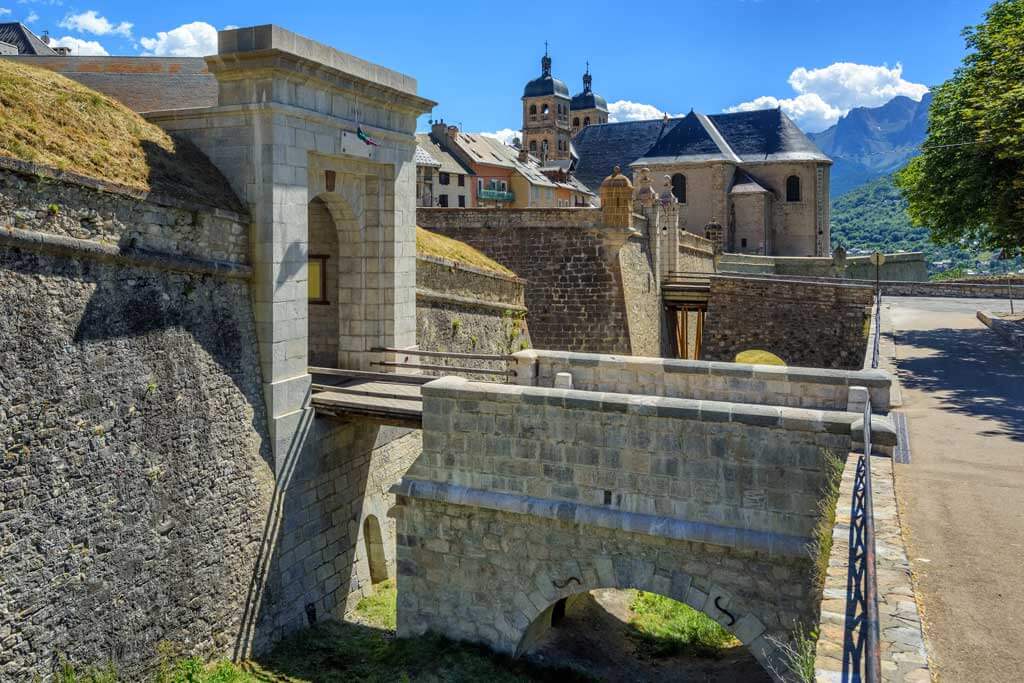
Briançon is one of the best French Alps towns in summer to visit. Located in the Hautes-Alpes department at an altitude of 1,326 meters, Briançon is the highest town in the European Union.
A garrison town fortified by Vauban in the 18th century, Briançon is listed since 2008 as a UNESCO World Heritage Site together with other Vauban sites in France.
The Citadel of Vauban , at the foot of the castle, is Briançon’s beating heart. Here, you can admire other historical monuments such as the Collegiate Church of Notre Dame , the Church of the Cordeliers , the colorful old houses, Place d’Armes , or the fountains and sundials that decorate the alleys.
The exceptional natural environment of Briançon is perfect for a Summer in French Alps. The list of Briançon outdoor activities includes hiking, mountain biking, horse riding, paragliding, canoeing, and rafting. From Briançon, you can also discover other tourist destinations such as Le Monêtier-les-Bains, Saint-Chaffrey, Montgenèvre, and the Queyras Regional Natural Park.
- Tandem Paragliding in Briançon – Serre Chevalier
- Rafting down the Guisane River in Serre Chevalier – Briançon
- Canyon des Acles in Serre Chevalier – Briançon
- Bungee jump from Asfeld Bridge (60 m) in Briançon
4. Chambéry
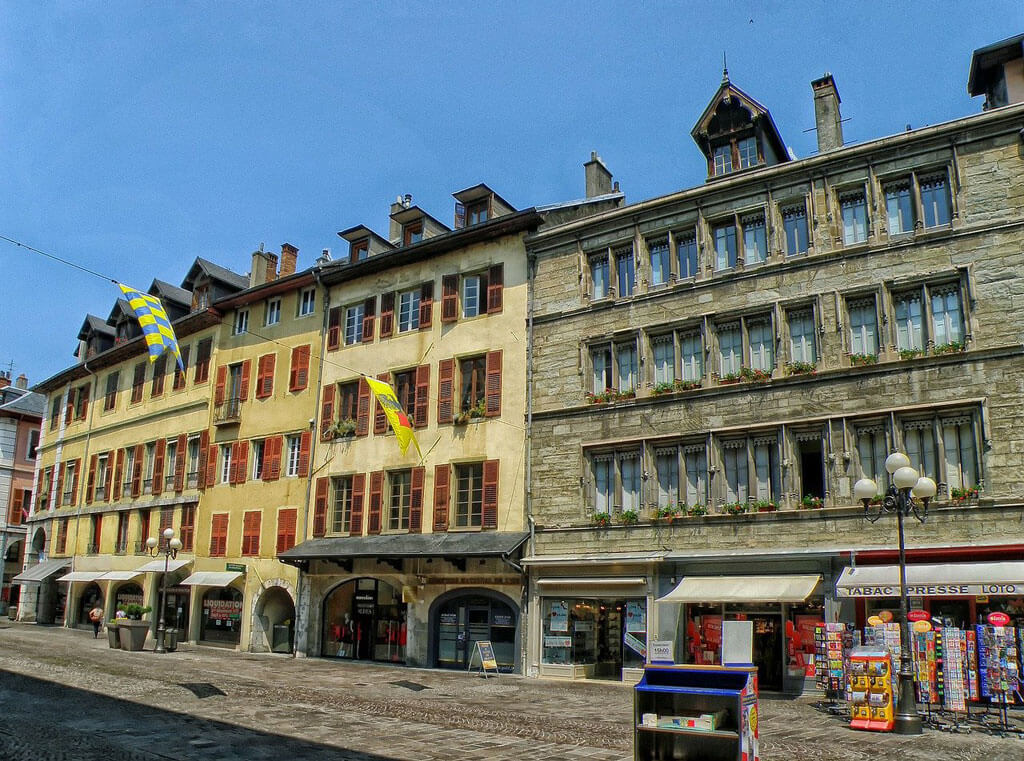
Chambéry is Savoie’s capital, one of the best cities in the French Alps for sightseeing and tasting regional food and wines.
In wintertime, some of the best ski resorts in the Alps are within an hour’s drive from Chambéry, while in the Summer, it is the perfect base for hiking (Massif de Bauges, Massif de Chartreuse), canyoning, or a day trip to Aiguabelette Lake.
Chambéry is easy to explore, and it has a pretty Old Town. The list of fun things to see in Chambéry includes the Medieval Castle of the Dukes of Savoy (where the first counts of Savoy settled in 1285), the Chambéry Cathedral , the intriguing Elephant Fountain , and more.
- Canyon of Ternèze, near Chambéry – Massif des Bauges
5. Chamonix
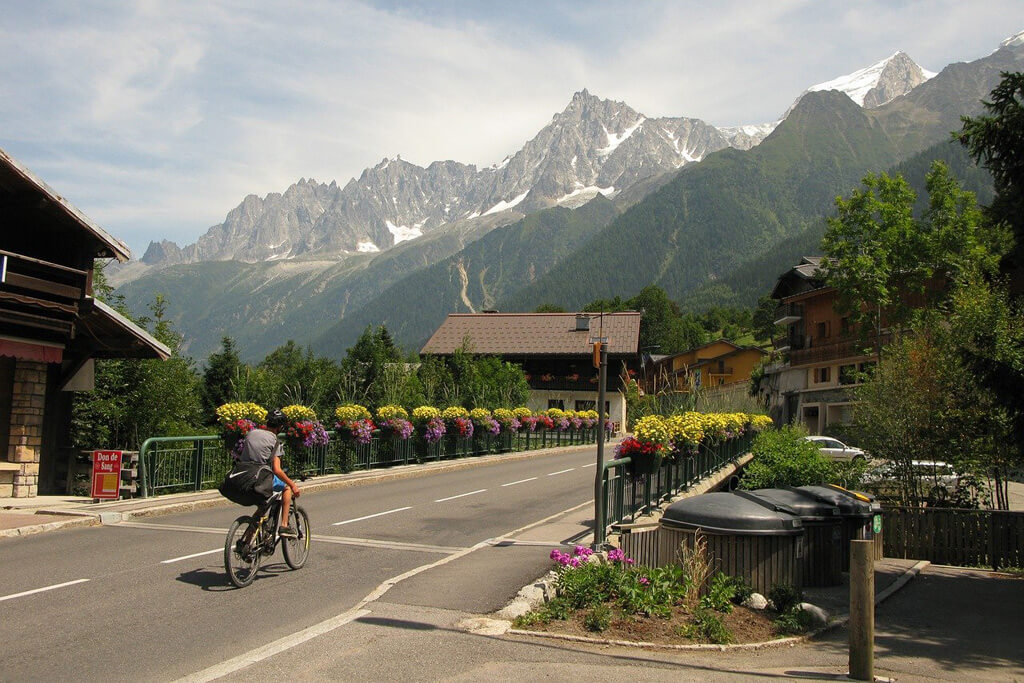
Chamonix is a world-known ski resort that first became famous in 1924 for hosting the Winter Olympics. Nestled in the Arve Valley at the foot of Mont-Blanc, Chamonix comprises 16 charming villages and hamlets, including Argentière, Le Tour, and Montroc.
But Chamonix is one of the best places to visit in French Alps in summer too! The natural scenery, so picturesque under the snow, is equally beautiful in the summer and best explored by following one of the surrounding trails.
Chamonix’s main tourist attraction is l’Aiguille du Midi , which is easy to visit by cable car (20 min) from the center of Chamonix. You can also take Chamonix’s Montenvers railway train through forests, tunnels, and viaducts to the famous Mer de Glace glacier (1,913m) , the largest glacier in France.
The list of fun activities in Chamonix Mont-Blanc includes the Ice Cave , the summer luge (Chamonix roller coaster in the mountains!), or a stroll along the pretty alleys of its lively city center lined up with shops and galleries.
- Tandem Paragliding facing the Mont-Blanc
- Rafting on the Arve River in Chamonix
- Mountain Bike excursion in the Chamonix Valley
6. Lac du Bourget & Hautecombe Abbey
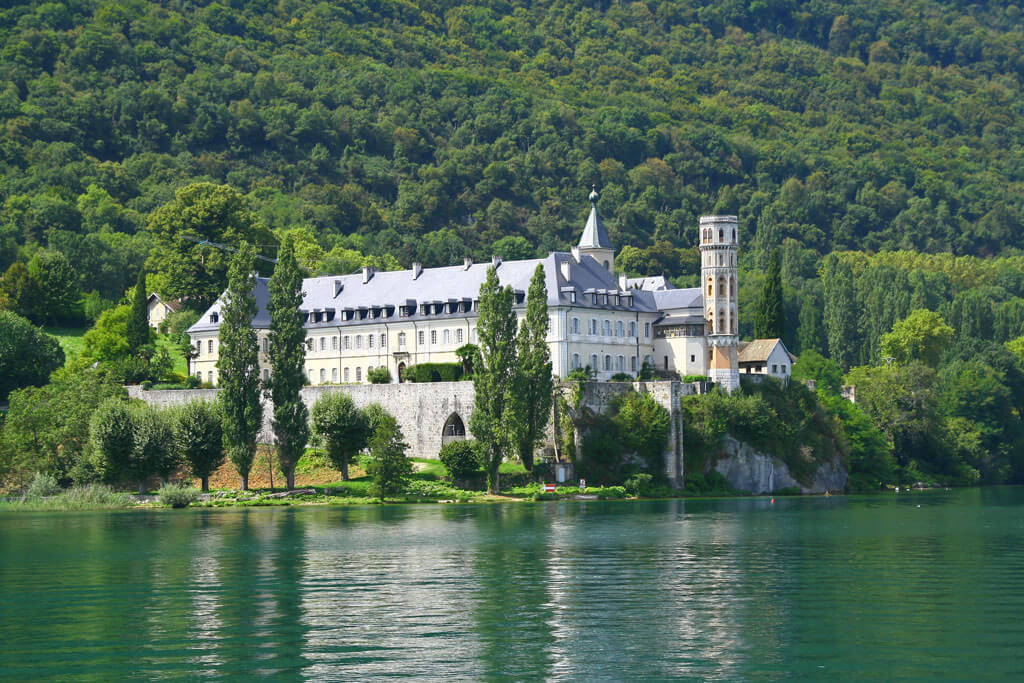
In the department of Savoie, Lac du Bourget is the largest natural lake in France (18 km long). This beautiful lake that borders the world-famous spa city of Aix-les-Bains is surrounded by the Massif de l’Epine, Mont du Chat, Chambotte, Mont Revard, and Les Bauges.
Lac du Bourget is great for a relaxing stroll or a bike ride. It is also the ideal place for a bath (the water can reach 26C in summer) or water activities like kayak, canoeing, fishing, or sailing.
TIP: This road trip itinerary from Lyon to Annecy visits the Lac du Bourget, the Abbey of Hautecombe, Aix-les-Bains, and more!
If you are looking for cultural things to do in the French Alps, the Abbey of Hautecombe , on the lake’s wild shore, is a very good option. This 12th-century Cistercian Abbey and majestic necropolis of the House of Savoy is built in an exuberant Gothic style. From Aix-les-Bains, it is a 35-minute drive to the Abbey of Hautecombe, but you can also take a boat cruise at Aix, which includes a visit to the Abbey.
- Paragliding flight over Lake Bourget
- Hiking and Packrafting expedition on the Lake Bourget
- Rent a boat, with or without a skipper, in Aix-les-Bains
7. Mont Aiguille (Massif du Vercors)
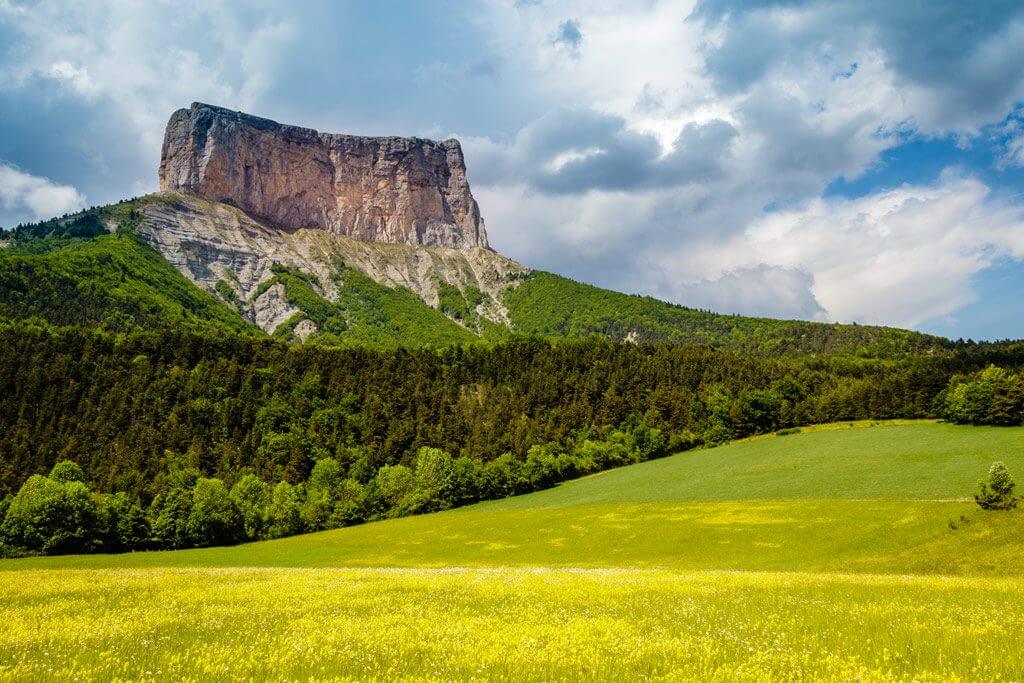
In the heart of the Massif du Vercors, Mont Aiguille is a wonderful place to explore and a sumptuous décor during your hikes in this natural park.
A mountainous massif in the Pre-Alps, between the departments of Isère and Drôme, the Massif du Vercors is a rugged and complex relief of cliffs, ridges, and gorges that culminates in the Grand Veymont (2,341 m).
To admire and make the most of this extraordinary countryside, the park offers a wide range of summer activities, like hiking, climbing, canyoning, or paragliding.
- Guided hike in the Vercors National Park
8. Parc National Mercantour
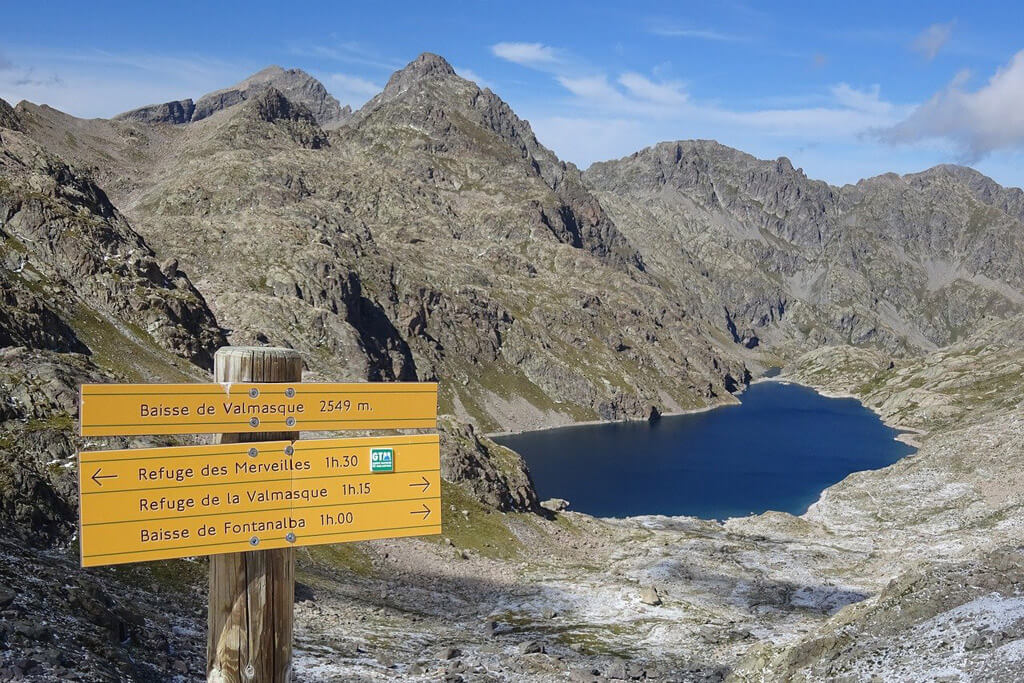
If you are looking for magnificent landscapes to explore in the French Alps in the summer, head to Parc National du Mercantour . Covering a vast area along the Italian border between the departments of Alpes-de-Haute-Provence and Alpes Maritimes, Parc National du Mercantour is one of France’s wildest and most varied national parks, mixing Alpine and Mediterranean influences and forming an incredible mosaic of natural environments.
Parc National du Mercantour is home to more than 3,000 animal and plant species – the greatest biodiversity in France! It is also a true paradise for hiking, with its 600 kilometers of marked trails, including part of the GR5 and the long-distance itineraries Grande Traversée du Mercantour and the Alpi Marittime .
Last but not least, Parc National du Mercantour is home to some of the prettiest French Alps villages, like medieval Tende – once a trading town on the salt road –, Saorge or Saint-Martin-Vésubie .
- Trekking under the stars in the Mercantour National Park
- Mercantour wildlife hike from Allos
- Hiking of the Grand Cheval de Bois in the Mercantour
9. Parc National des Ecrins
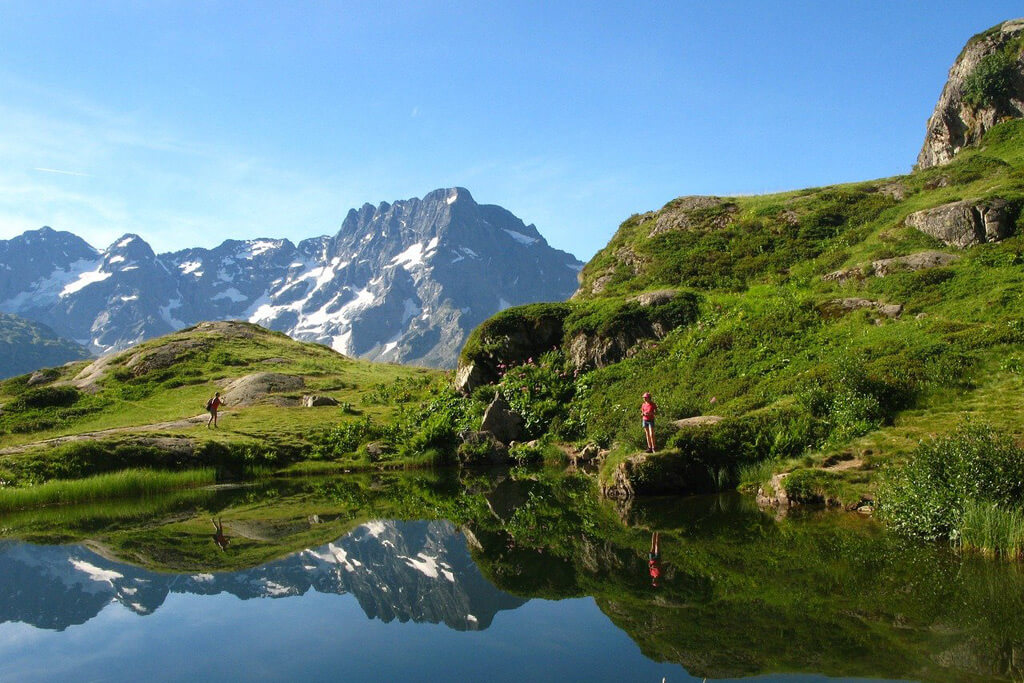
Parc National des Ecrins, located between the departments of Isère and Hautes-Alpes, is one of the largest protected mountain areas in France, comprising more than forty glaciers and one hundred peaks. Some of these peaks are more than 3,000 m high, including the famous Barre des Ecrins with its 4,102 m.
This is another of the great places to visit in French Alps in summer for hikers, with more than 740 km of marked trails, including the GR54 , which circles the Oisans. The park is also home to a vast animal and plant biodiversity, with more than 4,000 recorded species.
In Parc National des Ecrins, it is also possible to find the purple saxifrage, the plant species growing at the highest altitude in France (4,070 m!).
10. Fort Queyras
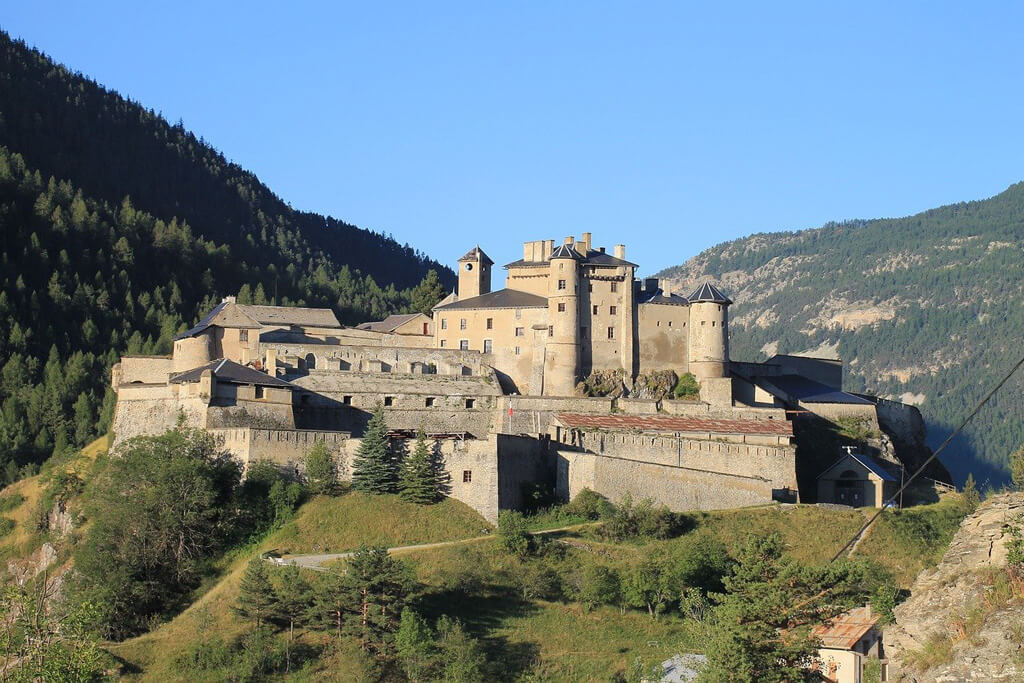
Fort Queyras is one of the best places to visit in the French Alps for history lovers. This 12th-century fortress in the Hautes-Alpes department is built on a hill at a narrowing in a glacial valley overlooking the Gorges du Guil.
This impressive fortress housed soldiers in charge of protecting the Dauphiné against Savoyard or Provençal incursions, but in the end, it was only used twice in the wars between the Protestants and Catholics. In the 1700s, the military architect Vauban launched a restoration project in the fort to make it impregnable, and more constructions were added.
Today, Fort Queyras is in private hands but open to the public for visits. After crossing the drawbridge, explore an inextricable maze of passages, stairs, castmates, and bastions, constructed between the 12th and 19th centuries. This is an ideal half-day family excursion to add to your French Alps summer itinerary.
11. Saint-Véran and Queyras Regional Natural Park
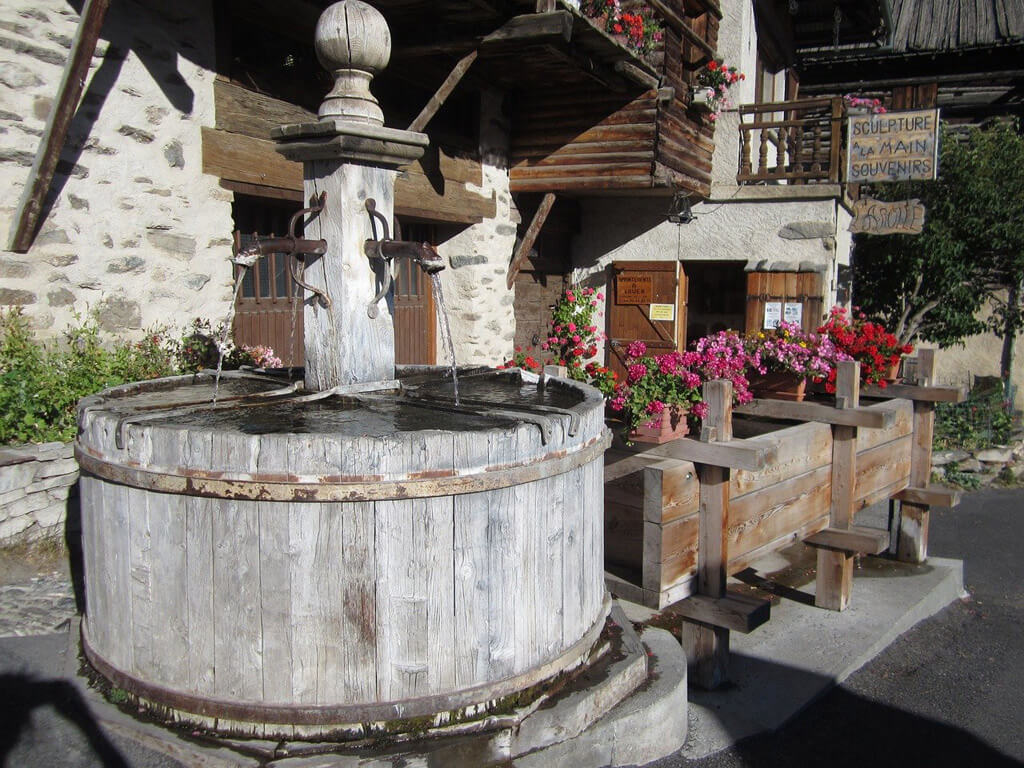
Saint-Véran , in the heart of the Queyras Regional Natural Park , is the highest municipality in Europe, located at 2,042 meters above sea level. With a population of just over 200 inhabitants, Saint-Véran is one of the most beautiful mountain villages in the French Alps, “where roosters peck at the stars.”
Saint-Véran has beautiful traditional architecture with stone houses, log cabins, larch wood fountains, and sundials. Don’t miss the interesting Soum Museum , which shows the organization of a 17th-century farmhouse in total autarky during the long winter months.
As for the Queyras Regional Natural Park , it will delight hikers of all kinds. In summer, there’s mountain biking, horse-riding, tree-top trails, paragliding, and Via Ferrata. Along the GR58 trail ( Tour du Queyras ), there are about thirty lakes, twenty passes (cols), and twenty peaks to climb. There are other picturesque villages to explore, like Arvieux, Abriès, Aiguilles, Ceillac, Château-Ville-Vieille, or Molines-en-Queyras.
12. Ubaye Valley
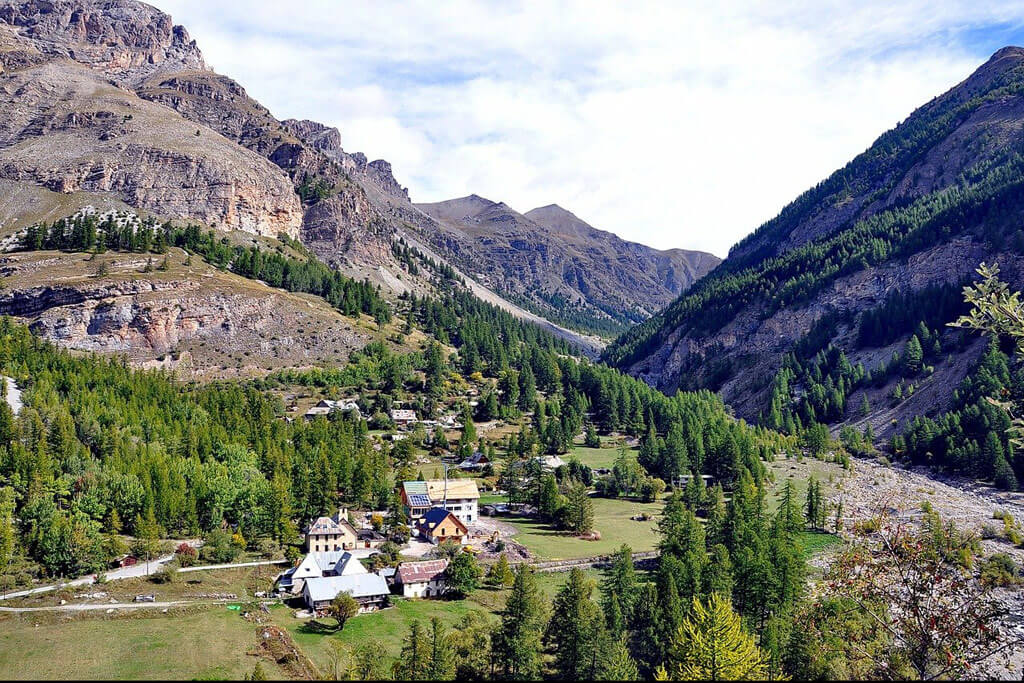
Marking the limit between the Dauphiné and Provence, this glacial valley in the Alpes-Haute-Provence department is wonderful to explore. The Ubaye Valley is bisected by the river of the same name, which is famous among rafting and kayaking enthusiasts. There are beautiful hikes, too, that explore numerous torrents, vast forests, and pristine lakes.
The Ubaye Valley is also famous for its rich local cuisine, mixing Alpine, Mediterranean, and Italian influences. You can taste excellent local products such as génépi liqueur (a plant that grows in the Alps), tomme cheese from the valley, and tourtons.
- Rafting down the Ubaye River (near Barcelonnette)
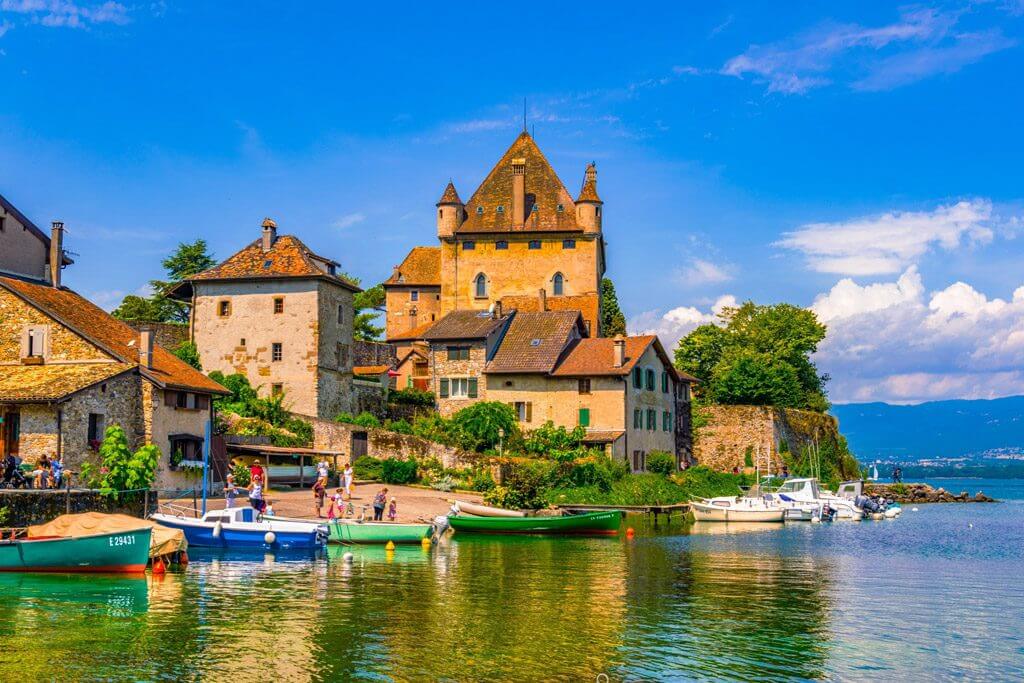
Yvoire is one of the best places to visit in French Alps in summer. This picturesque medieval village located on the French shore of the Lac Léman (Lac Genève in Switzerland) is listed as one of the Most Beautiful Villages in France .
Yvoire is the most isolated place on our map of the French Alps, but it is well worth the detour! One of the best medieval towns in France , Yvoire has more than 700 years of history, and we are sure you will enjoy visiting its ramparts, medieval castle, fortified gates, and cobbled streets.
Don’t miss the Jardin des Cinq Sens , in the heart of the village, listed as a remarkable garden by the Ministry of Culture. There are many pretty shops to buy souvenirs and regional products too. In the afternoon, enjoy a drink or dinner on one of the terraces by the lake.
- Rent a boat, with or without a skipper, in Yvoire
Where to Stay in the French Alps in Summer
Where to stay in French Alps in Summer, near the mountains and the best outdoor activities? Annecy, Aix-les-Bains, and Chamonix are good bases to explore most of the places described in this article.
Aix-les-Bains
And there you have it, the list of the best things to do in the French Alps for a relaxing or adventurous summer trip. Which one tempts you most for your French Alps summer holidays?
Click here for more France Outdoors
Disclaimer: This article may contain compensated links, meaning we get a small commission if you make a purchase through our links. It costs you nothing more (in fact, if anything, you’ll get a nice discount) but helps us to go on creating incredible French content for you. We trust all products and brands promoted here and would never recommend anything that isn’t of value. Please read disclaimer for more info.
(C) Copyright 2019 - 2024 France Bucket List. All Rights Reserved. Designed & Developed by France Bucket List || Disclaimer || Privacy Policy || Contact |
Spectacular rockfalls in the Alps more frequent as mountain permafrost melts
A 100-tonne rock crashes from the side of a French mountain and falls hundreds of metres to the valley below. Images of a spectacular rockslide on the Col de l'Encrenaz in the French Alps spread on social media and TV channels on September 10th. It followed a series of similar falls on the other side of the Chamonix valley, in the famous Mont Blanc massif. Experts say that such events have become more frequent in recent years because rising temperatures are gradually melting permafrost high in the French Alps.
Issued on: 13/09/2024 - 15:38
August 7th, August 22nd, August 27th, August 30th, August 31st. Through the month of August, mountaineering pages on social media have been flooded with videos showing rockslides in the Alps, especially in the Mont Blanc massif, the range that includes Europe’s highest peak, at 4810 metres.
And then on September 10th, a tourist captured an even more spectacular video. Between 30,000 and 40,000 m3 of rock rolled down the peaks of the Aiguilles Rouges in an area that isn’t usually subject to rockfalls. Due to its location and size, experts say the rockfall could be the biggest in the Aiguilles Rouges in recorded history. “The only known instance of such a large rockfall in the Aiguilles Rouges was an event that happened 10,000 years ago,” geomorphologist Ludovic Ravanel told FRANCE 24. “There may have been others but they weren’t recorded or haven’t been detected.”
To display this content from Facebook, you must enable advertisement tracking and audience measurement.
Four rockslides on the Aiguille du Midi
At least four major rockslides were filmed on a single mountain in August: the Aiguille du Midi, famous for the cable car that takes tourists to its 3842-metre summit from the town of Chamonix in the valley.
Numerous videos taken from the Chamonix area show rocks falling away from the mountain summit complex, which includes a viewing platform, a snack bar and a gift shop. The cable car is the highest vertical-ascent cable car in the world.
"The Aiguille du Midi cable car is on borrowed time," one tourist can be heard saying on the video of a rockfall on August 30th, 2024.
‘The spots where the rockfalls occur aren't usually in the most heavily-trafficked’
Olivier Greber, a guide and president of the Compagnie des Guides of Chamonix, witnesses rockslides regularly.
These things don't happen every day, but near the Aiguille du Midi there have been quite a few significant rockfalls. Clients are always very, very surprised because they're not used to seeing this. You hear a big noise on the north face. Try to visualise it: generally all you see is a cloud of dust. Then the last boulders roll down, and the cloud finally dissipates. Given the amount of dust, it's often hard to get an idea of the volume. The spots where the rockfalls occur aren't usually in the most heavily-trafficked. But rockfalls still affect the way we guides do our jobs with climbing clients. But for tourists who want to visit the Aiguille du Midi using the cable car, for example, it has very little impact. These events are potentially dangerous. After all, these are large volumes of rock that break away from mountain walls. Mountains have always been dangerous. We try to pay close attention to warning signs: the sight or sound of sand or water running off the mountainside for instance. When we see these signs, we stay clear from these areas.
To limit risks, mountaineers and guides adapt to new conditions
Statistics from the PGHM [France’s mountain police, the Peloton de Gendarmerie de Haute Montagne] show that rescue operations from rockfalls have not increased in recent years. It has been around 2% of all rescues for years. It shows that mountaineers are adapting well to changing conditions. Being a guide means you must be sensitive to these changes. We have to find ways to keep the mountains accessible, and adopt different ways of climbing them if necessary. We adapt to changes in the seasons too. If we want to do mixed climbing [climbing on snow and rock] or snow routes, we do it in the spring. We also adapt geographically, which means that we go to areas where there's no permafrost: the Aiguilles Rouges, Colombière and the Prealps [lower ranges west of the Alps]. There are also places that used to be classic routes that we can no longer visit. We may have to postpone climbing certain routes, such as the Arête des Cosmiques, or in the Couloir du Gouter which gives access to Mont Blanc. We don’t forbid climbers to go there, but we plan ascents at certain times on certain routes. We might also go back to the origins of the profession, when guides very often had a second activity. More and more guides have a second job nowadays.
‘It happens when summers are very hot’
Ludovic Ravanel is a geomorphologist at CNRS, France’s national center for scientific research. In 2007, he set up an observation network in the Mont Blanc massif to keep track of these landslides. While climate change has contributed to an increase in the number of events in recent years, he says that 2024 has not so far been an especially bad year.
Above 2500m on the north face of Mont Blanc and 3000m on the south face, walls are permanently frozen. This thermal state, called permafrost, allows ice to form in the cracks. The ice is thousands of years old and acts as a cement. If it melts, that's when we see destabilisation. It happens when summers are very hot. In 2022, we reached an all-time high with almost 300 events over 100 m3. This year, there has been less destabilisation. There was a lot of snow this winter, which stabilised the ground. Although temperatures have been relatively high on average this summer, there haven't been heat waves like in 2022 or 2023. We don't yet have a precise figure, but we're looking at 150 to 200 rockfalls in 2024.
As for the dangers for tourists visiting the Aiguille du Midi, Ravanel is unconcerned.
The sector below the Aiguille du Midi is relatively active. And the area is also highly visible, so it's not surprising that we see and hear a lot about them. In the middle section, the rock is highly fractured and located in an altitudinal range that is favourable to the permafrost melting. The permafrost is deteriorating, and summers are getting drier and hotter, so the ice cover holding the rock together is also shrinking. The Aiguille du Midi cable car was installed in the 1950s. It was a good idea to build the platform high on the mountain. From a safety point of view, it's good: at the summit, the permafrost temperature is very low and the whole thing is stable. Tourists going up to the Aiguille du Midi does not destabilise it. There is absolutely no direct impact from tourism, apart from the fact that tourists’ travel emits greenhouse gases.
Tourists may be safe, but the valley could be at risk
However, Ravanel points out the risks of these increasingly frequent events.
It's dangerous, yes. But mountaineers are particularly careful. Guides are adapting too. The problem is that we are beginning to see phenomena that can produce risks all the way down to the valleys. These are known as glacial and periglacial hazards. In 2017, in the Swiss canton of Grisons, 3.1 million m³ of Piz Cengalo broke off and fell onto a glacier. The glacier was pulverised and turned into water. The water mixed with the rock, causing a series of mudflows that reached the village of Bondo, 6km away. Around a hundred buildings were destroyed, and eight hikers were killed.
Download the app
- climate change
The content you requested does not exist or is not available anymore.

IMAGES
VIDEO
COMMENTS
The Savoie region grows Europe's highest mountains and is the penthouse of the French Alps, with drop-dead spectacular scenery. More than just a pretty-peaked face, stubborn Savoie maintained its independence from France until 1860, when mountains became targets, rather than obstacles, for travelers. Today's Savoie is France's mountain-sports capital, showcasing 15,780-foot Mont Blanc as its ...
Saint-Gervais, surrounded by Mont Blanc among other towering peaks, is also a top French Alps destination in its own right, with bountiful eateries and plenty of mountain air to inhale. Take a 70 ...
French Alps & the Jura Mountains. France, Europe. High up in the French Alps, it's enthralling to imagine the forces that shaped these colossal peaks. The African and Eurasian tectonic plates collided some 35 million years ago, forcing the land skyward into a 1000km chain of saw-edged mountains. Attractions.
Description of the French Alps Limits of the French Alps. The French Alps extend 180km from Lake Geneva on the Swiss border in the north to Nice and the Italian border in the south.Switzerland and Italy border its eastern side.. Two administrative regions share the vast mountain territory: Auvergne Rhône-Alpes to the north and,; Provence-Alpes-Côte d'Azur (PACA) to the South.
This French Alps road trip from Annecy to Chamonix covers the French department of Haute-Savoie and allows you to experience the most iconic places in the region behind the wheels. This road trip through the French Alps is an ideal self-drive vacation for those who love sightseeing, nature, and good food. This 7-day French Alps road trip ...
France's longest glacier stretches for 4.3 miles and is over 650 feet deep. Quite literally a sea of ice, it continues to move under its own weight; its surfaces break up, crevasses appear, and pointed columns of ice known as seracs burst from the surface. Though this glacier continues to amaze, it's slowly being decimated by climate change ...
Guide of the Alps. Ain. The Brou royal convent, gothic masterpiece, the Dombes lakes, the Saracen chimneys in Bresse, and the charming medieval town of Pérouges are among the gems to be discovered in the Ain. Alpes-de-Haute-Provence. The département of the Alpes-de-Haute-Provence offers visitors plenty to see and do, ranging from its ...
2024. Hôtel Royal. 825. from $311/night. 2024. Hotel La Clef Des Champs. 174. French Alps Tourism: Tripadvisor has of French Alps Hotels, Attractions, and Restaurants making it your best French Alps resource.
Chamonix-Mont-Blanc. Chamonix, the prime outdoor resort in the French Alps lies at the base of huge Mont Blanc, the highest mountain peak in Western Europe. The long valley beneath boasts numerous villages, dozens of ski lifts and hundreds of kilometers of slopes and trails, but you don't have to be a skier to love this spectacular region.
Suggested French Alps travel itinerary. Day 1: Rent your car in Geneva (either in Switzerland or on the French side of the border) and head out to Yvoire for a leisurely dinner and overnight. Day 2: Drive to Evian via Thonon and sleep in Evian. Day 3: Drive to Chamonix and spend the day and night. Day 4: Drive to Annecy and spend the day and night.
Find the best things to see and do in the region with our list of the top tourist attractions and places to visit in the French Alps. See also: Where to Stay in the French Alps. On This Page: Chamonix. Annecy. Vercors Regional Natural Park. Grenoble. Aix-les-Bains. Val d'Isère.
Chamonix. France, Europe. Mountains loom large almost everywhere you look in Chamonix. Skiers and sightseers are launched by cable car to heights of 3842m on the Mont Blanc massif, while the glacial void of La Vallée Blanche - one of Europe's most fêted off-piste adventures - beckons to the brave. Skiers and boarders have a choice of ...
French Alps. The French Alps are part of the large European chain of mountains known as the Alps. They are primarily attractive for outdoor activities, such as Alpine Skiing and mountaineering. Less famous but still popular sports, in the region, include mountain bike (cross-country, Downhill), white water rafting and paragliding.
Annecy. Lying 50km to the south of Lake Geneva, Annecy, set on a sparkling turquoise lake, the Lac d'Annecy, is one of the most beautiful and popular resort towns of the French Alps.It enjoyed a brief moment of political and religious importance in the early sixteenth century, when Geneva embraced the Reformation and the Catholic bishop, François de Sales, decamped here with a train of ...
The Grand Balcon trail is a half-day trail that offers an unobstructed view of the Mont Blanc mountain range all the way. The Lac Blanc trail, which is adjacent to the Grand Balcon, is another great walk you can do on the same day. This trail will reward you with a panoramic reflection of the mountain range on a lake.
The most comprehensive tourist guide for French Alps, France with advice on things to do and see, places to visit and more. Insight Guides provides inspiration for travelling around the world. ... French Alps travel guide. The high, snow-capped mountains, pristine lakes and the elegant spa towns of Savoie are not just for skiers and snowboarders.
Open for fun all year round, the French Alps cover over 200,000km 2. Mont Blanc massif is only one of 15 massifs, other notable ones being the Ecrins, Mercantour and Haut-Giffre. Stay in one place and explore the valleys and plateaus all around, such as in the Haute Savoie, or hike from gite to gite, in the Mercantour NP, where you can use a ...
2. Alpe d'Huez. High up in the French Alps, Alpe d'Huez stands proud, basking in the glory of 300 sunny days a year. This sunlit wonder is not just a winter paradise; its allure spans all seasons. The sweeping bends of its famous 21 hairpin turns have seen many a cyclist push their limits in the iconic Tour de France.
The French Alps have exquisite landscapes: mountains intersperse with hulking glaciers, glittering lakes and glam ski resorts. Once the winter sports season's over and the snow has melted, stay to ...
Get information on Lyon and the Alps Travel Guide - Expert Picks for your Vacation hotels, restaurants, entertainment, shopping, sightseeing, and activities. Read the Fodor's reviews, or post your ...
Open for fun all year round, the French Alps cover over 200,000km 2. Mont Blanc massif is only one of 15 massifs, other notable ones being the Ecrins, Mercantour and Haut-Giffre. Stay in one place and explore the valleys and plateaus all around, such as in the Haute Savoie, or hike from gite to gite, in the Mercantour NP, where you can use a ...
This Chamonix travel guide gives you an idea of what to see and do in this "beach on ice"oasis. Whether you're interested in exhilarating skiing or hiking, want to feast on some of the best cuisine, get a glimpse of a glacier, or just stroll around town, Chamonix is the essential escape in the French Alps.
Rafting down the Ubaye River (near Barcelonnette) 13. Yvoire. Yvoire is one of the best places to visit in French Alps in summer. This picturesque medieval village located on the French shore of the Lac Léman (Lac Genève in Switzerland) is listed as one of the Most Beautiful Villages in France.
Spectacular rockfalls in the Alps more frequent as mountain permafrost melts. A 100-tonne rock crashes from the side of a French mountain and falls hundreds of metres to the valley below. Images of a spectacular rockslide on the Col de l'Encrenaz in the French Alps spread on social media and TV channels on September 10th.